
'In the mind of an author, together words and visions reel.'
So it was with Professor J.R.R. Tolkien. However, unlike most, the Professor had a remarkable ability to transpose his visions into drawings and paintings of his imaginary world. Tolkien’s words inspired his visions and art, and his visions and his drawings of these fashioned, and breathed life into, his words.
There have been volumes written about Tolkien’s unique creativity and a multitude of websites devoted to him and the inspiration his words and art have had on others. The material for this article has been derived primarily from three books, which provided a definitive insight into Tolkien’s process of artistic creation:
(1) ‘J.R.R. Tolkien: Artist and Illustrator’ and ‘The Art of the Lord of the Rings by J.R.R. Tolkien’, both (ed.) W.G. Hammond and C Scull (renowned Tolkien scholars)
(2) 'Pictures by J.R. R. Tolkien' by Christopher Tolkien (author), J.R.R. Tolkien (illustrator),
and the imagery and commentary from 95 websites
This LOTR Arts feature is a collaboration between two passionate LOTR collectors, Ken Ditrich and Yetti Ben Mendel (like minded but from opposite sides of the world). It aims to bring together what can be found in books and websites about Tolkien’s art and its inspiration on others. In these terms the goal has been to consolidate the essence of this myriad, fully acknowledging the scholarly and artistic work of others. Links are provided to these for reference and further reading.
Commencing with a showcase of Tolkien’s art in all its forms, each month, a different artist will be featured through his/her depiction of Tolkien’s Middle-earth.
One final preliminary note on the Tolkien article in this series.
This article does not claim to cover Tolkien’s art as completely or as scholarly as in the Hammond and Scull and C. Tolkien books, nor does it aim to supplant or compete with these, but rather to promote and complement them on the internet. However, it strives to be meaningfully more than a database of images of Tolkien’s art, consolidating what can be accessed under ‘fair use’ and providing brief contextual commentary.
To demonstrate the evolution of Tolkien’s artistry, Tolkien’s art that lay the foundation for, and was absorbed into, his Middle-earth imagery is also featured. In trying to consolidate all of Tolkien’s known art, it soon became abundantly clear the enormity of the ‘task’. As a new avenue of Tolkien’s art was uncovered and incorporated, another came to view. While at this point it is estimated that 95% of the accessible art has been included, only 90% of the commentary is considered complete. Although not ideal, it has been determined to post the article in its current form, and complete it progressively over the next month or so.
Ultimately its main purpose in its present state and once completed is to be a tribute to Professor Tolkien and his art.
Disclaimer
In relation to the showcase on Tolkien's art, Tolkien’s writings and art are copyrighted and owned by The Tolkien Estate Limited or The Tolkien Trust.
Commentary on these are the copyright of their respective authors. In particular, for those main sources of reference for this article:
(1) W.G. Hammond and C Scull, editors of ‘J.R.R. Tolkien: Artist and Illustrator’ and ‘The Art of the Lord of the Rings by J.R.R. Tolkien’
(2) Christopher Tolkien (author) of 'Pictures by J.R.R. Tolkien', J.R.R. Tolkien (illustrator), and
(3) 95 websites (links provided at the end of the article).
In relation to this and all other Middle-earth showcases: all rights are acknowledged to their respective rightful owners.
It is believed that the use of these images and observations, being for a limited and ‘transformational’ consolidation process and commentary, for a not-for-profit educational purpose on LOTR Arts website, qualifies as ‘fair use’ under copyright law.
All showcases under construction.
Reference links not working.
views
Alan Lee showcase
by Kenneth Ditrich
When I agreed to compose this article on Alan Lee’s Tolkien art, I made a conscious decision to approach the article from a historical point of view tracing Alan’s association with the works of J.R.R. Tolkien throughout his professional career as a Tolkien illustrator. The reader will be able to follow the progression of Alan’s career as a Tolkien illustrator from its earliest days when he would be enlisted time and again by two major publishers, Houghton Mifflin (US) and Harper Collins (UK), to provide the illustrations for dust jackets, book covers, and box sets of the various releases of Tolkien’s ‘The Hobbit’ and ‘The Lord of the Rings’.
As his career progressed, Alan’s illustrations would also find their way into several of the yearly Tolkien Calendars. When both Houghton Mifflin and Harper Collins released a Centennial Edition of ‘The Lord of the Rings’ commemorating the 100th. anniversary of the birth of J.R.R. Tolkien in 1992, it would be Alan Lee who would be called upon to produce 50 specially commissioned paintings for this Centennial publication. Similarly, when Houghton Mifflin and Harper Collins released their 60th. Anniversary Edition of ‘The Hobbit’ in 1997, Alan Lee would once again be commissioned to produce 22 full color illustrations depicting key scenes from this all-time classic as well as many of his finest pencil drawings. It would be Alan Lee’s illustrations in all of these Tolkien publications, but particularly in the Centennial Edition of ‘The Lord of the Rings’, which would draw the attention of Peter Jackson who would engage Alan as one of the chief conceptual artists for his ‘Lord of the Rings’ film trilogy.
For his efforts working with Peter Jackson on the third film, ‘The Return of the King’, Alan Lee, with Grant Major and Dan Hennah, would win an Academy Award For Best Art Direction in 2004. Alan would join Peter Jackson again as one of the chief conceptual artists for the filming of ‘The Hobbit’ trilogy. I will conclude this article on the Tolkien art of Alan Lee with a look at his very own ‘The Lord of the Rings Sketchbook’, published in 2005.
As described on the Houghton Mifflin website:
“The Lord of the Rings Sketchbook presents more than one hundred-fifty of Lee's celebrated illustrations to show how his imagery for the illustrated Lord of the Rings and the films progressed from concept to finished art. In addition, the book features twenty full-color plates and numerous examples of the conceptual art produced for Peter Jackson's film adaptation. Accompanying the artwork in the book is fascinating commentary by Lee, including personal anecdotes and explanations of his methods, his intent, and his role on a project as vast as the film trilogy. There is no doubt that Lee's involvement in the movie was critical in making the big-screen version of Tolkien's tale as authentic and respectful of the literature as it is.”
(http://www.houghtonmifflinbooks.com/booksellers/press_release/lee/)
Alan Lee, undoubtedly one of the greatest if not thee greatest Tolkien illustrator of all time was born on August 20, 1947 in Middlesex, England.
He studied at the Ealing School of Art in London, England. At the advice of a friend, he read ‘The Lord Of the Rings’ when he was 17 years old. He had at that time never heard of J.R.R. Tolkien or ‘The Hobbit’.
It would be the beginning of a love affair with Tolkien’s Middle-earth which would go on to greatly influence his professional life for the next 54 years. It is a love affair which continues to this very day.
This showcase is under construction.
views

J.R.R. Tolkien showcase
by YB
Tolkien, creative genius: scholar, philologist, storyteller extraordinary, poet, an obsessive calligrapher, cartographer, visionary artist and gifted illustrator - his art is as diverse as it is deep.
Tolkien had a remarkable ability to transpose his visions into illustrating his imaginary world. His words inspired his visions and art, and his visions and his drawings of these fashioned, evolved and breathed life into, his words.
In his art, Tolkien was greatly influenced and inspired by William Morris, the Arts and Crafts Movement, Art Nouveau and Art Deco, as well as by mythology, medieval manuscripts, Edward Johnston and the literary works of others.
From records and work compulsively kept by Tolkien, and evidenced in particular by Hammond and Scull, Tolkien’s creativity appears to be characterized by eight personal and creative traits.
(1) Originally and primarily Tolkien drew and painted for pleasure. It was a private recreation and meant for personal and family ‘consumption’ not for publication, often illustrating the adventures he created and told his children.
(2) Tolkien appeared to be consumed in his devotion to his ‘creations’. He would often write and create ‘pictorial representations’ on anything at any time, recording the very moments of his creativity.
(3) Tolkien was focused on testing ideas, and most of his illustrations were meticulous and subjected to endless revision.
(4) Tolkien was committed to his fantasy abiding by credible time-space principles. He adopted ‘time-schemes’ ensuring continuity with the threads of the narrative being synchronized and interwoven.
(5) Tolkien’s ‘desired position’ was that he was merely the ‘editor’ or ‘translator’ of an ancient legend (rather than its author): a ‘discoverer’ rather than ‘an inventor’. As part of this he was enamored with the artefact as part of the ‘discovery’.
(6) Tolkien, often insecure about his artistic talents, expressed dissatisfaction with and was harshly critical of his artwork, referring to it as that of ‘an amateur’. While his ability to draw the human form was limited, he had a remarkable skill in drawing trees, scenic landscapes and abstract or symbolic forms. Yet he asserted in his letters that he could only draw imperfectly and ‘not what I see’; in his own words his artistic talent was: ‘not very good and may be technically unsuitable’ (Letters of J.R.R. Tolkien). This self-doubt was fueled by the undeserved and often ignorant criticism of his art in reviews of The Hobbit.
(7) Tolkien was very particular about the interpretation of his words by the art of others. When professional draughtsmen were commissioned to illustrate some editions, he was critical or unhappy with their work, though he did find a favourite illustrator, Pauline Baynes.
(8) Tolkien was known to experience extreme and sudden shifts of mood, from black moods of feelings of gloom and little hope to within minutes expressing good cheer and humour.
As an indication of the extent of Tolkien's productivity and the immense value attributed to it, the Bodleian Library has within its collection 500 boxes of Tolkien’s doodles and other illustrations in a fireproof room.
Hammond&Scull(2) divide Tolkien’s art into five (story sequenced) categories: cartographical; drawings, pictorial aides; ‘spontaneous visual expressions’; art purposefully created for The Lord of the Rings (LOTR), and designs/facsimiles. Their aim was to present as complete a collection of Tolkien’s LOTR art as possible (from the Bodleian Library, University of Oxford, and John P. Raynor, S.J. Library of Marquette University). It is a masterful fascinating book and scholarly analysis.
LOTR Arts journey into consolidating Tolkien’s art is inspired and guided by the Hammond and Scull’s books and a diverse number of internet sources. These are referenced progressively and listed at the end.
For this showcase, Tolkien’s art is consolidated into eight distinct (but nevertheless overlapping) categories of:
I) spontaneous art
II) symbolic, psychological, abstract and imaginative images
III) fantasy worlds, Middle-earth and beyond
IV) artefacts: designs and facsimiles
V) maps: decorative and pictorial
VI) dust-jackets
VII) life sketching
VIII) children’s book illustrations.
This showcase is under construction.

Tolkien’s art is an expression of who he was: son, brother, soldier, ordinary man, husband, father and family man, scholar, Professor, writer, lover of nature and trees, master of Middle-earth… His biography is available in many books and websites and is outside the scope of this article, but the following collage of photos are provided to help to capture an image of who he was.
![Mabel Tolkien, widowed at just 26 years of age gave, her children an incredible education: "Mabel gave Ronald more than a lovely world in which to grow up; she gave him an array of fascinating tools to explore and interpret it. We know little of her own education, but she clearly valued learning and vigorously set about transmitting what she knew to Ronald. She instructed him in Latin, French, German, and the rudiments of linguistics, awakening in him a lifelong thirst for languages, alphabets, and etymologies. She taught him to draw and to paint, arts in which he would develop his own unmistakable style, primitive and compelling, Rousseau with a dash of Roerich. She passed on to him her peculiar calligraphy; he would later master traditional forms and invent his own.” From Philip Zaleski and Carol Zaleski, in a book titled <i>The Fellowship</i>.
<br />
[http://www.intellectualtakeout.org/article/jrr-tolkiens-destitute-mom-gave-him-one-hell-education]<span class="ngViews">4 views</span>](https://www.lotrarts.com/../images/gallery/showcase/jrr-tolkien/jrr-tolkien-bio-001a.jpg)
Mabel Tolkien, widowed at just 26 years of age gave, her children an incredible education: "Mabel gave Ronald more than a lovely world in which to grow up; she gave him an array of fascinating tools to explore and interpret it. We know little of her own education, but she clearly valued learning and vigorously set about transmitting what she knew to Ronald. She instructed him in Latin, French, German, and the rudiments of linguistics, awakening in him a lifelong thirst for languages, alphabets, and etymologies. She taught him to draw and to paint, arts in which he would develop his own unmistakable style, primitive and compelling, Rousseau with a dash of Roerich. She passed on to him her peculiar calligraphy; he would later master traditional forms and invent his own.” From Philip Zaleski and Carol Zaleski, in a book titled The Fellowship.
[http://www.intellectualtakeout.org/article/jrr-tolkiens-destitute-mom-gave-him-one-hell-education]4 views

Ronald (left) with his younger brother Hilary in 19053 views

Tolkien graduated from the University of Oxford in June 1915.4 views
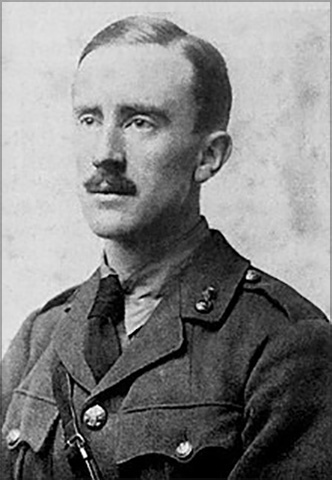
Tolkien at the age of 24, 1916.
Tolkien volunteered in the British army and became a second lieutenant with the Lancashire Fusiliers. His training at the 13th battalion at Cannock Chase, Staffordshire lasted eleven months. He was then transferred to the 11th battalion of the British Expeditionary Force and arrived in France on 4 June 1916. During the Battle of the Somme, Tolkien was a liaison officer. He also participated in the Battle of Thiepval. On October 27, 1916, he was troubled by trench fever. Tolkien returned to England on November 8, 1916 as a war invalid. Many of his close friends, including fellow TCBS members Gilson and Smith, had been killed. Years later Tolkien said indignantly, that those who were looking for similarities between his books and the First World War were completely wrong.3 views

Tolkien at Oxford. In 1925 he was appointed Rawlinson and Bosworth Professor of Anglo-Saxon.3 views

‘Ordinary family’ man: Tolkien and Christopher napping together in backyard of Oxford home.2 views

Tolkien with his family, Edith and three of his four children in 1940.2 views

Tolkien outside Merton College, University of Oxford.1 view

Tolkien in the midst of his books in his office, Meriton College, Oxford in December 1955. Tolkien retired in 1959.3 views

Life-long lover of pipe smoking, Tolkien is quoted as saying: “Every morning I wake up and think good, another 24 hours’ pipe-smoking.”2 views
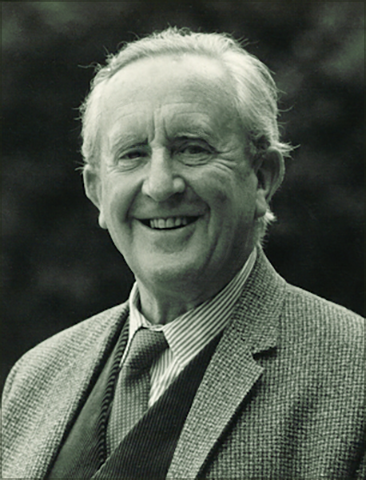
Tolkien ~1961, ‘the laughing philosopher’.2 views

Tolkien with Edith at their home on Sandfield Road, Oxford in 1966.3 views
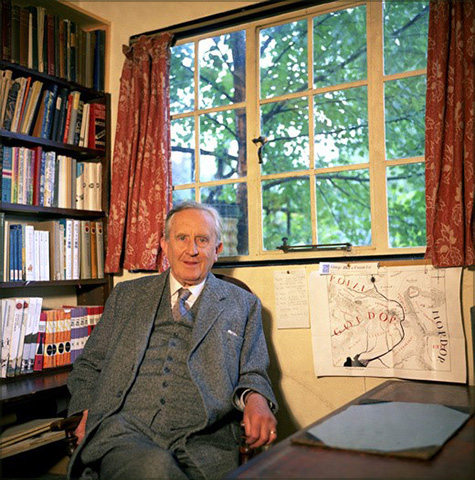
Tolkien photographed in his study at home in 1966, his map of Middle-earth on the wall.2 views

Tolkien sharing his Middle-earth joy with Edith.2 views

Tolkien at the seashore. Tolkien expressed a love for the sea, inspiring his words: ‘To the sea, to the sea! The white gulls are crying, The wind is blowing, and the white foam is flying. West, west away, the round sun is falling, Grey ship, grey ship, do you hear them calling, The voices of my people that have gone before me? I will leave, I will leave the woods that bore me; For our days are ending and our years failing. I will pass the wide waters lonely sailing. Long are the waves on the Last Shore falling, Sweet are the voices in the Lost Isle calling, In Eressea, in Elvenhome that no man can discover. Where the leaves fall not: land of my people forever!’4 views
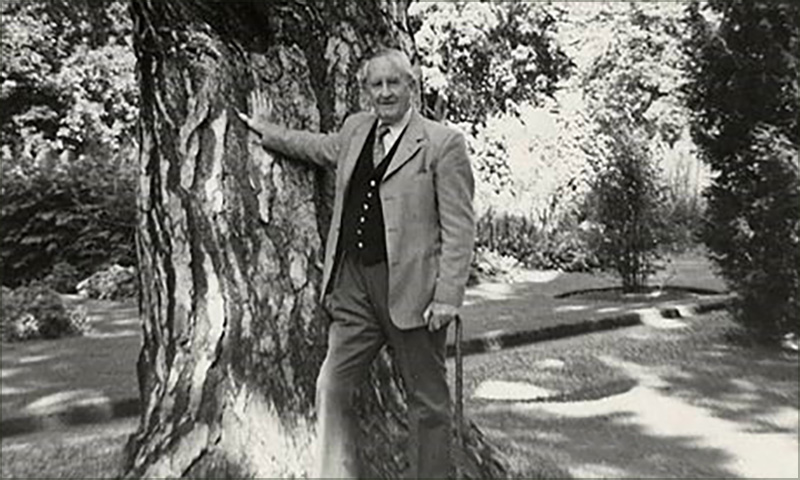
JRR Tolkien with the black pine in Oxford Botanic Garden.
Tolkien often sat and wrote beneath its branches. It is said, that its whirl-patterned bark inspired his creation of the Ents.
It is reported that the last photo of Tolkien before he died was of him standing with his hand on the trunk of this tree.2 views

And for the world, Tolkien's Middle-earth fantasy came into 'being' with the first publication of (as pictured) the 1937 The Hobbit, George Allen & Unwin, London. featuring Tolkien's own 'Mountains and Dragon' design.2 views
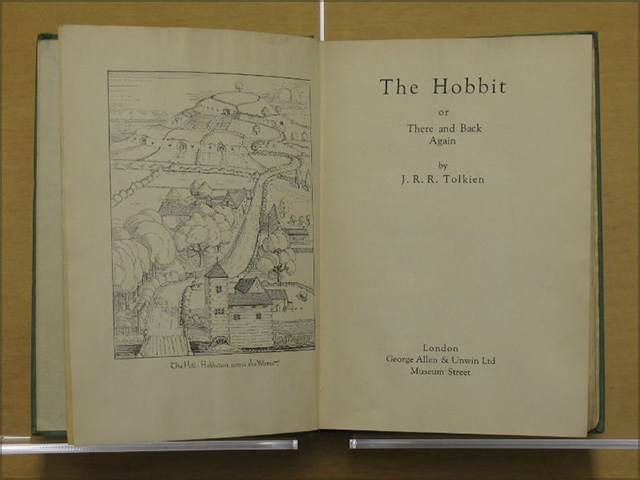
Frontispiece of Tolkien's The Hill: Hobbiton across the water and nine other of his illustrations in black and white.2 views
![Nearly three decades after Tolkien's death, another visionary took his words and imagery and transposed them into film.
<br/><br/>
In true Tolkien fantasy-style, they have been depicted as meeting at Bag End [Javier Gonzalez, PSC] <div/><span class="ngViews">3 views</span>](https://www.lotrarts.com/../images/gallery/showcase/jrr-tolkien/jrr-tolkien-bio-018.png)
Nearly three decades after Tolkien's death, another visionary took his words and imagery and transposed them into film.
In true Tolkien fantasy-style, they have been depicted as meeting at Bag End [Javier Gonzalez, PSC]
3 views
Roger Garland dedication
by YB
My heartfelt thanks to Linda Garland for her contribution to this dedication to Roger and permission to use the copyrighted images of Roger’s art.
Roger Garland: beloved illustrator of Middle-earth, bringing to life J.R.R. Tolkien's world and words.

links under construction
Acknowledgements:
1. Lakeside-Gallery.com ✦
2. CouncilOfElrond.com ✦
3. CouncilOfElrond.com Interview ✦
4. Kontu.wiki ✦
5. TolkienBooks.net ✦
6. TolkienGuide.com ✦
7. TolkienGateway.net ✦
9. TolkienSociety.org ✦
10. Aminoapps.com ✦
11. Roger Garland (facebook) ✧
12. Fee.melusine.free.fr ✦
 links under construction
links under construction
Most of the images to be found in this article especially Mr. Howe’s published illustrations were borrowed from Mr. Howe’s own website without which this tribute to his Middle-earth art would not have been possible. His website may be accessed here: https://www.john-howe.com/blog ✦
Readers are encouraged to visit Mr. Howe’s website where his entire portfolio of Tolkien and non-Tolkien fantasy illustrations is available for viewing for both English and non-English language publications. That portfolio may be accessed here: https://www.john-howe.com/portfolio/gallery/ and here: https://www.john-howe.com/portfolio/gallery/categories.php?cat_id=57
Another excellent source for information and images of John Howe’s illustrations may be found here: ‘'TolkienBooks.net – ‘An Illustrated Tolkien Bibliography’ - http://search.freefind.com/find.html?pageid=r&id=16257714&query=john+howe&ics=1&fr=0
Mr. Howe’s biographical data was copied from Wikipedia here: https://en.wikipedia.org/wiki/John_Howe_(illustrator)
Wikipedia also has a treasure trove on information regarding the contributions both Alan Lee and John Howe made in the Production design of The Lord of the Rings film series. That information may be accessed here: https://en.wikipedia.org/wiki/Production_design_of_The_Lord_of_the_Rings_film_seriesAdditional Biographical information may be accessed on ‘The Council of Elrond’ website here: http://www.councilofelrond.com/content/john-howe/
Another fine source for images of John Howe’s Tolkien art is ‘Tolkien Gateway’ which will be found here: http://tolkiengateway.net/wiki/Category:Images_by_John_Howe
All of John Howe’s Tolkien Calendar Illustrations may also be found at ‘Tolkien Gateway’:
1987 - http://tolkiengateway.net/wiki/The_1987_J.R.R._Tolkien_Calendar
1988 - http://tolkiengateway.net/wiki/The_1988_J.R.R._Tolkien_Calendar
1991 - http://tolkiengateway.net/wiki/The_1991_J.R.R._Tolkien_Calendar
1995 - http://tolkiengateway.net/wiki/J.R.R._Tolkien_Calendar_1995
1997 - http://tolkiengateway.net/wiki/Tolkien_Calendar_1997
2001 - http://tolkiengateway.net/wiki/The_Lord_of_the_Rings_Calendar_2001
2013 - http://tolkiengateway.net/wiki/Tolkien_Calendar_2013
Mr. Howe’s account of ‘The Great Art Robbery’ was found on his website here: https://www.john-howe.com/forum/smf/index.php?topic=1905.msg40994#msg40994
Peter Jackson’s ‘Foreword’, Sir Ian McKellen’s Gandalf text, and Alan Lee’s ‘Afterword’ may be found in John Howe’s ‘Myth & Magic – The Art of John Howe’ published by Harper Collins on December 1, 2001.
I would further encourage readers to read these fascinating and informative articles dealing with Mr. Howe’s contributions to Peter Jackson’s film trilogies:
‘The Lord of the Illustrations - How John Howe turns Tolkien’s words into film’ by Jo Fahy - https://www.swissinfo.ch/eng/culture/the-lord-of-the-illustrations_how-john-howe-turns-tolkien-s-words-into-film/41253038
In a magazine article titled ‘The Lord of the Rings: Chronicle of a foretold Masterpiece’ published in the French Magazine ‘Mad Movies’ (No. 125) on May 27, 2000, John Howe is interviewed by Rafik Djoumi: http://archives.theonering.net/perl/newsview/8/959446433
‘Meet the man who remade Middle-earth’ – John Howe interviewed by Ethan Gilsdorf May 26, 2014: https://boingboing.net/2014/05/26/meet-the-man-who-remade-middle.html
‘The Hobbit – A Surprising Journey From Middle-earth, the Middle East to the Canadian West!’ – John Howe interviewed - In Arts, News by Laura Goldstein https://mashumashu.com/the-hobbit/#
1 view

views

Born 28 February 1950, Roger grew up in Somerset but lived all his life in Cornwall.
He went to the Plymouth Art School and then Wolverhampton College of Art and Design, where he obtained a degree in Graphic Design.
Roger also taught Art for ten years in Poltair School in Cornwall, establishing a career as an illustrator.
Tolkien’s publishers commissioned Roger in 1981 to illustrate the book cover of Unfinished Tales. He continued to work on Tolkien titles, cover and storyboard illustrations throughout the 1980s and early 1990s. In particular, the cover illustrations for The Hobbit, The Lord of the Rings, The Silmarillion and The History of Middle-earth. Roger has also illustrated The Adventures of Tom Bombadil, Farmer Giles of Ham, and Smith of Wootton Major , with his artwork also featuring in Tolkien calendars in 1984 and 1989.
Roger commented in the Council of Elrond interview (reproduced below):
'I love Farmer Giles of Ham for Tolkien’s observation of rural life and humour.'
In addition, Roger has created a number of original sketches and oils, several etchings for Allen and Unwin publishers, and with Linda, contributed artwork to several Tolkien postcard books, eg Tolkien Bestiary.
In 1989, he co-founded with his wife Linda (who has a degree in Fine Arts and is also a professional artist interpreting Arthurian and Celtic legend) the Lakeside Gallery http://www.lakeside-gallery.com/ (described by Jano, The Dream Worlds, Tolkien’s Arda: ‘as tucked away off the main drag between Saltash and Launceston’).
This gallery features a permanent exhibition of Roger’s Tolkien-related paintings and drawings, with over seventy paintings and drawings commissioned by the original publishers for many of J.R.R. Tolkien's books. views

3 views

2 views

In April 1994 Roger was bestowed honorary membership of The Tolkien Society and in 2007 he was the guest of honour at its Annual Dinner in Plymouth.
Roger in the Council of Elrond interview:
' I am pleased to have illustrated Tolkien’s world before the films as I am sure from now on everyone will be influenced by Peter Jackson’s interpretation'
In recent years, Roger had moved away from illustrating other’s books and inspired by Pre-Raphaelites and French symbolists original artwork to complement Linda’s fantasy and Goddess paintings
Tragically Roger died on 26 October 2017 after a three-year battle with motor-neurone disease
Linda announced this sad news: 'This killer disease came into his life like a thief and systematically and mercilessly robbed him of all the things he loved doing. My heart is broken.'
Middle-earth art influences and style
There have been many influences on Roger’s art, the most significant are highlighted.
✦ Roger’s life in Cornwall, where he was inspired by the desolate cliffs and hills of Tintagel, the mythical home of King Arthur, Roger: 'Living in Cornwall near Tintagel the seat of King Arthur and the whole region steeped in mythology also fires my imagination.'
✦ Roger’s personal creativity and imagination fueled by a remarkable ability to visually materilize fantasy worlds and beings, bringing them vivdly alive
✦ Roger revered the art of French symbolists and pre-Raphaelites.
✦ Roger ‘absorption’ of the imagery of Tolkien’s words and his art. Roger had steeped himself in all things Middle Earth and his art was largely modelled by Tolkien's own vision of his fantasy world and his high-stylised artistic style. To ensure this, Tolkien’s publisher on commissioning Roger, gave him art samples of how Tolkien ‘saw’ characters.
As a remarkable insight into Roger’s influences, with the kind approval of Linda Garland, an exclusive interview Roger had with Council of Elrond (by k) has been reproduced below (ref: http://www.councilofelrond.com/content/exclusive-garland-interview/)
1. When did you first read Tolkien and what scenes have particularly inspired you?
'I first read Tolkien in the 60’s when I was an Art student. No particular scenes inspired me but I found the whole of Tolkien’s world inspirational.'
2. Which is your favourite of Tolkien’s books and why?
'The Lord of the Rings would be my favourite book for its scale and vision. However there are great images within The Silmarillion, The Unfinished Tales and The Book of Lost Tales. I love Farmer Giles of Ham for Tolkien’s observation of rural life and humour.'
3. What are your artistic influences, especially in relation to your Tolkien art?
'My main influences as an illustrator would be the pre-Raphaelites, and French Symbolist painters, many painted scenes from mythologies and legends. Living in Cornwall near Tintagel the seat of King Arthur and the whole region steeped in mythology also fires my imagination.'
4. What do you think it is about Tolkien’s works that makes so many artists want to draw scenes from them?
'I think many artists are attracted to Tolkien as a source of inspiration as he creates such a visual world within the reader’s mind.'
5. As I’m sure you gathered, my favourite of all your middle earth art is the Earendil and Elwing painting. Which of your pieces is your favourite and why?
'I have one or two I am particularly proud of, The Lord of The Nazgul, The Battle of the Pelennor Fields, and The Last Journey of Boromir. I am pleased to have illustrated Tolkien’s world before the films as I am sure from now on everyone will be influenced by Peter Jackson’s interpretation.'
6. I am aware your artwork has been used for Tolkien calendars and book covers and you have also illustrated Farmer Giles of Ham, Smith of Wootton Major and The adventures of Tom Bombadil, has your art been used for anything else, such as collectable cards or Tolkien art books?
'My wife, Linda who is a professional painter had several of her illustrations published inThe Tolkien Bestiary. We set up our publishing company and art galleries during the 80’s and publish many art cards and limited edition prints of our artwork including images from our Tolkien Collection. I have created forty oil paintings and many black and white drawings and etchings for the original publishers Allen and Unwin which we have retained and which forms a permanent exhibition at our Lakeside Gallery, Lezant.'
7. Can you tell me a little about the process of your art, from idea to final piece?
'From thumbnail sketches I create full size detailed drawings, which are mainly drawn from my imagination. I may find photographs of landscapes which I use as inspiration but never copy I basically use them to create an atmosphere. The drawings would then be sent to Christopher Tolkien for his approval and comments once given the “go ahead” I would proceed to produce the final artwork in oils.'
8. Are there any of your pictures you would like to comment on specifically, for instance the reason you drew it the way you did?
'The image of Old Man Willow I created from my childhood memories of living on the Somerset Levels.'
9. Which of your images did you find the hardest to draw?
'I must admit most of my Tolkien work just flowed. It was getting to the stage as an illustrator where I could do justice on paper what I could see in my head, that was the struggle, learning the skills meant many years of practice and observing how the Old Masters went about composition etc.'
10. Did you enjoy the films?
'Yes.'
11. And of course the most important question. When can we expect any further Tolkien art from you and can you tell us anything about what you are planning?
'I regret, I have moved on from illustration and now paint for myself. I am working on Italian landscapes, inspired by touring holidays yet they still have the “Other Worldly” escapism I guess one of my trademarks.' views

Remembering Roger
Through the tributes about Roger, he will be remembered not only as an exceptionally talented artist but as a wonderful husband, friend and inspiration to others.
As expressed by Linda: 'What you must keep in mind…is that Roger’s sense of humour and fun ran through his life like a river, he was completely self-deprecating and these are the characteristics that we as a family miss so deeply.'
Linda kindly provided the following personal anecdote regarding Roger and his work on The Lord of the Rings artworks.
'Professor Christopher Tolkien (the son of the author and representative for the Tolkien Estate) was responsible for the accuracy of all the illustrations for the book covers and calendars. The commissioned illustrators were obviously allowed artistic licence but had to adhere to the imaginative content of the text without deviation.
As a result Professor Tolkien's brief to Roger was to concentrate more on the landscapes mentioned in the books and leave the descriptions of the main characters to the discretion of the reader.
The exception was Gandalf, illustration for the 1984 Tolkien Calendar.
Professor Tolkien supplied Rog with a postcard of Der Berggeist (The Mountain Spirit).
A painting by Josef Madlener. His father based Gandalf on the subject of the painting and wanted Rog to use it as his starting point.
My lovely husband freely admitted that human figure work was never his strong point.
"Lin, what can I do?"
"It's no use using the kids, " I said, "they are too young, as am I, use Doreen (Roger's mum) as a model ,we can dress her up in a cloak and hat sit her in the garden take some photos ,job done!"
Rog did the rough drawing sent it to Professor Tolkien and awaited the response.
Back came the rough drawing, very good concept, lovely irises, just one adverse comment, "Could you make Gandalf look less like someone's Grandmother?"
We all fell about, from that moment on Gandalf the Grey was always Gandalf the Gran.
'
Further as a testimony of Roger’s legacy for others is expressed beautifully by a dear life-long friend (Paul, Mo, and family/Dartington):
'May the long time sun shine upon you, all love surround you, and the pure light within you guide you all the way on (by Mike Heron).'

My personal interaction
YB
In my short association with Roger, where I was fortunate to be able to buy some of his extraordinary original book-cover preparatory pencil drawings, I found him to be a caring, gentle, gracious and generous person.
Roger leaves a legacy of inspiration through the person he was and the visions that became his art; these will always stand as symbols of his spirit.

John Howe showcase
by Kenneth Ditrich
Peter Jackson would reach out to two conceptual artists as he prepared to begin work on the Lord of the Rings film trilogy. His choice for the two conceptual artists he would rely upon to help him bring J.R.R. Tolkien’s world and words to life should come as no surprise to anyone. Both artists have long been considered by most art critics to be the premier Tolkien Middle-earth illustrators of their time. I am speaking, of course, of Alan Lee and John Howe.
This is John Howe’s recollection of the phone call he received from Peter Jackson in 1998: “It was the middle of the night in Switzerland and someone named Peter Jackson called from New Zealand to say he was bringing Tolkien’s classics to the screen. I didn’t even know who he was then. My wife Fataneh and son Dana and I packed up so fast (including Howe’s extensive collection of 15th Century Italian armour and swords) and when I arrived at Peter’s studio, 3 Foot 6 in Wellington, I saw all my previous Tolkien illustrations tacked up on his wall!”
In an earlier article I authored for this LOTR Arts website, I endeavored to provide a fairly comprehensive presentation of the Tolkien related work of Alan Lee. That presentation included a look at Alan Lee’s published LOTR illustrations on book covers, dust jackets, box sets, and calendars. Afterward, I attempted to provide some insights on Alan Lee’s participation in the production of the Peter Jackson trilogies – both the Lord of the Rings and The Hobbit. I concluded my article on Alan Lee with a look at his very own ‘The Lord of the Rings Sketchbook’ released by Harper Collins on September 5th, 2005. Alan’s sketchbook included a vast treasure trove of his LOTR drawings and paintings. These images proved so powerful, matching perfectly with Tolkien’s own vision, that they would eventually define the look of Peter Jackson’s LOTR movie trilogy and earn Alan a coveted Academy Award for Best Art Direction in 2004.
It will be the goal of this article to take a look at the portfolio of Tolkien related art John Howe created which would also draw the attention of Peter Jackson. This portfolio would inevitably lead to his being recruited to work along side of Alan Lee as the main conceptual artists for the LOTR and Hobbit film trilogies. Because this LOTR Arts website is specifically dedicated to art related to the writings of J.R.R. Tolkien, I will refrain from including any references to Mr. Howe’s artistic endeavors not originating from the writings of J.R.R. Tolkien. While Mr. Howe’s Tolkien illustrations have appeared in and on publications in practically every language known to man, for purposes of this article, I will confine my presentation of Mr. Howe’s work to English language publications only. I would encourage all those interested in viewing Mr. Howe’s non-Tolkien related art as well as his illustrations in non-English language publications to visit Mr. Howe’s own website: http://www.john-how.com

views
![[spacer]](https://www.lotrarts.com/../images/gallery/showcase/john-howe/01-howe-001bb.png)
[spacer]

Biography from Wikipedia:
“John Howe was born on August 21, 1957 in Vancouver BC, Canada. He began drawing from pre-school age with help from his mother. Around primary school age he found his mother's ability no longer living up to his expectations, and even got frustrated once at both his mother and himself at not being able to draw a cow to his expectations. Howe's school years were complicated by moves which took place with a timing that left the art classes full, and left him in classes like power mechanics. He did find his ability as a draughtsman to be profitable in biology class though, where he and a friend would produce renderings of microscopic organisms for classmates at fifty cents each. As a child, he collected the covers of paperbacks. His collection included items from Frank Frazetta, Barry Smith, and Bernie Wrightson. In his adolescence, Howe read The Lord of the Rings trilogy by J.R.R Tolkien. He said he got "a real spark" from the Hildebrandt calendars, which showed him that the books could be illustrated. Howe made drawings of his own versions of the scenes depicted in the calendar. These drawings, according to Howe, may not have survived.
A year after his high school graduation, Howe found himself in Strasbourg, France attending college. The following year, he enrolled into the École des arts décoratifs. He cites his experience of this period as follows:
The first year was spent not understanding much, the second at odds with what I did manage to understand, and the third eager to get out, although in retrospect I certainly owe whatever clarity of thought I possess to the patience of the professor of Illustration.
Throughout his first years in Europe, Howe was taking in as much as he could in the way of art, architecture and everything that was "simultaneously ancient and novel." He says the only piece of his art work that survived from this period is his "The Lieutenant of the Black Tower of Barad-dur”, a piece inspired by Tolkien's The Lord of the Rings. He says if this is not his first published piece, it must certainly be the earliest. Howe's earliest commissions included political cartoons, magazine illustrations, comics, animated films, advertising, of which he says were nightmares. He said that he would end up redoing sketches so many times that there was nothing left of "his" in them. This frustrated him, and he wondered how he would ever make it in the profession.”

The Lieutenant of the Black Gate 1979
views

"Originally done as a school project, I actually cut the figure out and glued it onto the background. (I find it hard to believe that the whole thing is still intact.) It is actually my first piece of Tolkien-related work to be published, appearing in the 1987 Tolkien Calendar with a somewhat startling green background and on the video game from Melbourne House." - John Howe

The Tolkien Calendar 1987
Unwin Paperbacks
1986
ISBN 0 04 529010 5
views

War in Middle-Earth video game
Melbourne House
1985
views
![[spacer]](https://www.lotrarts.com/../images/gallery/showcase/john-howe/01-howe-004aa.png)
[spacer]

"I had originally labeled this image "The Lieutenant of the Black Gate", but very recently stumbled on my notes (which fill the margins of my dog-eared, heavily annotated copies of The Lord of the Rings that I had in art school) and now realize that it was the Witch King that I had in mind while doing it." - John Howe

Though there were many ways to display this prodigious work of art, for ease of reference and enjoyment, it will be presented as artwork images (by title) with the bookcovers (images and details from http://www.tolkienbooks.net/ ) and some brief commentary.
5 views

It is just unfathomable to think that John Howe might have harbored some doubt as to whether or not he would be successful as an illustrator. Of course, it is easy to make such a statement now knowing full well all the success he has enjoyed as one of the premier Tolkien illustrators of our time. Perhaps this would be a good opportunity to take a closer look at some of those successes.
John Howe’s Published Illustrations:
Book Covers, Dust Jackets and Box Sets Illustrated By John Howe For The Hobbit and The Lord Of The Rings
The Hobbit-

The Hobbit
J. R. R. Tolkien
Grafton Books Centenary edition - Paperback
September 1991 - ISBN : 0-261-10221-4
“This was my very first commission for an actual book cover for one of Tolkien's books.” - John Howe views

Mr. Howe’s Smaug illustration would also grace the cover of:
The Hobbit or There and Back Again
J. R. R. Tolkien
HarperCollinsPublishers
January 1999
ISBN 0-261-10221-4

The Lord of the Rings-
Publishers – Grafton Books, Harper Collins, Ballantine Books, Collins Modern Classics

The Fellowship of the Ring – Hard Cover Dust Jacket
J. R. R. Tolkien
Grafton Books
September 1991
ISBN 0-048-23045-6

The Fellowship of the Ring - Paperback
J. R. R. Tolkien
Grafton Books
September 1991
ISBN : 0-261-10235-4


The Two Towers – Hard Cover Dust Jacket
J. R. R. Tolkien
Grafton Books
September 1991
ISBN 0-048-23046-4

The Two Towers - Paperback
J. R. R. Tolkien
Grafton Books
September 1991
ISBN : 0-261-10236-2


The Return of the King - Hard Cover Dust Jacket
J. R. R. Tolkien
Grafton Books
September 1991
ISBN 0-048-23047-2

The Return of the King - Paperback
J. R. R. Tolkien
Grafton Books
September 1991
ISBN : 0-261-10237-0

The Lord of the Rings
One Volume Centenary Edition - Paperback
J. R. R. Tolkien
Grafton Books
1992
ISBN - 0-241-16243-5

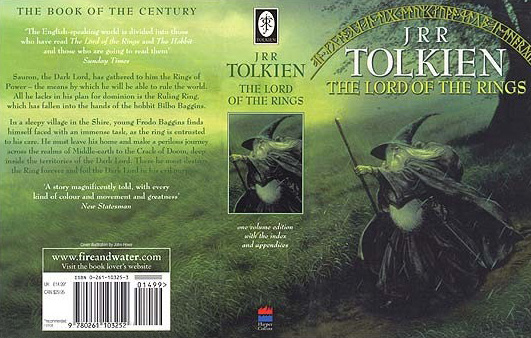
The Lord of the Rings – Hard Cover Dust Jacket
by J. R. R. Tolkien
HarperCollins, 2003

The Lord of the Rings
by J. R. R. Tolkien
HarperCollins, 2003
”Yet another edition of the one-volume edition, but with lettering resembling the film logo and a good reproduction of Gandalf, thanks to a colour transparency rediscovered in the HarperCollins archives.
Compared with "Gandalf the Green" of the previous edition, this cover is far superior.” – John Howe

Back of Box

Spines

Left Side of Box

Right Side of Box

The Lord of the Rings Part 1: The Fellowship of the Ring Paperback
J. R. R. Tolkien
Ballantine Books, New York
ISBN: 978-0-345-33970-6
Paperback, 462 pages

The Lord of the Rings Part 2: The Two Towers Paperback
J. R. R. Tolkien
Ballantine Books, New York
ISBN: 978-0-345-33971-3
Paperback, 402 pages

The Lord of the Rings Part 3: The Return of the King Paperback
J. R. R. Tolkien
Ballantine Books, New York
ISBN: 978-0-345-33973-7
Paperback, 494 pages


The Lord of the Rings by J. R. R. Tolkien
Part One: The Fellowship of the Ring
Collins Modern Classics
2001
ISBN 0-00-712970-


The Lord of the Rings by J. R. R. Tolkien
Part Two: The Two Towers
Collins Modern Classics
2001
ISBN 0-00-712971-8

The Lord of the Rings by J. R. R. Tolkien
Part Three: The Return of the King
Collins Modern Classics
2001

John Howe’s Published Illustrations:
Book Covers, Dust Jackets and Box Sets Illustrated By John Howe For ‘The Book of Lost Tales’, ‘The History of Middle-Earth’, ‘The Silmarillion’, and ‘Unfinished Tales’
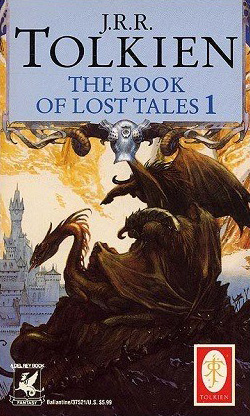
The Book of Lost Tales 1
Christopher Tolkien
Ballantine Del Ray
June 1992

The Book of Lost Tales 2
Christopher Tolkien
Ballantine/Del Ray
June 1992
ISBN 0-345-37522-X
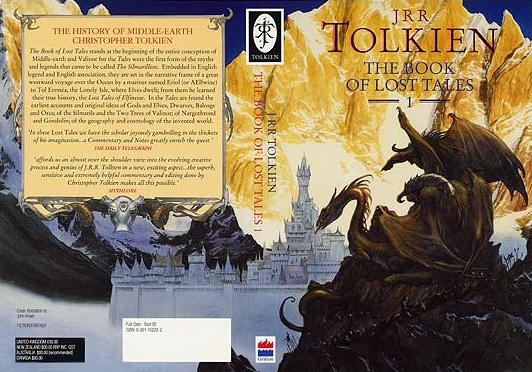
The Book of Lost Tales 1
The History of Middle-Earth: Volume 1
Christopher Tolkien
Harper Collins Publishers/Grafton Books
Sept 1992
ISBN 0-261-10225-7

The Book of Lost Tales 2
The History of Middle-Earth: Volume 2
Christopher Tolkien
Harper Collins Publishers/Grafton Books
Sept 1992
ISBN 0-261-10214-1

The Lays of Beleriand
The History of Middle-Earth: Volume 3
Christopher Tolkien
Harper Collins Publishers/Grafton Books
September 1992
ISBN 0-261-10220-5

The Shaping of Middle-Earth
The History of Middle-Earth: Volume 4
Christopher Tolkien
Harper Collins Publishers/Grafton Books
May 1993
ISBN 0-261-10225-7

The Lost Road and other writings
The History of Middle-Earth: Volume 5
Christopher Tolkien
Harper Collins Publishers/Grafton Books
May 24, 1993
ISBN 0-261-10225-7

The Return of the Shadow
The History of Middle-Earth: Volume 6
Christopher Tolkien
Harper Collins Publishers
October 1994
ISBN 0-261-10224-9

The Treason of Isengard
The History of Middle-Earth: Volume 7
Christopher Tolkien
Harper Collins Publishers
June 1995
ISBN 0-261-10220-6
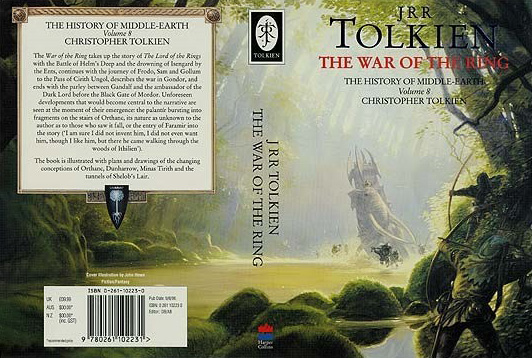
The War of the Ring
The History of Middle-Earth: Volume 8
Christopher Tolkien
Harper Collins Publishers/Grafton Books
August 9th 1993
ISBN 0-261-10223-0

Sauron Defeated
The History of Middle-Earth: Volume 9
Christopher Tolkien
Harper Collins Publishers
June 1995
ISBN 0-261-10305-9

Morgoth's Ring
The History of Middle-Earth: Volume 10
Christopher Tolkien
Harper Collins Publishers/Grafton Books
1993
ISBN 0-261-10300-8
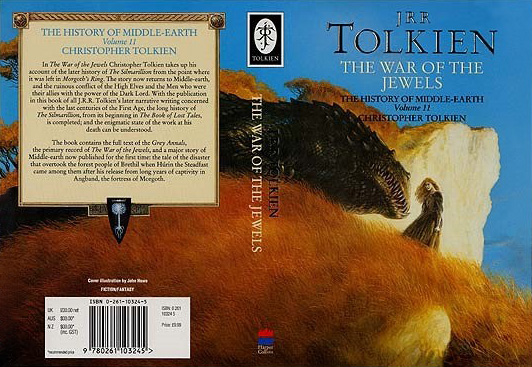
The War of the Jewels
The History of Middle-Earth: Volume 11
Christopher Tolkien
Harper Collins Publishers
June 1995
ISBN 0-261-10324-5

The Peoples of the Middle-Earth
The History of Middle-Earth: Volume 12
Christopher Tolkien
Harper Collins Publishers
August 18, 1997
ISBN 0-261-10348-2

The Lays of Beleriand by Christopher Tolkien
Volume 3 of the History of Middle-Earth
Del Ray Fantasy
ISBN 0-345-38818-6

The Lays of Beleriand
The History of Middle-Earth
J.R.R. Tolkien
Ballantine Books
2003
ISBN - 0-345-38818-6

The Lost Road by Christopher Tolkien
Volume 5 of the History of Middle-Earth
Del Ray Fantasy

The Lost Road and Other Writings
The History of Middle-Earth
J.R.R. Tolkien
Ballantine Books
2003
ISBN - 0-345-40685-0
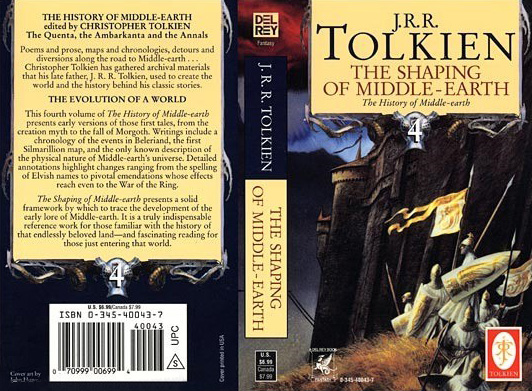
The Shaping of Middle-Earth, by Christopher Tolkien
Volume 4 of the History of Middle-Earth
December 1995 – Del Ray Fantasy
ISBN - 0-345-40043-7

The Shaping of Middle-Earth
The History of Middle-Earth
J.R.R. Tolkien
Ballantine Books
2003
ISBN - 0-345-40043-7
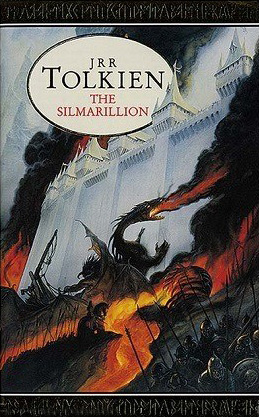
The Silmarillion - Paperback
J. R. R. Tolkien
Grafton Books
January 1992
ISBN : 0-261-10273-7

Unfinished Tales
Edited by Christopher Tolkien
Harper Collins Publisher

Unfinished Tales – Hard Cover
Christopher Tolkien
Harper Collins Publishers
ISBN : 0-261-10215-X

Unfinished Tales - Paperback
J. R. R. Tolkien
Harper Collins/Grafton
1993
ISBN - 0261-10216-8

Unfinished Tales - Paperback
Edited by Christopher Tolkien
Harper Collins Publishers
ISBN - 0-261-10362-8

The History of The Lord of the Rings boxed set:
The Return of the Shadow, The Treason of Isengard, The War of the Ring & Sauron Defeated
Edited by Christopher Tolkien
Harper Collins Publishers
October 1998
ISBN - 0-261-10370-9

The History of Middle-Earth Volume 1: The Book of Lost Tales I
J. R. R. Tolkien
Harper Collins Publishers
2001
ISBN - 0-261-10222-2

The History of Middle-Earth Volume 2: The Book of Lost Tales II
J. R. R. Tolkien
Harper Collins Publishers
2001
ISBN - 0-261-10214-1

The History of Middle-Earth Volume 3: The Lays of Beleriand
J. R. R. Tolkien
Harper Collins Publishers
2001
ISBN - 0-261-10226-5

The History of Middle-Earth Volume 4: The Shaping of Middle-Earth
J. R. R. Tolkien
Harper Collins Publishers
2001
ISBN - 0-261-10218-4

The History of Middle-Earth Volume 5: The Lost Road and Other Writings
Language and Legend Before The Lord of the Rings
J. R. R. Tolkien
Harper Collins Publishers
2001
ISBN - 0-261-10225-7

The History of Middle-Earth Volume 6: The Return of the Shadow
The History of the Lord of the Rings Part 1
J. R. R. Tolkien
Harper Collins Publishers
ISBN - 0-261-10224-9

The History of Middle-Earth Volume 7: The Treason of Isengard
The History of the Lord of the Rings Part 2
J. R. R. Tolkien
Harper Collins Publishers
2001
ISBN - 0-261-10220-6

The History of Middle-Earth Volume 8: The War of the Ring
The History of the Lord of the Rings Part 3
J. R. R. Tolkien
Harper Collins Publishers
2001
ISBN - 0-261-10223-0
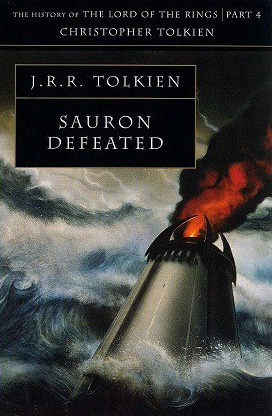
The History of Middle-Earth Volume 9: Sauron Defeated
The History of the Lord of the Rings Part 4
J. R. R. Tolkien
Harper Collins Publishers
2001
ISBN - 0-261-10305-9

The History of Middle-Earth: Volume 10 - Morgoth's Ring
Christopher Tolkien
Harper Collins Publishers
2001
ISBN - 0-261-10300-8

The History of Middle-Earth: Volume 11 - The War of the Jewels
Christopher Tolkien
Harper Collins Publishers
2001
ISBN - 0-261-10324-5

The History of Middle-Earth: Volume 12 - The Peoples of Middle-Earth
Christopher Tolkien
Harper Collins Publishers
2001
ISBN - 0-261-10348-2
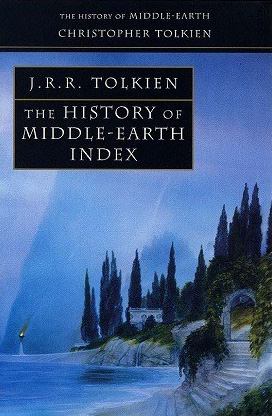
The History of Middle-Earth Index
J. R. R. Tolkien
Harper Collins Publishers
2001
ISBN - 0-00-713743-5

John Howe’s Tolkien Illustrations are likely to be found just about anywhere – on Board Games, Books with Pictures, Illustrated Books, Children's Books, Diaries, Maps, Tolkien Guides, Posters, Postcards, even Collectable Trading cards.

Lord of the Rings Board Game
Game by Reiner Knizia
Sophisticated Games, Cambridge
2000

LORD OF THE RINGS BOARD GAME – USA
Game by Reiner Knizia
Fantasy Flight
© 2000
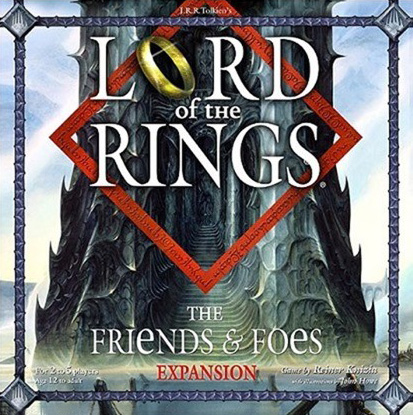
LORD OF THE RINGS BOARD GAME - FRIENDS AND FOES EXPANSION
Game by Reiner Knizia
Sophisticated Games Ltd. © 2001

LORD OF THE RINGS BOARD GAME: Friends & Foes Expansion - USA
Game by Reiner Knizia
Fantasy Flight Publishing, Roseville MN
2002

LORD OF THE RINGS BOARD GAME - THE SAURON EXPANSION
Game by Reiner Knizia
Sophisticated Games Ltd. © 2002

LORD OF THE RINGS BOARD GAME: Sauron Expansion - USA
Game by Reiner Knizia
Fantasy Flight Publishing, Roseville MN
2002

The Confrontation – USA
Fantasy Flight, Roseville MN
2002

Lord of the Rings Board Game – Second Edition
Game by Reiner Knizia
Sophisticated Games, Cambridge
2003

The Duel: Lord of the Rings two-player board game – USA
Peter Neugebauer
Rio Grande Games, Rio Rancho, NM
2003

Battles of the Third Age Board Game –USA
(Expansion for War of the Ring)
R. Di Meglio, M. Maggi & F. Nepitello
Fantasy Flight Games
2006

Books With Pictures:

Myth & Magic: The Art of John Howe
Harper Collins Publishers
December 3, 2001
ISBN 0-00-710795-1
144 pages
Foreword by Peter Jackson, afterword by Alan Lee, with texts by Sir Ian McKellan, Robert Holdstock, Robin Hobb and others.
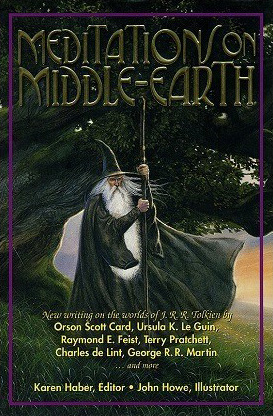
“Meditations on Middle-Earth”
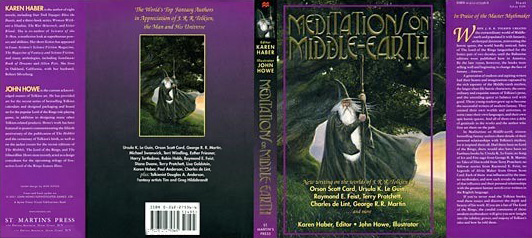
Meditations on Middle-Earth
Edited by Karen Haber
St. Martin's Press
October 1, 2001
ISBN - 0-31-227536-6
Hardcover (235 pages)

Meditations on Middle-Earth - Paperback
Edited by Karen Haber
St. Martin's Press
2003

Meditations on Middle-Earth - trade paperback
Edited by Karen Haber
Simon & Schuster/Earthlight
ISBN - 0-7432-3100-7

Illustrated Books and Children's Books:


The Hobbit
Three-Dimensional Picture Book
J. R. R. Tolkien
Harper Collins Publishers
1999
ISBN 0-99-136128-7

Smaug Awakens

Spiders of Mirkwood

The Battle of the Five Armies

Diaries and Maps:

The Lord of the Rings Tolkien Diary 2001
Harper Collins Publishers
2000
ISBN - 0-06-107-604-X


The Map of Tolkien's Beleriand and the Lands to the North
Text by Brian Sibley
Harper Collins Publishers
ISBN - 0-261-10372-5

The Map of Middle-Earth
Brian Sibley
Harper Collins Publishers
September 1994
ISBN 0-00-716970-1

The Maps of Tolkien's Middle-Earth
by Brian Sibley and John Howe
Harper Collins Publishers
ISBN 0-00-716970-1
September 2003
Slip Case

Slip Case: Front

Slip Case: Back

Cover of Brian's book; on the back is a detail of Bilbo's Front Hall (that fits in the cut-out of the slip case).
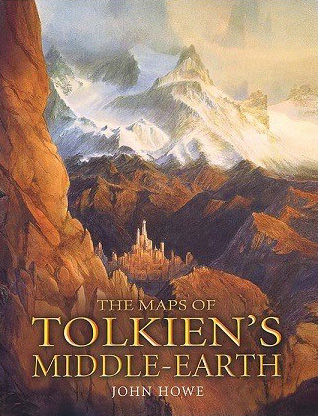
Cover of the map "book". On the back is a detail from the Map of Numenor.

The Tolkien Diary 1995
Harper Collins Publishers
July 11, 1994
ISBN - 0-26-110309-1

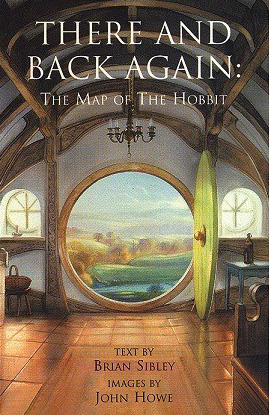
There and Back Again: The Map of the Hobbit
Brian Sibley
Harper Collins Publishers
April 3, 2000
ISBN-10: 0261103261
ISBN-13: 978-0261103269

Lord of the Rings Board Game Limited Edition Poster
Sophisticated Games
2001

Images of Middle-Earth: Six Paintings by John Howe
Second Edition
HarperCollinsPublishers
1999
ISBN 0-261-10310-5
ame Limited Edition Poster
Sophisticated Games
2001

The Complete Guide to Middle-Earth
Robert Foster
Harper Collins Publishers
September 1993
ISBN 0-261-10252-4

The Lord of the Rings:
A Reader's Companion
Wayne G. Hammond & Christina Scull
Harper Collins Publishers Ltd
March 3 2008
ISBN-10: 0007270607
ISBN-13: 978-0007270606
Trade Paperback
976 pages

The Road to Middle-Earth
How J. R. R. Tolkien created a new mythology
T. A. Shippey
Harper Collins Publishers
December 1, 1997
ISBN - 0-261-10275-3

1995 Tolkien Calendar Display Stand
Harper Collins Publishers
1994

The Tolkien Times
Harper Collins Publishers
October 1994

Tolkien Posters - Images of Middle-Earth
Six Paintings by John Howe
Harper Collins Publishers
1993
ISBN 2-26110310-5

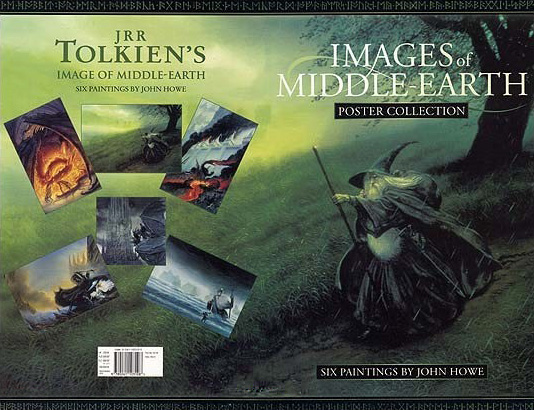
Images of Middle-Earth: Six Paintings by John Howe
Second Edition
Harper Collins Publishers
1999
ISBN 0-261-10310-5
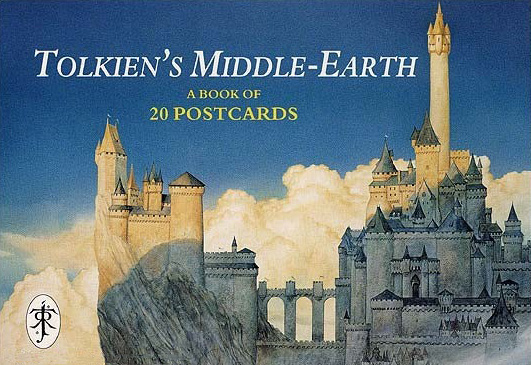
Tolkien's Middle-Earth
A Book of 20 Postcards
Harper Collins Paperbacks
1993
ISBN -0-261-10306-7

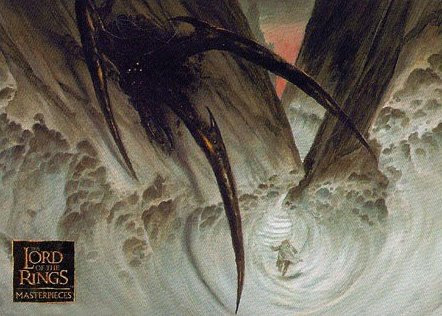
Topps LOTR Masterpieces I Collectable Card – Shelob

Topps LOTR Masterpieces I Collectable Card - Bag End

Topps LOTR Masterpieces I Collectable Card - Frodo & the Nazgul

Topps LOTR Masterpieces I Collectable Card - Minas Morgul (Front)

Topps LOTR Masterpieces I Collectable Card - Minas Morgul (Back)

Illustrated Tolkien Calendars:
John Howe is, of course, well known for his Tolkien calendars. He has had illustrations in parts of the 1987, 1988 and 2013 calendars. He has also produced entire calendars for the years 1991, 1995, 1997 and 2001.

1987 Unwin Hyman Ltd.
ISBN: 0-045-29010-5
"The Tolkien Calendar 1987" Illustrations by Alan Lee, Roger Garland, Ted Nasmith, and John Howe.
Cover: "The Lieutenant of the Black Tower of Barad-dur” by John Howe. Three months of this calendar – February, October and December were also illustrated by John Howe.

February – “The Black Rider” by John Howe

October – "The Lieutenant of the Black Tower of Barad-dur” by John Howe

December - "The Uruk-hai" by John Howe

1987 Ballantine Books (Random House)
ISBN: 0-345-33585-6
"The 1987 J.R.R. Tolkien Calendar" Illustrations by Alan Lee, Roger Garland, Ted Nasmith, and John Howe.
Cover - "The Black Rider" by John Howe
Three months of this calendar – February, October and December were also illustrated by John Howe.

February – “The Black Rider” by John Howe

October – "The Lieutenant of the Black Tower of Barad-dur” by John Howe

December - "The Uruk-hai" by John Howe

1988 Unwin Hyman Ltd.
ISBN: 0 04 823379 X
"The Tolkien Calendar 1988" Illustrations by Professor Tolkien, Ted Nasmith, John Howe, and Roger Garland.
Cover: "The Death of Smaug" by John Howe.
Three months of this calendar – February, September and October were illustrated by John Howe.

February – “The Great Goblin” by John Howe

September – “Smaug Attacks Laketown” by John Howe

October – “The Ravens” by John Howe

1988 Ballantine Books (Random House)
ISBN: 0-345-34637-8
"The 1988 J.R.R. Tolkien Calendar" Illustrations by Professor Tolkien, Ted Nasmith, John Howe, and Roger Garland.
Three months of this calendar – February, September and October were illustrated by John Howe.

February – “The Great Goblin” by John Howe

September – “The Death of Smaug” by John Howe

October – “The Ravens” by John Howe

1991 Ballantine Books (Random House)
ISBN: 0-345-36757-X
"The 1991 J.R.R. Tolkien Calendar" Illustrations by John Howe. Cover: "Old Man Willow".
John Howe illustrated all 12 months for this calendar.

January - "The Company of the Ring Approaching Caradhras”

February – “The Dark Tower”

March – “Sam and Shelob”

April – “Galadriel”

May – “Gandalf”
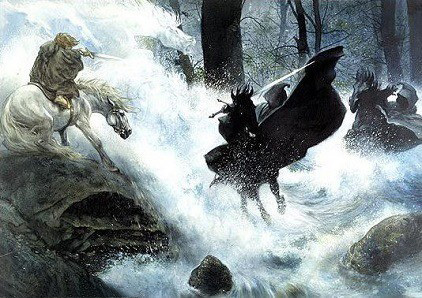
June – “At the Ford”

July – “Old Man Willow”

August – “The Death of Glaurung”

September – “Eowyn and the Nazgul”
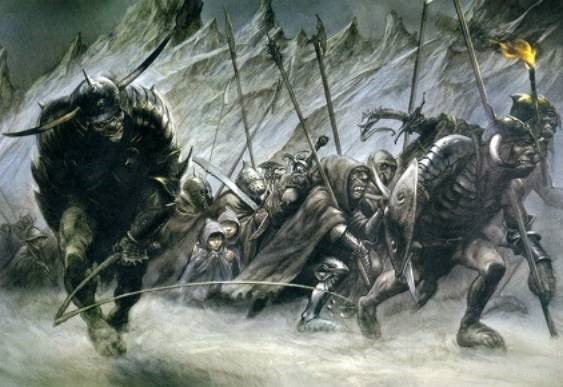
October – “In Mordor”

November – “Glorfindel And The Balrog”

December – Minas Tirith”

1991 Unwin Hyman Ltd.
ISBN: 0-04-440677-0
"The Tolkien Calendar 1991" Illustrations by John Howe. Curiously, the 10-digit ISBN is printed only above the barcode on the back of the mailer. On the back cover of the calendar itself, the barcode reports the 13-digit ISBN 9 780044 406778.
Cover: "At the Ford"
All 12 months feature illustrations by John Howe.

January – “Old Man Willow”

February – “In Mordor”

March – “Galadriel”
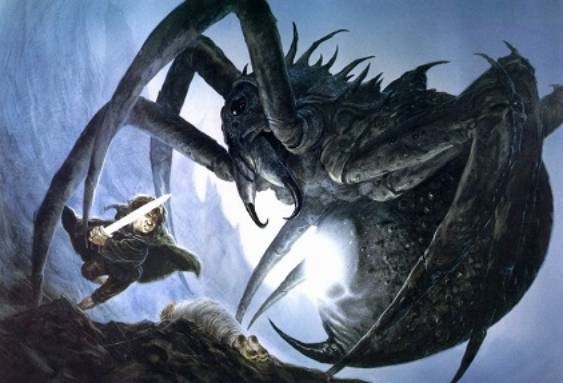
April – “Sam and Shelob”

May - "The Company of the Ring Approaching Caradhras”

June - “The Death of Glaurung”

July – “At The Ford”

August – “Minas Tirith”

September - “Glorfindel And The Balrog”

October – “The Dark Tower”

November – “Eowyn and the Nazgul”
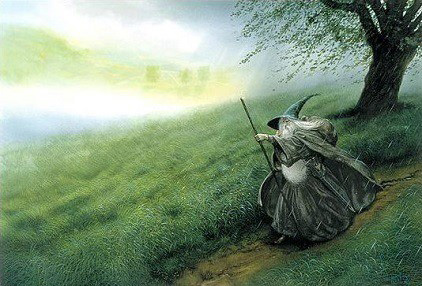
December – “Gandalf”

1995 Harper Collins
ISBN: 0-261-10308-3
"J.R.R. Tolkien Calendar 1995" Illustrations by John Howe.
Cover - "Gandalf Comes to the Guarded City"
All illustrations by John Howe.

January – “Smaug”

February - "The Battle for Gondolin”

March – “Gandalf Comes to the Guarded City”

April – “Gandalf Returns to Hobbiton”

May – “The White Tower of Elwing”

June – “The Door of Night”
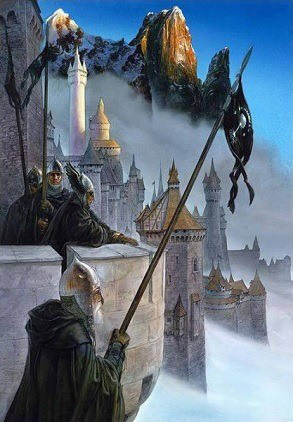
July – “Minas Tirith”

August – “The Fall of Gondolin”

September – “Ulmo, Lord of the Waters”

October - "Melkor and Ungoliante before the Two Trees”

November - "Fingolfin’s Challenge to Morgoth”

December – “The Siege of Angband”

1997 Harper Collins
ISBN (US/CAN): 0-06-105525-5
"Tolkien Calendar 1997" Illustrations by John Howe.
Cover - "There and Back Again: The Map of The Hobbit"

January – “Descent into Rivendell”

February – “An Unexpected Party”

March – “Edoras”

April – “The Mumakil of Harad”

May – Tolkien’s Middle-Earth”

June – “Treebeard”

July – “Bilbo's Front Hall”

August – “Nienor and Glaurung”
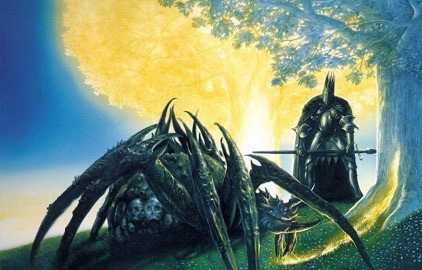
September – “Ungoliante and Melkor”

October – “The Drowning of Anadûné”

November – “Sir Gwain and the Green Knight”
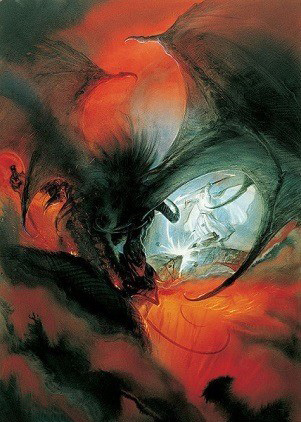
December – “Gandalf and the Balrog”
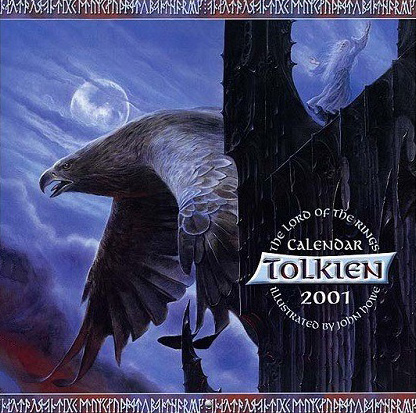
2001 HarperEntertainment
ISBN: 0-06-105852-1 (US/CAN); 0-261-10379-2 (UK/EUR)
“The Lord of the Rings Calendar Tolkien 2001
Illustrated by John Howe”
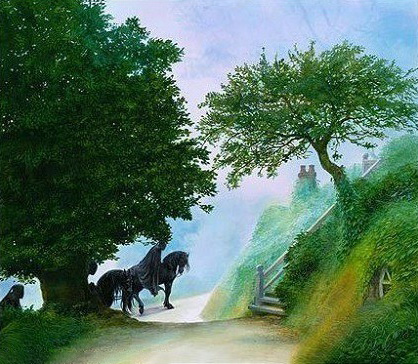
January – “Black Riders in the Shire”

February – “Gandalf Falls with the Balrog”
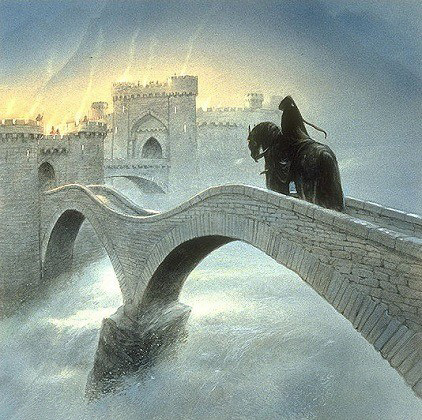
March – “Horseman in the Night”

April – “Gollum Flees the Elves of Mirkwood”

May – “Gwaihir Rescues Gandalf from Orthanc”

June – “The Argonath”

Centerfold – “Grond”

July – “The Bridge at Khazad-dum”

August – “Legolas and Gimli at Helm’s Deep”
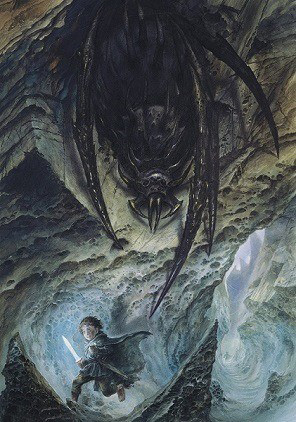
September – “Shelob About to Leap on Frodo”
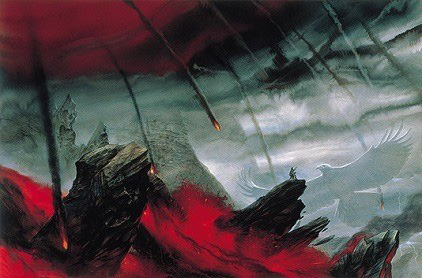
October – “The End of All Things”

November – “Zirak-zigil”

December – “The Grey Havens”

2013 Harper Collins
ISBN: (US/CAN) 978-0-06-220801-9; (UK/EUR) 978-0-00-748593-2
"TOLKIEN The Hobbit Official Calendar 2013 Illustrated by Alan Lee and John Howe" Illustrations by Alan Lee and John Howe. Features cover art by both illustrators on opposite sides of the calendar.
John Howe provided the illustrations for 6 months – January, March, May, July, September and November.
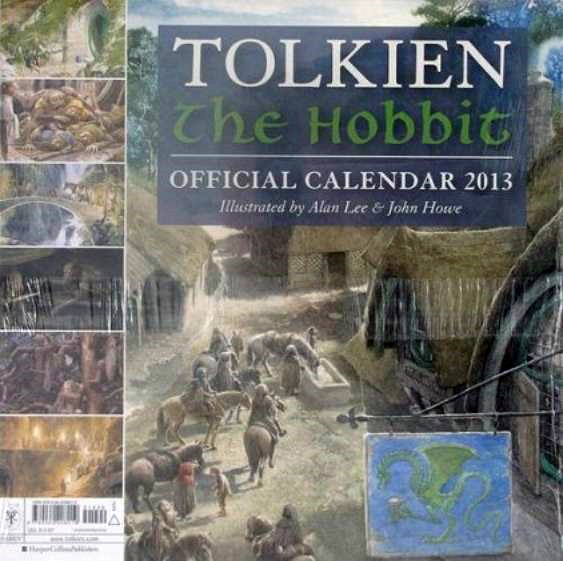

January – “Gandalf Returns to Hobbiton”

March – “Bilbo’s Front Hall”

May – “An Unexpected Party”

July – “The Great Goblin”

September – “Gwaihir's Eyrie”

November – Smaug Destroys Laketown”

John Howe also illustrated a number of CD and Audio Cassette recordings of J.R.R. Tolkien’s writings.

Highbridge Audio Collection: The Lord of the Rings & The Hobbit
J. R. R. Tolkien
2003

J R R Tolkien Collection: Part 1
Excerpts from the Hobbit. The Lord of the Rings & Poems and Songs of the Middle Earth
Harper Collins Audio Books
ISBN - 0-00-104273-4

J R R Tolkien Collection: Part 2
Excerpts from the Hobbit. The Lord of the Rings & Poems and Songs of the Middle Earth
Harper Collins Audio Books
ISBN - 0-00-104273-4

J.R.R. Tolkien reads excerpts from The Lord of the Rings and The Hobbit
Harper Collins Audio Books
1999
ISBN - 0-00-105626-3

Of Sorcerers And Men
Tolkien and the Roots of Modern Fantasy Literature
Portable Professor Arts & Literature
Taught by Michael D. C. Drout
Barnes & Noble Audio
October 2006
ISBN-13 : 978-0-7807-8523-2
ISBN-10 : 0-7607-8523-6
Teaching pack with 8 CD’s

J. R. R. Tolkien Gift Set
The Hobbit, The Fellowship of the Ring, the Two Towers, The Return of the King
BBC full-cast dramatization
Random House Audio
2003

Random House Audio: The Fellowship of the Ring - Cassette (Front)

Random House Audio: The Fellowship of the Ring - Cassette (Back)
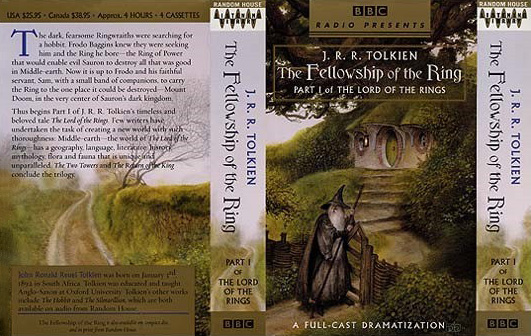
Random House Audio: The Fellowship of the Ring - Cassettes
The Fellowship of the Ring
Part I of the Lord of the Rings
J. R. R. Tolkien
BBC Radio Full-cast dramatization
2002
ISBN 0-7392-0139-X

Random House Audio: The Fellowship of the Ring - Cassettes (Front)
The Fellowship of the Ring
Part I of the Lord of the Rings
J. R. R. Tolkien
BBC Radio Full-cast dramatization
2002

Random House Audio: The Fellowship of the Ring – CD

Random House Audio: The Fellowship of the Ring - CD (Front)

Random House Audio: The Fellowship of the Ring - CD (Back)
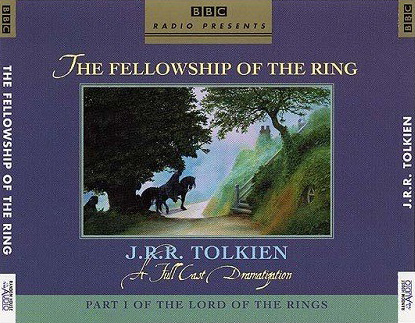
Random House Audio: The Fellowship of the Rings - CD (Jewel Case Front)
The Fellowship of the Ring
Part I of the Lord of the Rings
J. R. R. Tolkien
BBC full-cast dramatization
Random House Audio
2002
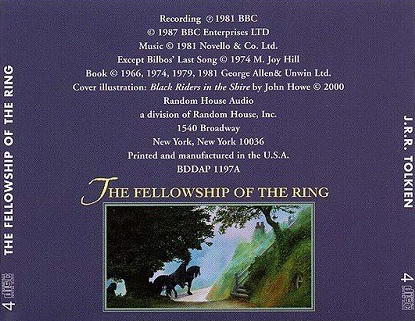
Random House Audio: The Fellowship of the Rings - CD (Jewel Case Back)

Random House Audio: The Hobbit - CD

Random House Audio: The Hobbit CD (Front)
The Hobbit
J. R. R. Tolkien
BBC Full-cast dramatization
Random House Audio Publishing
ISBN - 0-8072-8884-5

Random House Audio: The Hobbit CD (Back)

Random House Audio: The Hobbit - Cassettes (Front)
The Hobbit
J. R R. Tolkien
BBC Full-cast dramatization
Random House Audio Publishing
ISBN -o-8072-8883-7

Random House Audio: The Hobbit - Cassettes (Back)

Random House Audio: The Return of the King - CD

Random House Audio: The Return of the King – CD (Front)

Random House Audio: The Return of the King – CD (Back)

Random House Audio: The Return of the King - CD Jewel Case (Back)
The Return of the King
Part III of the Lord of the Rings
J. R. R. Tolkien
BBC full-cast dramatization
Random House Audio
2002

Random House Audio: The Return of the King – Cassettes (Front)

Random House Audio: The Return of the King – Cassettes (Back)

The Return of the King
Part III of the Lord of the Rings
J. R. R. Tolkien
BBC Radio Full-cast dramatization
2002
ISBN 0-7392-0139-X

Random House Audio: The Return of the King - Cassettes (Front)

Random House Audio: The Return of the King - Cassettes (Back)

Random House Audio: The Return of the King - Cassettes
The Return of the King
Part III of the Lord of the Rings
J. R. R. Tolkien
BBC Radio Full-cast dramatization
2002
ISBN 0-8072-0910-4

Random House Audio: The Two Towers - Cassettes (Front)
The Two Towers
Part II of the Lord of the Rings
J. R. R. Tolkien
BBC Radio Full-cast dramatization
2002
ISBN 0-8072-0907-4

Random House Audio: The Two Towers - Cassettes (Back)

Random House Audio: The Two Towers - Cassettes (Front)
The Two Towers
Part II of the Lord of the Rings
J. R. R. Tolkien
BBC Radio Full-cast dramatization
2002
ISBN 0-7393-0118-7

Random House Audio: The Two Towers - Cassettes (Back)

Random House Audio: The Two Towers – CD
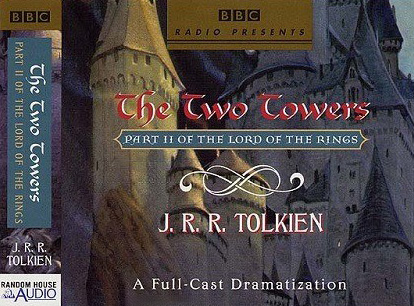
Random House Audio: The Two Towers - CD (Front)

Random House Audio: The Two Towers - CD (Back)

Random House Audio: The Two Towers - CD (Jewel Case Back)
The Two Towers
Part II of the Lord of the Rings
J. R. R. Tolkien
BBC full-cast dramatization
Random House Audio
2002

The Hobbit
J. R. R. Tolkien
Read by Martin Shaw
HarperCollinsAudioBooks
1993
ISBN - 0-00-104676-4

The Hobbit - CD Jewel Case
The Hobbit
J. R. R. Tolkien
read by Martin Shaw
HarperCollinsAudioBooks
ISBN - 0-00-710677-7

J.R.R. Tolkien
The Hobbit
BBC Audio English edition 1988
4 CD set – approximately 225 minutes
Der Hörverlag, Munich
ISBN 3-89940-465-X
2005

The Hobbit: Highbridge Audio Edition (Front)
The Hobbit: Highbridge Audio edition
American dramatized production - 4 compact discs
The Highbridge Company
© 2001

The Hobbit: Highbridge Audio Edition (Back)

The Lord of the Rings Part 1: The Fellowship of the Ring - Highbridge Audio Edition (Front)
The Lord of the Rings Part 1: The Fellowship of the Ring - Highbridge Audio Edition
Original American dramatized production - 3 compact discs
The Highbridge Company
© 2001

The Lord of the Rings Part 1: The Fellowship of the Ring - Highbridge Audio Edition (Back)
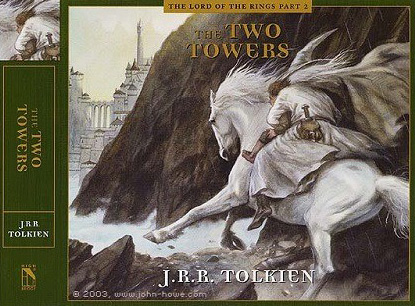
The Lord of the Rings Part 2: The Two Towers - Highbridge Audio Edition (Front)
The Lord of the Rings Part 2: The Two Towers - Highbridge Audio Edition
Original American dramatized production - 3 compact discs
The Highbridge Company
© 2001

The Lord of the Rings Part 2: The Two Towers - Highbridge Audio Edition (Back)

The Lord of the Rings Part 3: The Return of the King - Highbridge Audio Edition (Front)
The Lord of the Rings Part 3: The Return of the King - Highbridge Audio Edition
Original American dramatized production - 3 compact discs
The Highbridge Company
© 2001
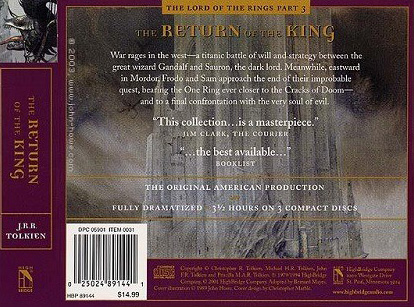
The Lord of the Rings Part 3: The Return of the King - Highbridge Audio Edition (Back)

The Great Art Robbery
No review of the portfolio of John Howe would be complete without a recounting of the Great Art Robbery which he was the victim of in 1997. His recollections of the incident have been recorded on his own website and may be viewed here: https://www.john-howe.com/forum/smf/index.php?topic=1905.0 Here in its entirety is his recorded statement.
”In 1997, during the night of May 18th to 19th, a person or persons broke in to the Médiathèque of Sedan (in the Ardennes region, near Belgium in north-eastern France) and stole 11 originals from an exhibition of my Tolkien illustrations. Not just a case of grab-and-run, the thief chose the ones he preferred, breaking the frames and glass, and stripping the matte boards, probably rolling up the originals.
A short while later, a couple of weeks I believe, the Mediathèque received an anonymous phone call from a man presenting himself as the thief's father. According to him, his son had stolen the originals, and he proposed to try and get them back if he could. The call was made from a café, the police weren’t able to find any witnesses.
A short time after that, once again a matter of days or weeks, a man presented himself at the Médiathèque and left a plain mailing tube with the receptionist, insisting that it be given to the director of the establishment. He phoned later the same day from another café (once again no witnesses) and explained that he had managed to retrieve 8 of the originals, but that the other three were at his "son's girlfriend's place". He promised to try to get them, but was not optimistic. That was the last he was heard of. End of story, or at least of that part. (What still puzzles me is the incredible lack of curiosity on the part of the receptionist, who was not even able to adequately describe the man who brought the mailing tube. One would think that given the circumstances, a stranger leaving an anonymous package for the director of the Médiathèque would have at least prompted her to try and find out a bit more, alert the director, try to pick up a license plate number, whatever...)
Of the eight originals returned, one was damaged beyond repair: the Minas Tirith painting from the 1991 Tolkien Calendar. The seven others had been rolled, had their edges and corners tattered and folded, and been generally ill-treated. One or two had candle wax on them, and to make things complete, the police who handled the affair had dusted them for prints - front and back - with a tenacious dark grey powder which took my wife and I days to remove before we were able to retouch the artwork itself. It was a pretty painstaking process. The Dark Tower, for instance, had been rained upon, and as well as being folded and battered, not to mention the fingerprint powder.
The remainingg three paintings were never recovered:
- Gandalf the Grey
- The Uruk-hai
- Eowyn and the Nazgul.
I won't bore you with the whole annoying business that is mandatory in these cases - talking to the police, wondering if the originals will ever be returned, wishing I could get my hands on the idiot who stole them...
It's all far in the past now, but I still wonder at the fundamental contradictions involved. Obviously a fan of the work, but why privilege theft over a visit to the show, knowing full well that stealing an artist's work is about the worst thing you can do to him short of destroying it on the spot. It's a mixture of callousness and admiration, thoughtlessness and devotion that I find difficult to comprehend.”

Only 5 of the 11 paintings stolen are identifiable from Mr. Howe’s testimony.

Of the 8 paintings returned, his Minas Tirith painting used in the1991 Tolkien Calendar was damaged and beyond repair.

Mr. Howe’s “The Dark Tower” was restored after a painstaking process.

These three paintings have never been recovered:

“Gandalf the Grey”

“The Uruk-Hai”

“Eowyn and the Nazgul”

Myth & Magic – The Art of John Howe
A short time after Christmas I took advantage of an Amazon gift card I was given for the holiday and acquired a hardcover copy of John Howe’s ‘Myth & Magic - The Art of John Howe’ first released by Harper Collins on December 1, 2001.
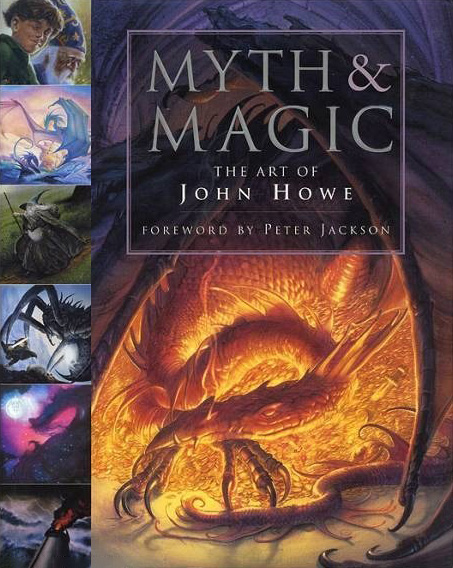
The following text is taken from the dust jacket that was wrapped around this hard cover volume:
“Artists the world over have attempted to capture the essence of Tolkien’s Middle-earth: the passion and heroism of the characters, the heart-stopping drama of the action, the mythic grandeur of Middle-earth itself, but few have succeeded. Pre-eminent among those who have is John Howe. Now, for the first time ever, a portfolio of more than 250 of his paintings and sketches has been collected together which celebrates the breathtaking vision of one of the foremost fantasy artists working today. Myth & Magic takes the reader on a journey through John Howe’s work, from his early days as a student to his most recent paintings, and features a number of previously unseen pictures.

All of his Tolkien work inspired by The Hobbit, The Lord of the Rings, The Silmarillion and The History of Middle-earth is included, and this is complemented by a dazzling array of the many works of art that he has produced, ranging from books on dragons and myth and legend, children’s books that he has written as well as illustrated, to a wealth of cover paintings for some of the biggest names in fantasy. John Howe has additionally provided an entertaining and informative commentary which gives the story behind his work.
Myth & Magic also boasts contributions from Tolkien expert and author of The Lord of the Rings Movie Guide, Brian Sibley, and top fantasy authors such as Robin Hobb and Robert Holdstock, features a revealing insight from Oscar-winning actor Sir Ian McKellen into the challenge of becoming John Howe’s ‘Gandalf’, and includes an exclusive Foreword by Peter Jackson, the director of The Lord of the Rings Movie Trilogy. From the beloved painting of ‘Smaug’ that decorates The Hobbit, and the world famous ‘Gandalf’ picture which is synonymous with the one-volume edition of The Lord of the Rings, to the spectacular images which adorn best-selling novels around the world, this sumptuous gallery will delight all fans of Tolkien and fantasy, as it takes us on an unforgettable tour through the imagination of one of the finest artists in the world. A tour through the realms of Myth & Magic.”
Viewing all 141 pages of this comprehensive collection of Mr. Howe’s Tolkien and non-Tolkien fantasy art more than compensated me for the purchase price of this incredible volume. An extra added bonus were the revealing insights this volume provided regarding Mr. Howe’s recruitment by Peter Jackson to help him bring Tolkien’s vision of ‘The Lord of the Ring’s’ to the silver screen. Here from the ‘Foreword’ he wrote for ‘Myth & Magic - The Art of John Howe’ are Peter Jackson’s own words explaining why John Howe was chosen to assist the director in making a film version of Tolkien’s masterpiece a reality by becoming one of the film’s two major conceptual artists. It is a decision I feel certain the director never regretted and undoubtedly had a great deal to do with the film’s success. I have taken the liberty of interspersing several of the John Howe paintings referenced throughout Peter Jackson’s text. These paintings are not actually shown in Peter Jackson’s ‘Foreword’ and have only been added in hope’s of increasing the reader’s appreciation and enjoyment.

FOREWORD
“I was a fan of John Howe’s work long before I met him.
Back in 1995, when Fran Walsh and myself were first thinking about making a film adaptation of The Lord of the Rings, we were inspired by John’s paintings in the 1991 Tolkien calendar. ‘Sam and Shelob’, ‘Eowyn and the Nazgul’ and ‘At the Ford’ all seemed like still images from a movie.

Sam and Shelob

Eowyn and the Nazgul

Flight to the Ford

Many of his paintings have that quality – capturing a frozen moment of high drama. They also have a reality to them – a sense of fantasy as history. They got us very excited about the visual possibilities that a film could offer.
I discovered that there was no single collection of John’s artwork, so we went on a ‘John Howe hunt’, trying to find every picture he’d done. It was tough, as they were scattered on dozens of book covers and calendars. The internet, second-hand bookshops and Tolkien societies were mined for any artwork by John. We’d buy a book if it had just one new painting. Eventually we used John’s artwork in presentations, trying to interest Hollywood in the idea of a Tolkien movie – and it worked because we got the money. Without his knowledge, he was already playing an important role in bringing The Lord of the Rings to cinematic life.
Sometime in 1997 I plucked up the courage to call John and ask him to work on the movies. I was a big fan by this time, and was nervous at the thought of speaking with him – but luckily I found him to be very gracious, with a wonderfully dry sense of humour. And that call resulted in John and his lovely family spending over 18 months in New Zealand. I’d always loved John’s paintings of Gandalf, and when I finally met him in person, I realized that he is Gandalf, literally – those paintings are self portraits of John with another 30 years added on!

Gandalf The Grey

Gandalf Returns to Hobbiton

Gandalf

Working along side Alan Lee as a conceptual artist and designer, John would come to work every day, sharpen his pencil and draw. Thousands of designs were produced, covering all the events and characters from The Lord of the Rings.
It was a lot of fun. I’d always loved John’s painting of the Bag End hallway, which I thought captured the perfect Hobbit hole. However, it was frustrating- for years I’d been staring at the picture wondering what the rest of Bag End looked like. I was now able to get him to draw it for me! Conversely, I realized that John had never painted Minas Morgul, so I asked him for his visions of the lair of the Witch-king – it was pretty amazing and went straight into the movie.

Bilbo’s Front Hall

Gandalf In The Shire

Gandalf Returns to Hobbiton

Minas Morgul

John’s artistic influence went beyond buildings and castles. His painting of Gandalf striding through the rain is the greatest illustration of Tolkien’s wizard I’ve ever seen – the tramp-like clothing and hawk-like gaze capture an intensity that goes way beyond the cliché of a pointy-hatted wizard. I naturally wanted our movie Gandalf to look exactly like that, which resulted in Sir Ian McKellen having to endure hours of make-up and wardrobe tests, with me waving John’s picture around saying ‘The hat’s not right yet – it has to look like this!’

Gandalf The Grey

John’s visual style has translated strongly on screen. In our movie version of The Fellowship of the Ring, it’s John’s Gandalf that arrives at John’s Bag End. Gandalf delights the Hobbits with John’s fireworks whilst, many miles away, John’s Barad-dur rises again above the Mordor landscape. And the movie Balrog that Sir Ian McKellen confronts in Moria is a first cousin to the beast you will see in these pages.

Gandalf In The Shire

Gandalf Returns to Hobbiton
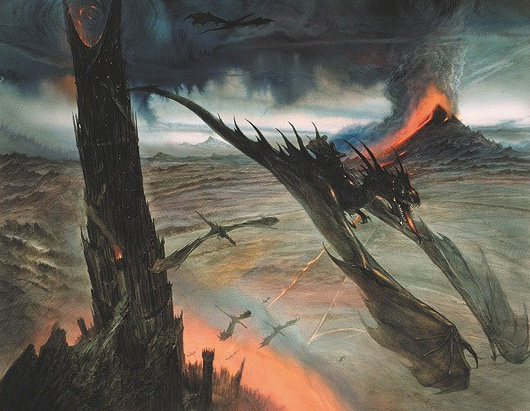
Barad-dur

Moria
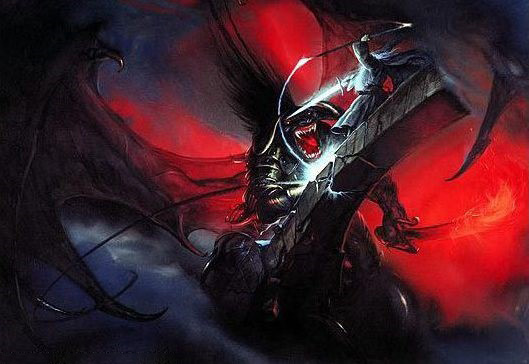
The Bridge of Khazad-dum

Gandalf and the Balrog
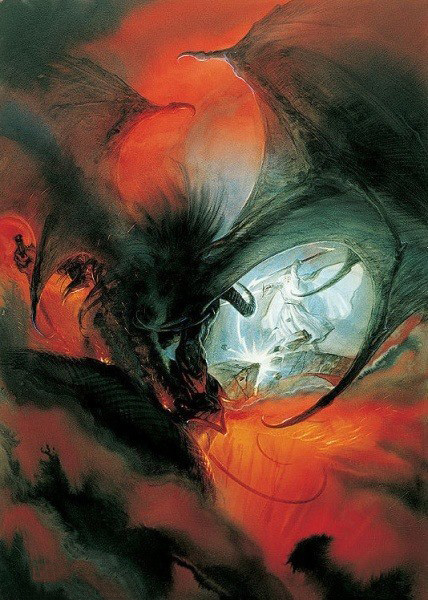
Gandalf and the Balrog

Gandalf Falls With The Balrog

A definitive collection of John Howe’s artwork in one volume is the book I dreamt of all those years ago… that one day I would be writing an introduction to such a book is more than a dream come true.”
Peter Jackson
Wellington, NZ

In his ‘Foreword’ to ‘Myth & Magic - The Art of John Howe, Peter Jackson wrote that John Howe’s signature painting of Gandalf striding through the rain was the greatest illustration he had ever seen of Tolkien’s wizard. High praise indeed! It was a look he was absolutely determined to duplicate in his films and as Peter Jackson explained, resulted in Sir Ian McKellen having to endure countless hours in make-up tests and wardrobe fittings until that look was achieved.
Sir Ian McKellen was gracious enough to author the short text shown below for ‘Myth & Magic - The Art of John Howe’. In his own words, Sir Ian confirms the inspiration for his appearance as Gandalf in the films was based primarily on John Howe’s painting of Gandalf the Grey. He also refers to the many hours he spent in make-up and wardrobe tests to achieve the look of John Howe’s Gandalf.
Gandalf The Grey
“Preparing to play Gandalf onscreen was initially no more troubling than getting to know any other character well enough to impersonate him. I had not read The Lord of the Rings and when friends cautioned that millions who had would be waiting to pounce if I contradicted their own image of the Wizard, I was comforted by my own experience of playing many classic parts already achieved and embodied by generations of actors. But, no one else had yet played Gandalf on screen and his adventures were the most popular fiction of my lifetime. Then, meeting the legion of insistent fans via the internet, I became less complacent.
In October 1999 I met the artistic team for the films in New Zealand and in the Wellington workshops sat through two days of make-up tests and costume fittings. I didn’t know quite what to expect but they were all clear enough – they consulted Tolkien’s descriptions and they propped John Howe’s illustration of Gandalf the Grey by the mirror. The author and his acclaimed illustrator were their guides and only when I looked like the John Howe’s Gandalf, were they satisfied that I could start to play Tolkien’s.
They were right.”
Sir Ian McKellen



I think you would be hard pressed to come up with a better way to end John Howe’s ‘Myth & Magic - The Art of John Howe’ than by having Alan Lee, his friend and fellow conceptual artist for Peter Jackson’s film trilogy, write its ‘Afterword’. Mr. Lee’s account of their first meeting together is both amusing and revealing. His recounting of all the items John Howe was traveling with on his journey to New Zealand certainly were an advance indication of the knowledge, dedication and enthusiasm Mr. Howe was about to bring to Peter Jackson’s film project. What follows below in Alan Lee’s very own words is a sterling tribute to his partner’s incredible artistic and creative talents which were essential in allowing Peter Jackson to fulfill his dream of creating a film version of J.R.R.Tolkien’s masterpiece, ‘The Lord of the Rings’. Peter Jackson, Alan Lee and John Howe, through their collaborations together, have succeeded in bringing the words and vision of J.R.R. Tolkien to life for all to see and enjoy for generations to come.
Afterword

@ John Howe

“I first met John on a Singapore Airlines flight to New Zealand in January 1998. We talked about our approaches to illustrating Tolkien, and John spoke passionately of the need to construct fantasy on a bedrock of authenticity.
He also mentioned that he’d brought along a few items from his own collection of medieval artifacts and re-creations to serve as inspiration and reference. I waited for him at Auckland airport and he eventually emerged with his trolley piled high with boxes containing his shields, swords, and armour, and carrying his longbow over his shoulder. ‘But John, where’s your suitcase?’ I asked. We peered back through the gateway and could see it sitting forlornly in the Customs hall, but there was a ‘No Entry’ sign and a large man resembling a Royal Canadian Mounted Policeman between us and it. It took John another half hour to negotiate the retrieval of the sinister-looking object while I guarded his arsenal of medieval weaponry, and we made the flight to Wellington with minutes to spare.
So began our friendship and our part of the adventure of creating the look of Middle-earth for Peter Jackson’s film trilogy of The Lord of the Rings. We shared a studio at Weta working alongside Richard Taylor’s designers on creatures, armour and weaponry, and on the long list of miniatures which were to be created for the films. There was a lot of consultation between us and Richard and Grant Major, the Production Designer, and of course with Peter, who was always encouraging us to take a fresh look at things we’d drawn many times before. Our labors seemed to divide up quite naturally, with John concentrating on the darker aspects of Middle-earth – Fell beasts, the Balrog, Barad-dur, Minas Morgul and the Black Gates etc, while I kept mainly to the safer side of the Anduin. There were exceptions though and John’s designs for the Bucklebury Ferry, the Green Dragon Inn and the beautifully detailed Bag End set would please even the most discerning of Hobbits.
John is highly productive, producing brilliant drawings in the brief periods when his turbo-charged metabolism allows him to sit still – then running off to the Weta armoury and returning half an hour later with a handful of Orcish arrowheads that he’d just forged. This energy can be traced in many of his drawings, where a Gollum, or a Ringwraith, a hilt for one of the many beautiful swords he designed, and a conceptual design for Shelob’s Lair, for example, fight each other for space on the same sheet of paper. Afternoons were punctuated by the occasional clash of arms as impromptu duels between John and the armourers were fought in the Weta forecourt.
John’s knowledge of the medieval world was an inspiration for all of us working alongside him, and his passion for authenticity in weapons, armour and fighting styles, forged from his experience as an illustrator and his long-standing involvement in medieval re-enactment, will be reflected in many of the more dramatic scenes in the films.
His paintings always grasp as the most vivid moments. The detail and scope of his imagery is always impressive, always lifting the viewer’s gaze to new heights. He is a true Gothicist in his art, and in the liveliness of his mind, his insatiable curiosity and in his genuine love for the values of chivalry as well as its trappings.
I think John would have been perfectly happy as a medieval scribe, covering the borders of his manuscripts with a wilderness of vibrant designs, or as a craftsman working high up on a cathedral tower creating an endless tracery of creatures and characters but, fortunately for us, his work is reaching a wider public through his books and his film designs.
His love and respect for Tolkien’s world is apparent through the imaginative power of his illustrations and the integrity he brings to all aspects of his design work. Large tracts of Middle-earth are brooded over by John’s awe-inspiring structures. His Barad-dur, glimpsed through the clouds of swirling vapour, will be an enduring image in many minds, as will his Gandalf striding purposefully through the Shire.
That image, and a few treasured photos will remind me of one of the most pleasant facets of our experience in New Zealand exploring its hills, forests and mountains looking at possible locations. I got fairly fit trying to keep up with Peter Jackson but John seemed to be everywhere at once – a tiny silhouette standing on a crag to the left, then a determined figure marching across a hillside to the right, flocks of sheep scattering before him like Orcs before Anduril. He absorbed his experience here with a gusto that I sat back and marvelled at. I look forward to seeing how it manifests itself in his subsequent work.”
Alan Lee

1. Barad-dûr
1982 Oil on panel, image size 300 x 430 mm. Artwork commisioned for book cover, Unwin Hyman.35 views

Pencil drawing became the cover of six of the single volumes of The Lord of the Rings.11 views

3rd One Volume Edition 1983
Unicorn/Unwin Paperbacks
Cover illustration by Roger Garland7 views

3rd One Volume Edition, 8th Impression 1987
Unwin Paperbacks
Cover illustration by Roger Garland5 views

One Volume Edition 1988
Unwin Hyman
Hardback in dustwrapper
Cover illustration by Roger Garland7 views

3rd One Volume Edition, 12th Impression 1989, and
3rd One Volume Edition, 13th Impression 1990
Unwin Paperbacks
Cover illustration by Roger Garland4 views

1991 Edition
Grafton
Paperback
Cover illustration by Roger Garland.9 views

2. Earendil and Elwing
Image of Elwing the White flying to meet Vingilótë as Eärendil comes home from patrolling the borders of Arda.
1987 oils on board, image size 280 x 430 mm. Artwork for 1989 Tolkien Calendar, Unwin Hyman.10 views

1st Paperback Edition 1988
Unwin Paperbacks
Cover illustration by Roger Garland5 views

Reproduced in the 1989 J.R.R. Tolkien Calendar, Ballantine Books, for the cover and June.
Features art by Roger Garland based on The Hobbit, The Lord of the Rings, The Silmarillion and The Book of Lost Tales .2 views
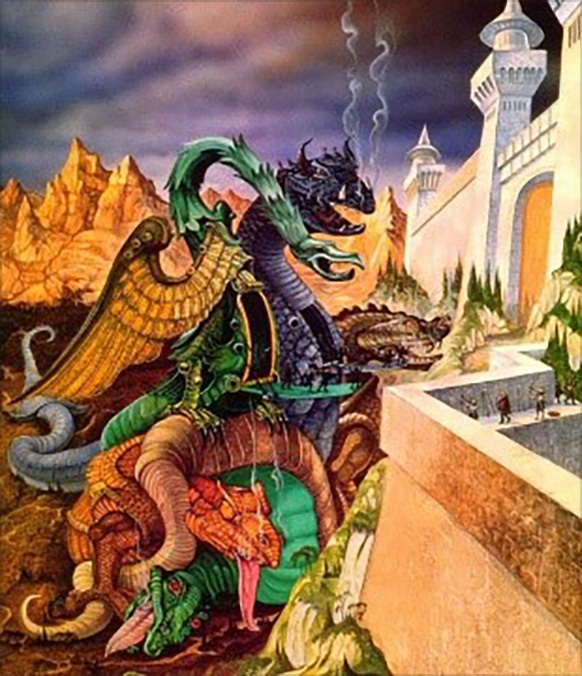
3. Fall of Gondolin
1987 oils on board, image size 230 x 430 mm. Artwork for the book cover of The Book of Lost Tales, Book 2, Unwin Hyman.
Reproduced in the 1989 J.R.R. Tolkien Calendar, Ballantine Books, for March.16 views

1st Paperback Edition 1986
Unicorn/Unwin Paperbacks
Cover illustration by Roger Garland.6 views

1st Paperback Edition, 3rd Impression 1988, 1989, 1990
Unwin Paperbacks
Cover illustration by Roger Garland.1 view

4. Farmer Giles of Ham
1989 oils on board, image size 200 x 300mm. Artwork for the book cover of Farmer Giles of Ham, Unwin Hyman.5 views

Reset New Edition 1990, reprinted in 1991, 1993, 1994
Unwin Hyman
Cover and illustrated by Garland3 views
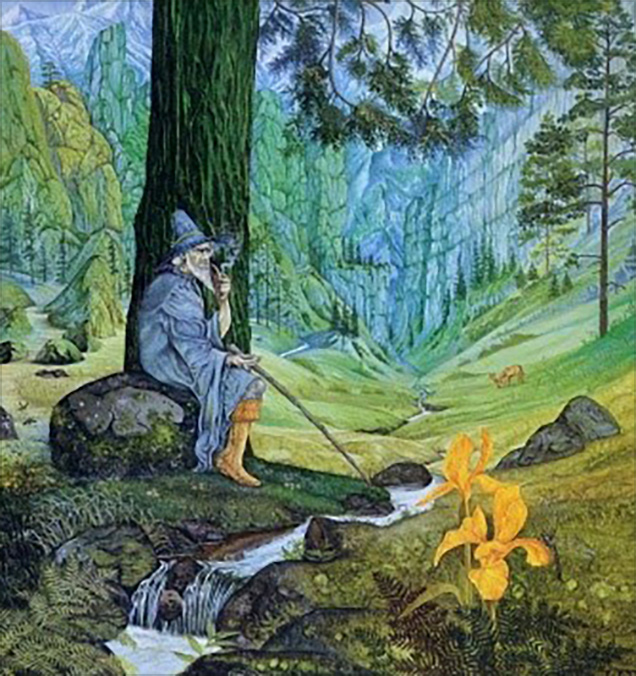
5. Gandalf
1983 oils on board, 250 mm x 320 mm. Artwork for the 1984 Tolkien Calendar, Unwin Hyman.
Depicts Gandalf the Grey relaxing in a mountain and brook scene, exuding cool colourings with a foreground focus of fiery irises. This painting has a medieval atmosphere in Tolkien-stylized imagery.12 views

6. Glaurung first of the dragons of Morgoth
1981 oils on board, image size 200 x 330 mm. Cover artwork for The Unfinished Tales Book 1, Unwin Hyman.13 views

1st Paperback Edition 1982, 1983, 1984, 1985, 1986
Unicorn/Unwin Paperbacks
Cover illustration by Roger Garland7 views

1st Paperback Edition, 9th Impression 1987, 1988, 1989, 1990, 1991
Unwin Paperbacks, Grafton
Cover illustration by Roger Garland4 views

7. Gollum
1983 oils on board, image size 200 x 330 mm. Artwork for the 1984 Tolkien Calendar, Unwin Hyman.
Evoking an ethereal fantastical atmosphere of mountains, waterfall and hanging moon, reminiscent of Pauline Baynes’s cover-art for the 1960's paperback.12 views

8. Last Journey of Boromir
1991 oil on panel, image size 300 x 430 mm. Cover artwork for The Treason of Isengard, Unwin Hyman.4 views
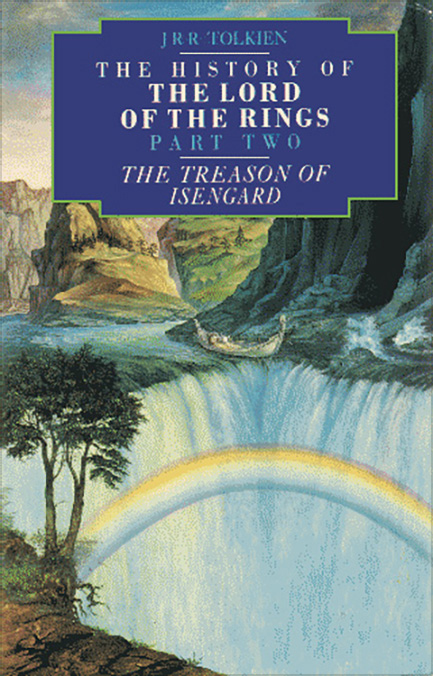
1992 Edition
Grafton
Paperback
Cover illustration by Roger Garland3 views

1993 Edition, 1st Impression
HarperCollins
Paperback
Cover illustration by Roger Garland

9. Lord of the Nazgul, Battle of the Pellenor Fields
1983 oils on board. Artwork for the 1984 Tolkien Calendar, Unwin Hyman.13 views

10. Lúthien in the Woods of Neldoreth
1988 oils on board, image size 230 x 330 mm. Reproduced in the 1989 J.R.R. Tolkien Calendar, Ballantine Books, for December.7 views

11. Melkor chained
1983 oils on board, image size 250 x 380 mm. Artwork for The 1984 Tolkien Calendar, Unwin Hyman.
Depiction of Melkor bound by the chain Angainor, with vast pits extending deep into earth…11 views

12. Hobbiton
This painting depicts the lush green landscape of Hobbiton and the Shire (with an unusual mountainous terrain) and a wonderful detailed image of Bag End and many other landmarks such as the gardens, bridge, mill etc
Reproduced in the 1989 J.R.R. Tolkien Calendar, Ballantine Books, for May.24 views

13. Moria
Reproduced in the 1989 J.R.R. Tolkien Calendar, Ballantine Books, for April.8 views

14. Pelargir
Reproduced in the 1989 J.R.R. Tolkien Calendar, Ballantine Books, for September.3 views

15. Falls of Rauros
Reproduced in the 1989 J.R.R. Tolkien Calendar, Ballantine Books, for July.2 views

16. Middle-earth
1987 oils and acrylics, image size 360 x 360 mm. Artwork for Collins Audio Cassette cover.5 views
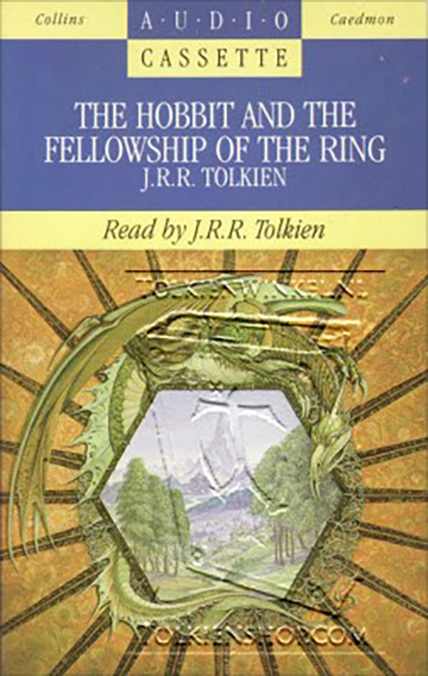
2 views
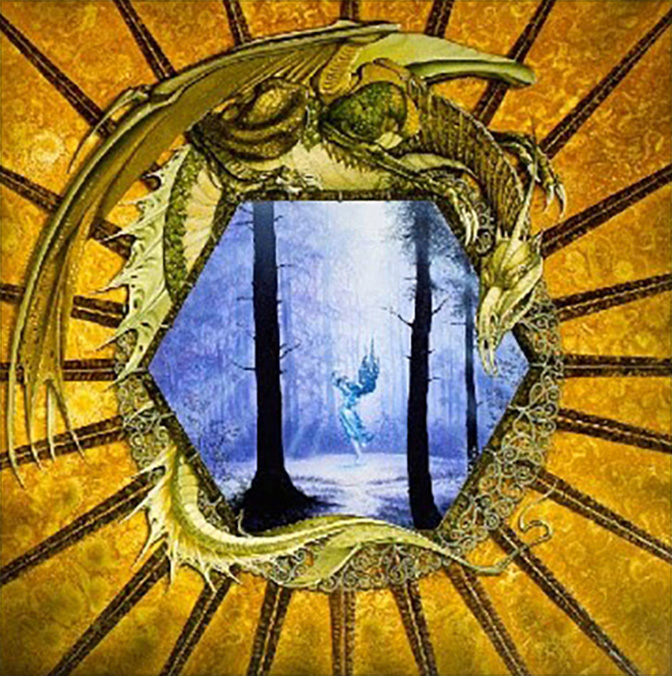
17. Luthien in the Woods of Neldoreth 2
1987 oil on panel, image size 255 x 255 mm. Illustration for Poems and Songs of Middle-earth, Collins Audio Cassette, 1987.2 views
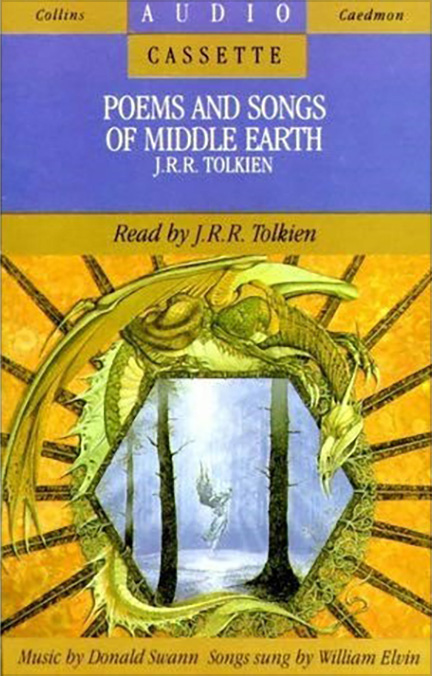

18. Baradur
1987 oil on panel, image size 255 x 255 mm. Illustration for The Lord of the Rings, Collins Audio Cassette, 1987.5 views
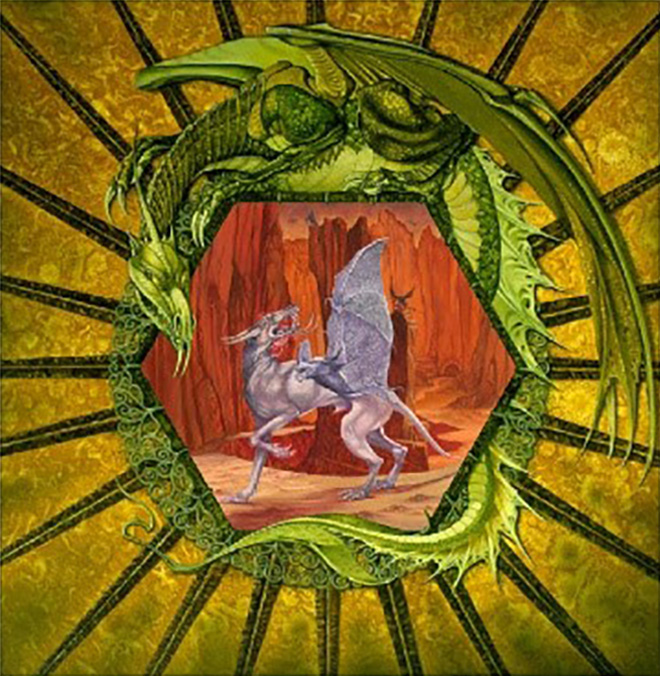
19. Beren and Luthien
1987 oil on panel, image size 255 x 255 mm. Illustration for Collins Audio Cassette, 1987.3 views

20. The Darkening of Valinor
1987 oil on panel, image size 255 x 255 mm. Illustration for The Silmarillion, Collins Audio Cassette, 1987.2 views

Christopher Tolkien And J.R.R. Tolkien – Of The Darkening Of Valinor And The Flight Of The Noldor.1 view

21. Minas Morgul, Tower of Sorcery
5 views

22. Minas Tirith
7 views

23. Return of the Shadow
1981 oils on board, image size 230 x 430 mm. Artwork for the book cover The Return of the Shadow, Unwin Hyman.
Reproduced in the 1989 J.R.R. Tolkien Calendar, Ballantine Books, for February.2 views
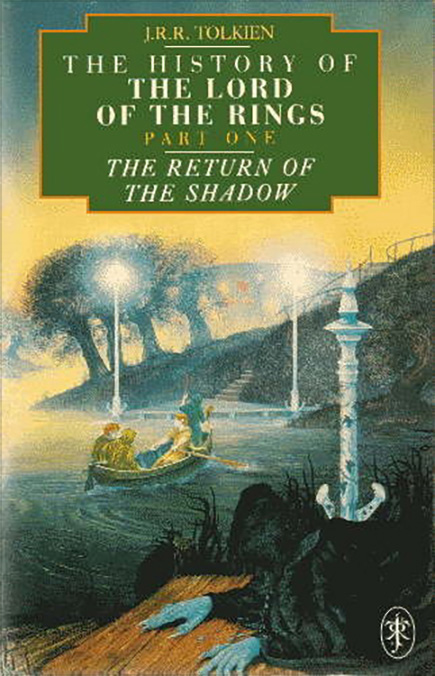
1st Paperback Edition 1990
Unwin Paperbacks
Cover illustration by Roger Garland3 views

24. Sauron Defeated (1)
1992 oils on board, image size 200 x 330 mm. Cover artwork unpublished, Unwin Hyman.8 views
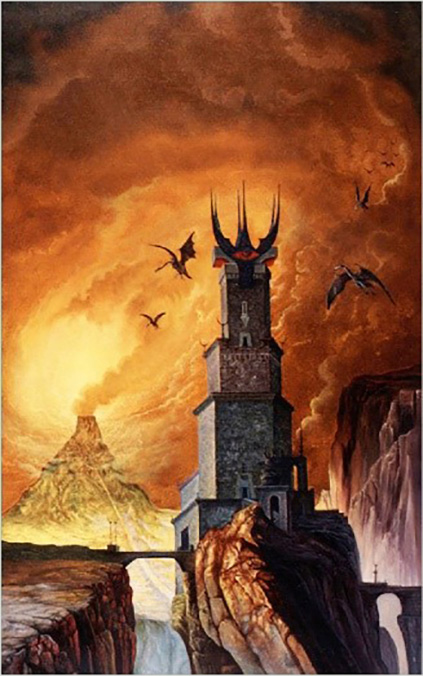
25. Sauron Defeated (2)
1993 oils on board, image size 245 x 390 mm. Artwork for book cover, Unwin Hyman.8 views

1st Paperback Edition 1993, 1st Impression
HarperCollins
Cover illustration by Roger Garland3 views
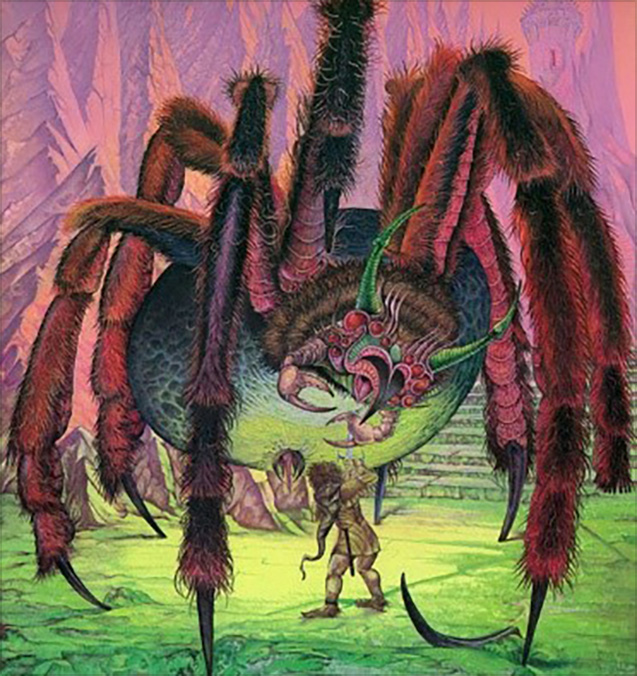
26. Shelob
1983 oils on board, image size 280 x 430 mm. Artwork for the book cover The 1984 Tolkien Calendar, Unwin Hyman.4 views

27. Smaug the Magnificent
1987 oils on board. Artwork for The Hobbit, Unwin Hyman.5 views
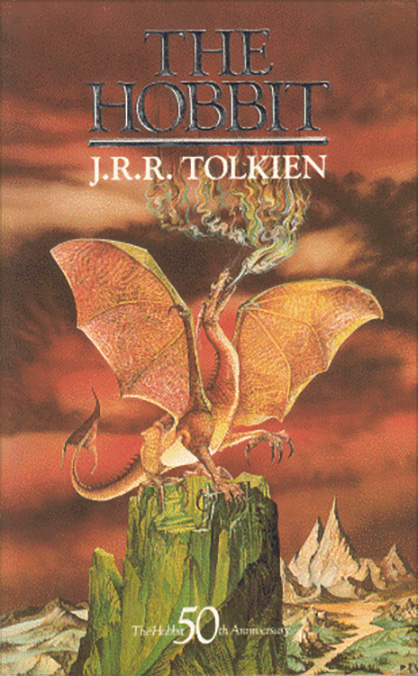
50th Anniversary Edition
4th Edition, 1987
Unwin Paperbacks
Illustrated by J.R.R. Tolkien
Cover illustration by Roger Garland.1 view

4th Edition, 22nd Impression 1988
Unwin Paperbacks
Illustrated by J.R.R. Tolkien
Cover illustration by Roger Garland.1 view

Reproduced in the 1988 J.R.R. Tolkien Calendar, published by Ballantine Books in 1987 for the cover and August.
The calendar features art by J.R.R. Tolkien, Roger Garland, John Howe and Ted Nasmith based on The Hobbit.1 view

28. Smaug
Reproduced in the 1989 J.R.R. Tolkien Calendar, Ballantine Books, for October.3 views

29. The Bridge of Khazad-dum
1983 oils on board, image size 250 x 380 mm. Artwork for 1984 Tolkien Calendar, Unwin Hyman.2 views

30. The Tale of the Sun and trhe Moon
1981 oils on board. Cover artwork for the book cover Book of Lost Tales, Part 1, Unwin Hyman.1 view

1st Paperback Edition 1985, 1986
Unicorn/Unwin Paperbacks
Cover illustration by Roger Garland.1 view

1st Paperback Edition, 4th Impression 1987, 1988, 1989, 1990
Unwin Paperbacks
Grafton, 1991
Cover illustration by Roger Garland.

31. The Haven of Morriondë
1989 oils on board. Artwork for The Lost Road, Unwin Hyman Reproduced in the 1989 J.R.R. Tolkien Calendar, Ballantine Books, for January.
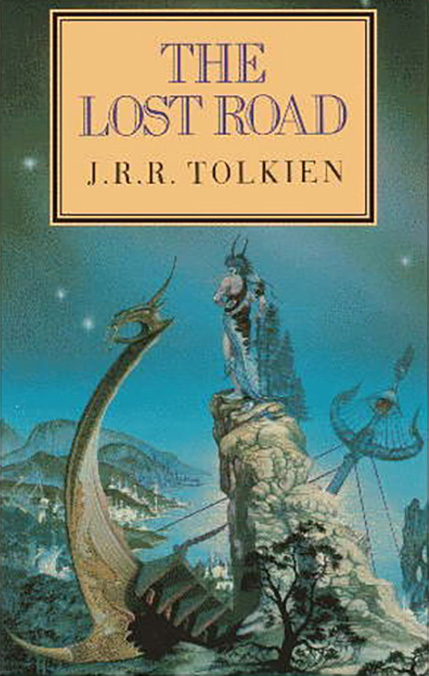
1st Paperback Edition 1989
Unwin Paperbacks
1992 Edition, 1st Impression.
Grafton.
Cover illustration by Roger Garland

32. The Haven of the Swans
1982 oils on board, image size 200 x 300 mm. Artwork for the book cover The Silmarillion, Unwin Hyman.2 views

2nd Edition Unicorn/Unwin 1983, 1984, 1985, 1986
Paperbacks
Cover illustration by Roger Garland.

2nd Edition, Unwin 1987, 1988, 1989, 1990 Grafton 1991
Paperbacks
Cover illustration by Roger Garland

33. The Shire
1987 oils on board, image size 200 x 300 mm. Cover artwork for The Lord of the Rings Box Set, Unwin Hyman.7 views
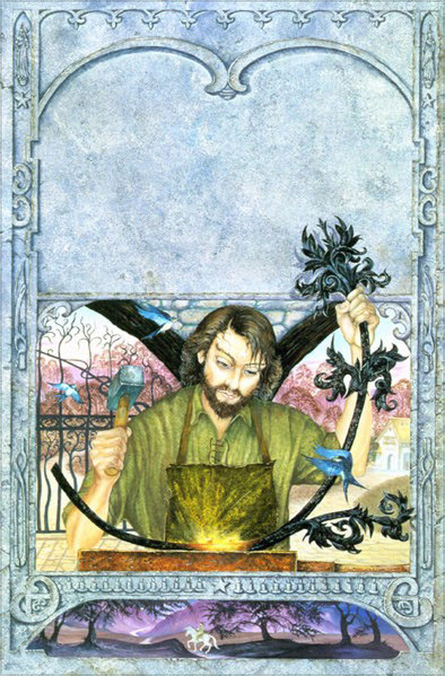
34. The Smith of Wootton Major
1989 oils on board, image size 200 x 300mm. Artwork for the book cover The Smith of Wootton Major, Unwin Hyman.
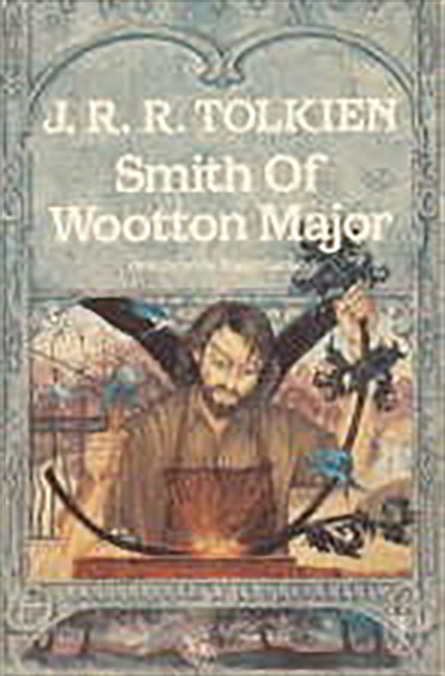
Reset Edition Unwin Hyman 1990, 1991
Grafton 1993
Harper Collins 1995
Illustrated by Roger Garland.

35. The War of the Ring
1991 oils on board. Artwork for a book cover, Unwin Hyman
The preliminary pencil drawing is located at:
https://www.lotrarts.com/artwork/paintings-drawings-lithographs2 views

The War Of The Rings, J R R Tolkien signed cover & drawing.
Image size: 230mm x 360mm pencil on paper. This preparatory drawing was submitted to Harper Collins and the Tolkien Estate for their comments prior to painting the finished artwork for publication. The drawing is in good condition considering this was a working drawing and constantly referred to as the painting was in progress. The original artwork has been published in many books and on art cards and is on permanent display at Lakeside Gallery, Tolkien Collection, Cornwall.
The drawing is signed, dated 1990 and is embossed with the Lakeside Gallery logo. The printers proof is signed and dated on the reverse by Roger and is included to confirm provenance.2 views

1st Paperback Edition 1992
Grafton
Cover illustration by Roger Garland3 views

36. Thu as Wolf
1987 oils on board, image size 300 x 480 mm. Artwork for the book cover The Lays of Beleriand, Unwin Hyman
Reproduced in the 1989 J.R.R. Tolkien Calendar, Ballantine Books, for November.
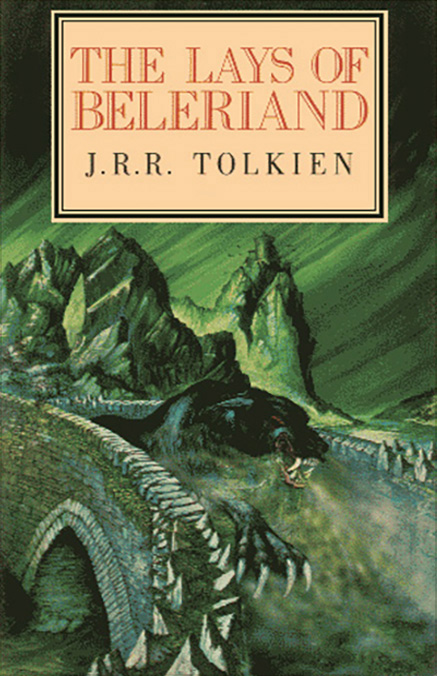
1st Paperback Edition 1987, 1989
Unwin Paperbacks
Grafton 1992
Cover illustration by Roger Garland
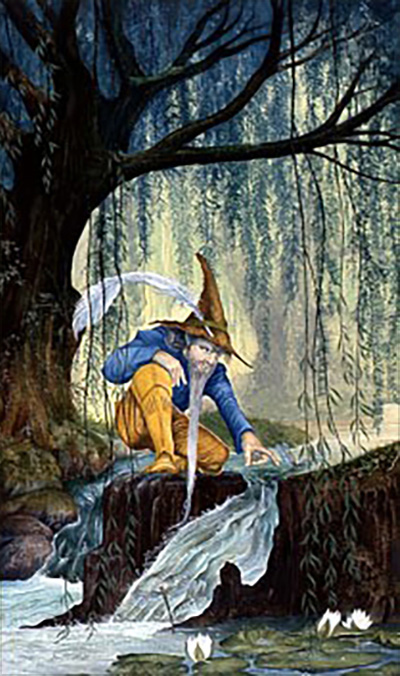
37. Tom Bombadil
1990 oils on board, image size 200 x 300 mm. Artwork for the book cover The Adventures of Tom Bombadil, Unwin Hyman.7 views
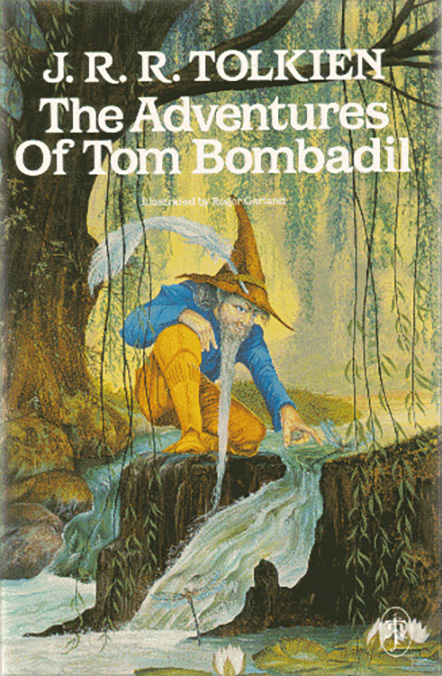
Reset New Edition 1990, 1993, 1995
Unwin Hyman, Grafton, HarperCollins
Illustrated by Roger Garland.

38. Old Man Willow
Reproduced in the 1989 J.R.R. Tolkien Calendar, Ballantine Books, for August.2 views

39. Two Trees of Valinor
Roger has depicted this scene in the spirit of Tolkien’s imagery. Laurelin the Golden (on left) bedecked with blossoms and Telperion (the Eldest of Trees) both standing majestically intermingling their lights to shine together, with the Pelóri, the Valar’s great mountain range, in the background. Interestingly, apart from the massiveness of these trees, Roger has also added, to emphasise their ‘ancientness’, a Stonehenge-type ring.
1982 oil on panel, image size 255 x 280 mm. Artwork for the 1984 Tolkien Calendar, Unwin Hyman.2 views

40. Ulmo
This painting depicts the King of the Sea (The Lord of the Waters, Dweller of the Deep). He lives in the deeps under Ambar where he composes his music and governs all waters, bays and rivers. Here, appearing in majesty over Tuor.
1983 oils on board. Artwork commissioned for the 1984 Tolkien Calendar, Unwin Hyman.4 views

41. Tolkien Landscape
1983 oil on panel, image size 300 x 1080 mm. Artwork was commissioned for the trilogy book cover, Unwin Hyman, 1986.
The original oil painting is on permanent exhibition at Lakeside Gallery.11 views

Pencil drawing
https://www.lotrarts.com/images/gallery/artwork/art/20-drawings-002.png?i=369923448
This highly detailed proprietary drawing in pencil on paper is in three sections which can be presented as a long landscape (H27cm x L 107 cm). The drawing is surrounded by annotations by the artist communicating colours and reference. The drawing came with three signed covers to confirm provenance. This drawing is located in the collection of LOTRArts.com.9 views

Book covers
The Fellowship of the Ring
Reissued Edition 1986, 1987, 1988, 19894 views

Unicorn/Unwin Paperbacks
Cover illustration by Roger Garland.
The Two Towers
Reissued Edition 1986, 1987, 1988, 1989
Unicorn/Unwin Paperbacks
Cover illustration by Roger Garland.1 view

The Return of the King
Reissued Edition 1986, 1987, 1988, 1989
Unicorn/Unwin Paperbacks
Cover illustration by Roger Garland.2 views

Reissued Edition 1986 & 1988
Unicorn/Unwin Paperbacks.
Paperbacks. Issued in a slipcase.
Slipcase illustrations by Roger Garland.1 view

The Tolkien Box Set
Modern Classics from the Master of Fantasy.
Unwin Paperbacks.
Paperbacks. Issued in a box.
Slipcase illustration by Roger Garland.1 view

42. Smith of Wotton Major
1987 oils on board. Artwork for a book cover, Unwin Hyman.3 views

1st Edition 1997
HarperCollins
Hardback in dustwrapper
Cover illustration by Roger Garland2 views

43. The Brandywine River
2 views

1st Paperback Edition 1990
Unwin Paperbacks
Cover illustration by Roger Garland2 views

44. Middle-earth
Copper etching, 1989, image size 120 x 100 mm.4 views

45. The End of the chase Farmer Giles of Ham
Copper etching, 1989, image size 140 x 200 mm.5 views

46. The King’s Arrival from Farmer Giles of Ham
Copper etching, 1989, image size 75 x 274 mm.3 views
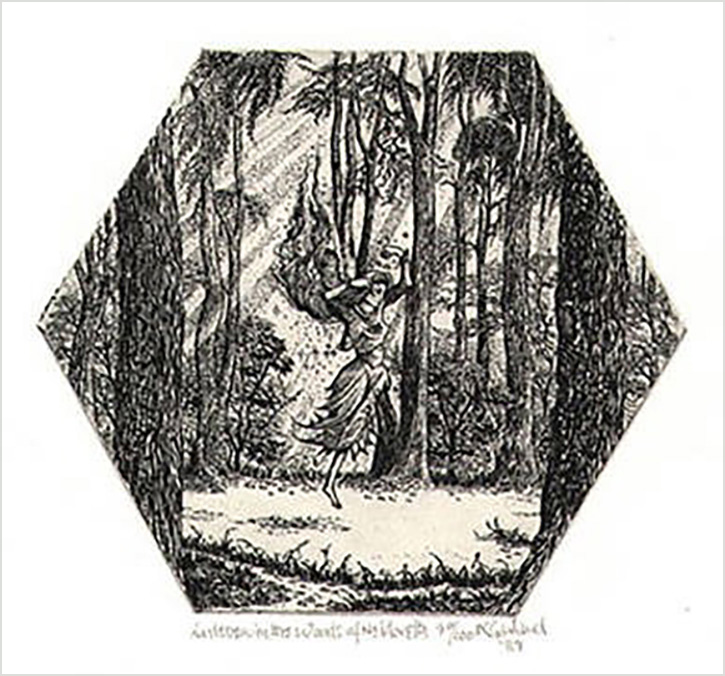
47. Luthlien
Copper etching, 1989, image size 120 x 100 mm.1 view

48. Croga, Salmon of Knowledge
Copper etching, 1999, image size 120 x 160 mm.2 views

49. The watchers
Copper etching, 1989, image size 100 x 120 mm.7 views

By 1987, Alan Lee had become the main illustrator for the quintessential British fantasy author, J.R.R. Tolkien. When American publisher Houghton Mifflin reissued ‘The Lord of the Rings’ in a three volume hardcover box set in 1987, it was Alan Lee who created the illustrations used for the dust jackets of all three Hardcover volumes and the box art.
views

5 views
image001a

4 views
image001b

1 view
image001c

3 views
image001d

1 view
image002a

2 views
image002b

2 views
image002c
![[spacer]](https://www.lotrarts.com/../images/gallery/showcase/alan-lee/image002cc-P1-450x676.png)
[spacer]

5 views
image002d
![[spacer]<span class="ngViews"> views</span>](https://www.lotrarts.com/../images/gallery/showcase/alan-lee/image002dd-450x676.png)
[spacer] views

In 1988 Houghton Mifflin would release a four volume box set of Paperbacks which included all three volumes of ‘The Lord of the Rings’ and a new release of ‘The Hobbit’.
views
image003

image003a

image003b

1 view
image003c

The four volumes of the box set were packed without dust jackets. If purchased separately however, each volume came with a dust jacket with the illustrations of Alan Lee.
image004
![[spacer]](https://www.lotrarts.com/../images/gallery/showcase/alan-lee/image004----.png)
[spacer]

1 view
image004a

1 view
image005b
![[spacer]](https://www.lotrarts.com/../images/gallery/showcase/alan-lee/image004as.png)
[spacer]
image004as
![[spacer]](https://www.lotrarts.com/../images/gallery/showcase/alan-lee/image004at.png)
[spacer]
image004at

1 view
image004b

1 view
image005c
![[spacer]](https://www.lotrarts.com/../images/gallery/showcase/alan-lee/image004bs.png)
[spacer]
image004bs
![[spacer]](https://www.lotrarts.com/../images/gallery/showcase/alan-lee/image004bt.png)
[spacer]
image004bt

image004c

image005d
![[spacer]](https://www.lotrarts.com/../images/gallery/showcase/alan-lee/image004cs.png)
[spacer]
image004cs
![[spacer]](https://www.lotrarts.com/../images/gallery/showcase/alan-lee/image004ct.png)
[spacer]
image004ct

1 view
image004d

image005a
![[spacer]](https://www.lotrarts.com/../images/gallery/showcase/alan-lee/image004ds.png)
[spacer]
image004ds

Beginning in 1984, Houghton Mifflin began releasing all 12 Hardcover volumes of ‘The History of Middle-earth’. The final volume – Volume 12 – ‘The Peoples of Middle-earth’ would not be released until 1996. Volumes 6 through 9 are devoted to ‘The History of The Lord of the Rings’. Volume 6 - ‘The Return of the Shadow’ and Volume 7 – ‘The Treason of Isengard’ were published in 1989. Volume 8 – ‘The War of the Ring’ was released in 1990 and Volume 9 – “Sauron Defeated: The End of the Third Age’ made its first appearance in 1992. Alan Lee was once again chosen by Houghton Mifflin to provide the the images to be displayed on the dust covers for Volumes 6 through 9 of ‘The History of Middle-earth’. A four volume Paperback Box Set of Volumes 6 through 9 – ‘The History of the Lord of the Rings’ was released by Houghton Mifflin in the year 2000. Alan Lee’s illustrations from the Hardcover editions of these four volumes were employed for the Paperback editions as well. Here are scans of those Hardcover and Paperback covers and Alan lee’s original drawings.
image006
![[spacer]](https://www.lotrarts.com/../images/gallery/showcase/alan-lee/image006-.png)
[spacer]
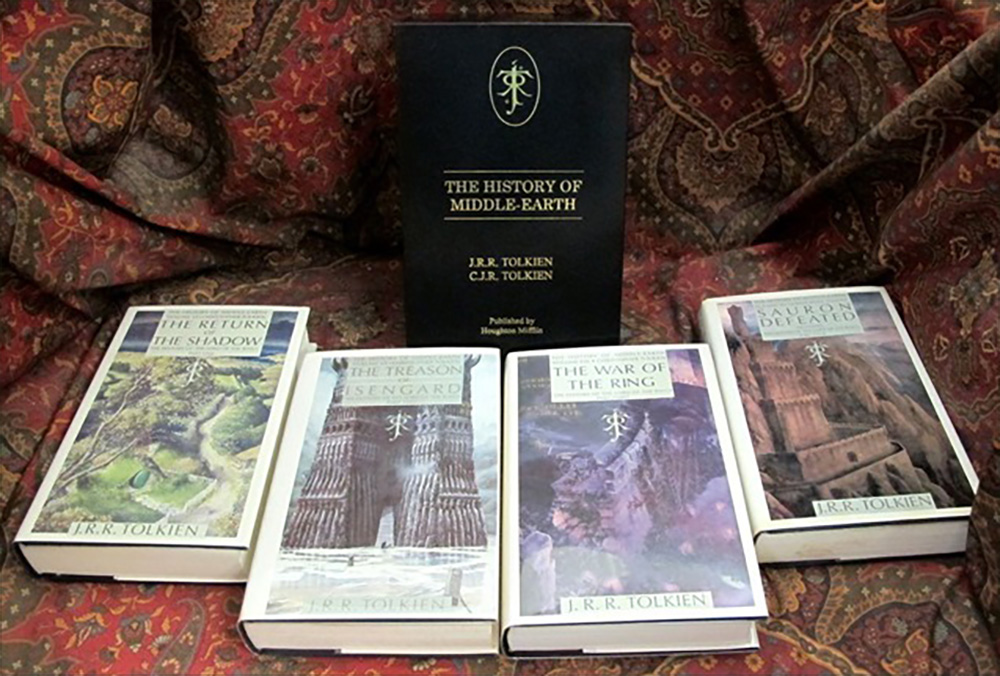
image006a
![[spacer]](https://www.lotrarts.com/../images/gallery/showcase/alan-lee/image006ab.png)
[spacer]
image006ab
![[spacer]](https://www.lotrarts.com/../images/gallery/showcase/alan-lee/image006az.png)
[spacer]
image006az

image007

image007a
![[spacer]](https://www.lotrarts.com/../images/gallery/showcase/alan-lee/image007ax.png)
[spacer]
image007ax
![[spacer]](https://www.lotrarts.com/../images/gallery/showcase/alan-lee/image007az.png)
[spacer]
image007az

1 view
image008

2 views
image008a
![[spacer]](https://www.lotrarts.com/../images/gallery/showcase/alan-lee/image008ax.png)
[spacer]
image008ax
![[spacer]](https://www.lotrarts.com/../images/gallery/showcase/alan-lee/image008az.png)
[spacer]
image008az

1 view
image009
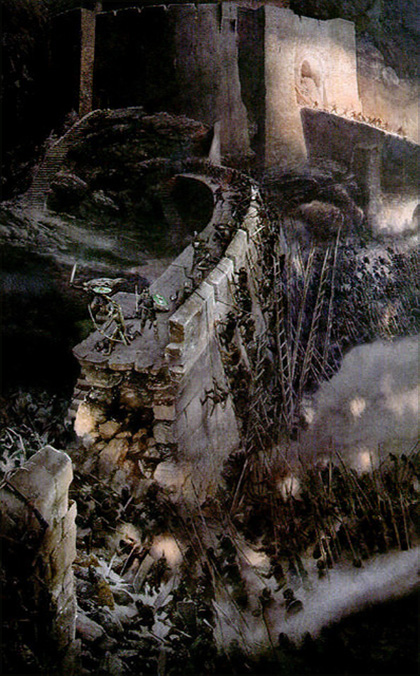
1 view
image009a
![[spacer]](https://www.lotrarts.com/../images/gallery/showcase/alan-lee/image009ax.png)
[spacer]
image009ax
![[spacer]](https://www.lotrarts.com/../images/gallery/showcase/alan-lee/image009az.png)
[spacer]
image009az

1 view
image010

views
image010a
![[spacer]](https://www.lotrarts.com/../images/gallery/showcase/alan-lee/image010ax.png)
[spacer]
image010ax

J.R.R. Tolkien was born on January 3, 1892. On December 11, 1991 to commemorate the 100th. Anniversary of Tolkien’s birth, Houghton Mifflin released a one volume Hardcover Centenary Edition of ‘The Lord of the Rings’. This centenary edition of the classic volume was illustrated with fifty specially commissioned paintings by Alan Lee who also provided the images used for both the front and back covers of this special publication. Here are scans of the covers from Houghton Mifflin’s Centenary Edition of ‘The Lord of the Rings’ as well as Alan Lee’s original drawings.
image011
![[spacer]](https://www.lotrarts.com/../images/gallery/showcase/alan-lee/image011---.png)
[spacer]
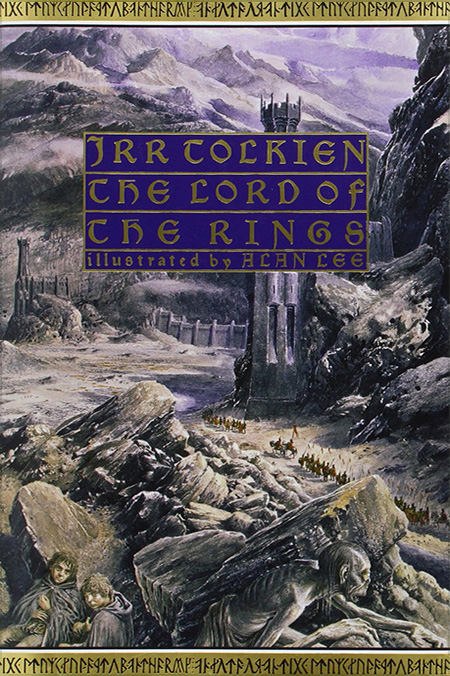
2 views
image011a

2 views
image011b
![[spacer]](https://www.lotrarts.com/../images/gallery/showcase/alan-lee/image011bj.png)
[spacer]
image011bj
![[spacer]](https://www.lotrarts.com/../images/gallery/showcase/alan-lee/image011bk.png)
[spacer]
image011bk

1 view
image012a
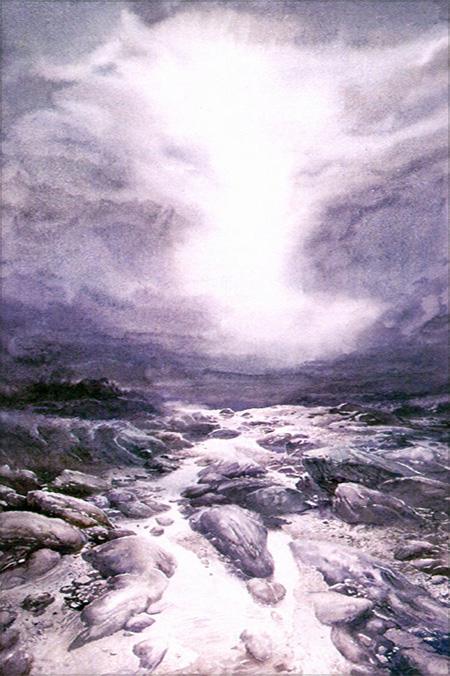
image012b
![[spacer]](https://www.lotrarts.com/../images/gallery/showcase/alan-lee/image012bj.png)
[spacer]
image012bj

In 1991, a one volume Hardcover Centenary Edition of ‘The Lord of the Rings’ was also issued in the United Kingdom by Harper Collins to commemorate the 100th Anniversary of J.R.R. Tolkien’s birth. The dust jacket of the Harper Collins publication features the same illustration by Alan Lee but with a different Printed Logo. While the back of the Houghton Mifflin Centennial Edition dust jacket featured a Centennial Ring with a ‘Blue’ center, the Harper Collins Centennial Edition featured a Centennial Ring with a ‘Red’ center. No evidence has been found that Harper Collins ever issued a Paperback ‘Lord of the Rings’ Centenary Edition.
image013

views
image013a

image013b
![[spacer]](https://www.lotrarts.com/../images/gallery/showcase/alan-lee/image013bk.png)
[spacer]
image013bk

image013c

image014
![[spacer]](https://www.lotrarts.com/../images/gallery/showcase/alan-lee/image014bl.png)
[spacer]
image014bl

A Centenary Edition three volume Hardcover Box Set, housed in the original publishers slipcase was published by Harper Collins in 1992. The books feature Alan Lee's Illustrations that were commissioned to celebrate the Centenary of Tolkien’s Birth. Only one printing of this lovely set was ever published. The dust jackets feature some of Alan Lee's most famous illustrations, with a Silver Band to the top and bottom with the runes in black. The orientation of ‘The Battle of Pelennor Fields’ illustration featured on Part Three, ‘The Return of the King’ volume appears to have been altered from Alan’s original painting.
image015
![[spacer]](https://www.lotrarts.com/../images/gallery/showcase/alan-lee/image015=.png)
[spacer]

2 views
image015a
![[spacer]](https://www.lotrarts.com/../images/gallery/showcase/alan-lee/image015ag.png)
[spacer]
image015ag
![[spacer]](https://www.lotrarts.com/../images/gallery/showcase/alan-lee/image015au.png)
[spacer]
image015au

1 view
image016aaa
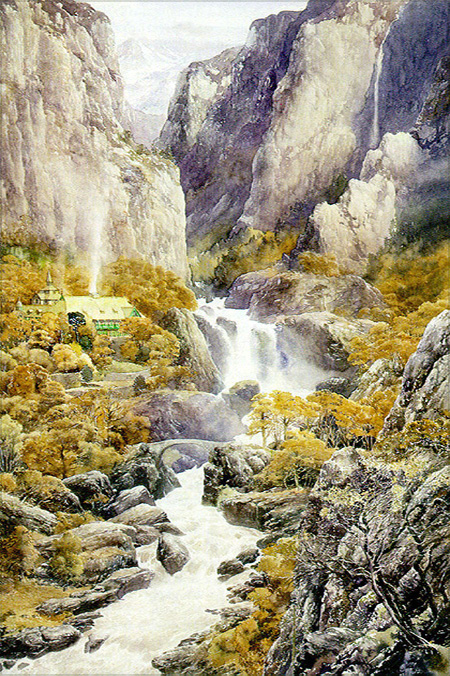
1 view
image016b
![[spacer]](https://www.lotrarts.com/../images/gallery/showcase/alan-lee/image016bv.png)
[spacer]
image016bv
![[spacer]](https://www.lotrarts.com/../images/gallery/showcase/alan-lee/image016bw.png)
[spacer]
image016bw

image017aaa

1 view
image017b
![[spacer]](https://www.lotrarts.com/../images/gallery/showcase/alan-lee/image017bv.png)
[spacer]
image017bv
![[spacer]](https://www.lotrarts.com/../images/gallery/showcase/alan-lee/image017bw.png)
[spacer]
image017bw
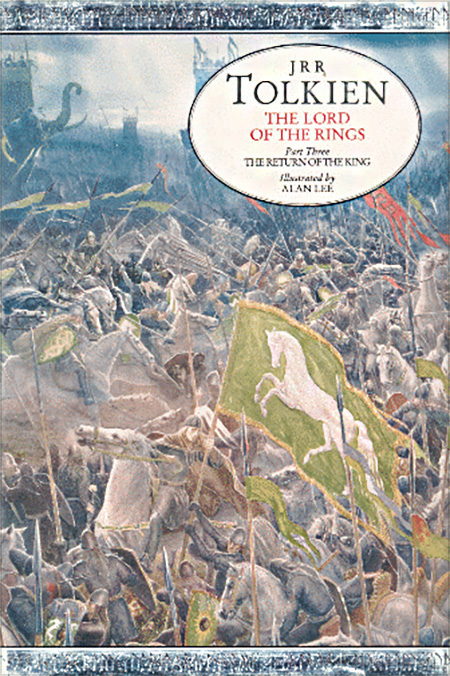
2 views
image018aaa

1 view
image018b
![[spacer]](https://www.lotrarts.com/../images/gallery/showcase/alan-lee/image018bv.png)
[spacer]
image018bv

A 3 Volume Paperback Box Set of ‘The Lord of the Rings’ was issued by Harper Collins in 1996. The box illustration and covers were by Alan Lee.
image019
![[spacer]](https://www.lotrarts.com/../images/gallery/showcase/alan-lee/image019---.png)
[spacer]
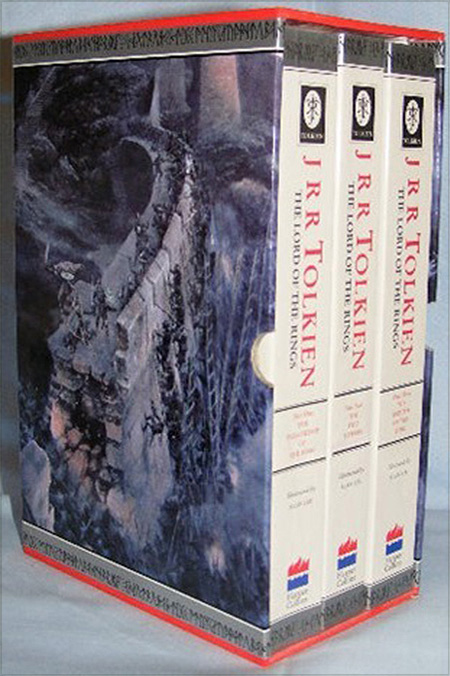
1 view
image019a
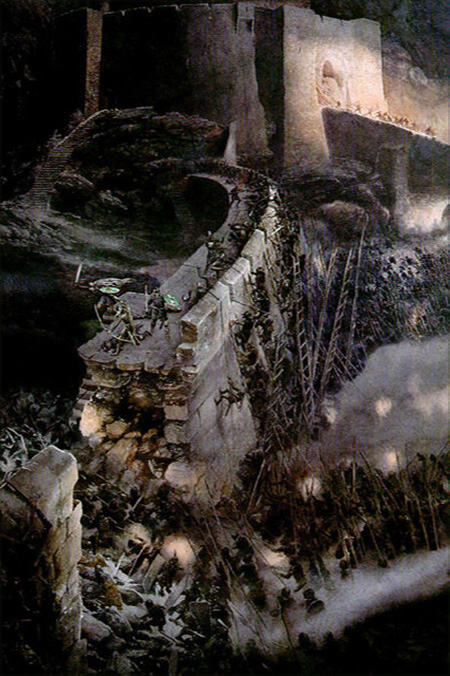
1 view
image019b
![[spacer]](https://www.lotrarts.com/../images/gallery/showcase/alan-lee/image019bv.png)
[spacer]
image019bv

image019c

views
image019cc
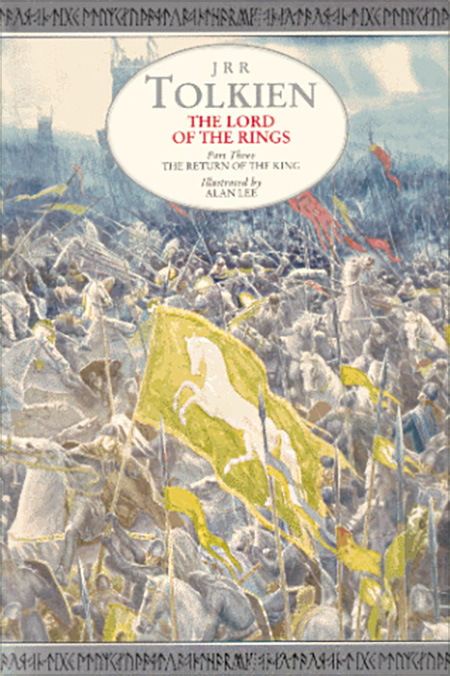
views
image019ccc

On September 19, 1997, a mere six years following the release of the Centenary Edition of ‘The Lord of the Rings’ by Houghton Mifflin, they would go on to release a new edition of ‘The Hobbit’, commemorating the 60th. Anniversary of the very first publication of ‘The Hobbit’ by George Allen & Unwin Ltd. of London on September 21, 1937. This new 60th. Anniversary Edition of ‘The Hobbit’ features 22 full color illustrations depicting key scenes from this all-time classic (scenes such as Gollum and Bilbo, The Wargs, Smaug the Dragon and The Battle of the Five Armies). This beautifully designed volume also includes a wealth of integrated pencil drawings which demonstrate perfectly Alan’s genius at work. The dust jacket of this volume features two of Alan Lee’s illustrations, accented by a gold border on the top and bottom edge that features Tolkien’s runic script. Here are scans of the dust jacket for the Houghton Mifflin 60th. Anniversary Edition of ‘The Hobbit’ and Alan’s original illustrations.chosen for this dust jacket.
image020

2 views
image020a

image020b

1 view
image022a

2 views
image022b

Harper Collins London would also publish a one volume Hardcover 60th. Anniversary Edition of ‘The Hobbit’ in 1997. Neither Houghton Mifflin or Harper Collins appear to have issued a Paperback 60th. Anniversary Edition of ‘The Hobbit’. The dust jacket illustrations of the Harper Collins publication appear to be the same as those used for the Houghton Mifflin 60th Anniversary Edition.
image023
![[spacer]](https://www.lotrarts.com/../images/gallery/showcase/alan-lee/image023-.png)
[spacer]

1 view
image023a
![[spacer]](https://www.lotrarts.com/../images/gallery/showcase/alan-lee/image023ad.png)
[spacer]
image023ad

On September 15, 1999, Houghton Mifflin released a new illustrated Paperback edition of ‘The Hobbit’ with cover art by Alan Lee. Here is a scan of that cover and Alan’s original drawing.
>
image024
![[spacer]](https://www.lotrarts.com/../images/gallery/showcase/alan-lee/image024--.png)
[spacer]
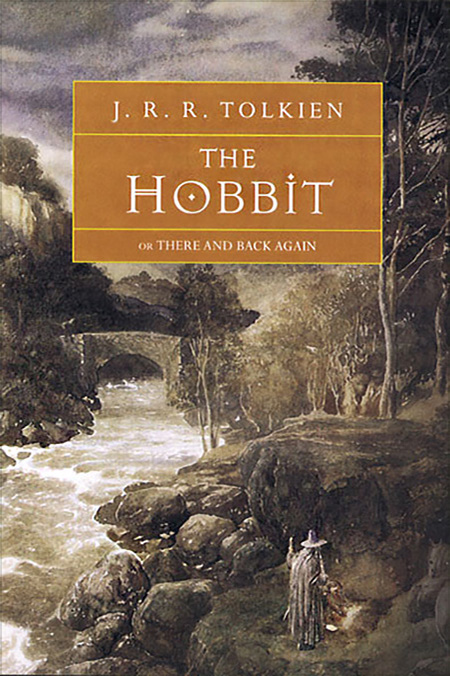
image024a

image024b
![[spacer]](https://www.lotrarts.com/../images/gallery/showcase/alan-lee/image024bg.png)
[spacer]
image024bg

In 1999 Houghton Mifflin also released a four volume Paperback boxed set of ‘The Hobbit’ and ‘The Lord of the Rings’ with cover art by Alan Lee.
image024z
![[spacer]](https://www.lotrarts.com/../images/gallery/showcase/alan-lee/image024zzz.png)
[spacer]
image024zzz

1 view
image025
![[spacer]](https://www.lotrarts.com/../images/gallery/showcase/alan-lee/image025---.png)
[spacer]
![[spacer]](https://www.lotrarts.com/../images/gallery/showcase/alan-lee/image025----.png)
[spacer]

image025a

image025b
![[spacer]](https://www.lotrarts.com/../images/gallery/showcase/alan-lee/image025bg.png)
[spacer]
image025bg
![[spacer]](https://www.lotrarts.com/../images/gallery/showcase/alan-lee/image025bh.png)
[spacer]
image025bh

image025f

image025g
![[spacer]](https://www.lotrarts.com/../images/gallery/showcase/alan-lee/image025gg.png)
[spacer]
image025gg
![[spacer]](https://www.lotrarts.com/../images/gallery/showcase/alan-lee/image025gh.png)
[spacer]
image025gh

image025h
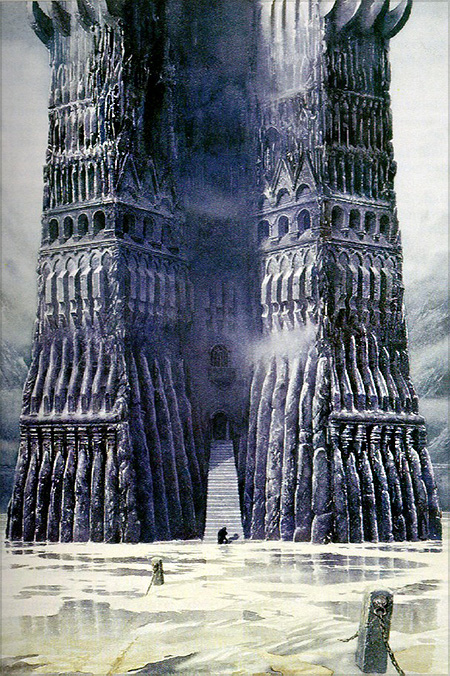
image025i
![[spacer]](https://www.lotrarts.com/../images/gallery/showcase/alan-lee/image025ig.png)
[spacer]
image025ig
![[spacer]](https://www.lotrarts.com/../images/gallery/showcase/alan-lee/image025ih.png)
[spacer]
image025ih

1 view
image025j

1 view
image025k
![[spacer]](https://www.lotrarts.com/../images/gallery/showcase/alan-lee/image025kg.png)
[spacer]
image025kg

“On September 1, 2000 Mariner Books, a division of Houghton Mifflin, issued a 4 volume Paperback Box Set of ‘The History of the Lord of the Rings’ edited by Christopher Tolkien with new cover illustrations by Alan Lee.”
image026
![[spacer]](https://www.lotrarts.com/../images/gallery/showcase/alan-lee/image026-.png)
[spacer]

image026a

image027
![[spacer]](https://www.lotrarts.com/../images/gallery/showcase/alan-lee/image027g.png)
[spacer]
image027g

Here are Alan Lee’s cover illustrations for all 4 volumes of ‘The History of The Lord of the Rings” together with his original paintings.
image028
![[spacer]](https://www.lotrarts.com/../images/gallery/showcase/alan-lee/image028-.png)
[spacer]

1 view
image028a

image029
![[spacer]](https://www.lotrarts.com/../images/gallery/showcase/alan-lee/image029g.png)
[spacer]
image029g
![[spacer]](https://www.lotrarts.com/../images/gallery/showcase/alan-lee/image029h.png)
[spacer]
image029h

image030a
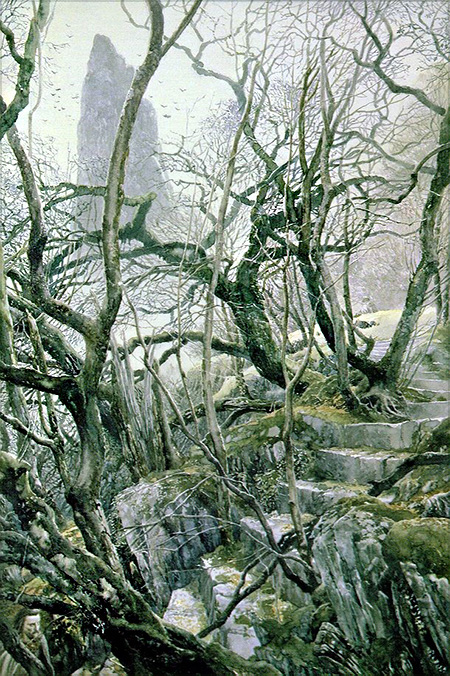
image030b
![[spacer]](https://www.lotrarts.com/../images/gallery/showcase/alan-lee/image030g.png)
[spacer]
image030g
![[spacer]](https://www.lotrarts.com/../images/gallery/showcase/alan-lee/image030h.png)
[spacer]
image030h

image031a

1 view
image031b
![[spacer]](https://www.lotrarts.com/../images/gallery/showcase/alan-lee/image031g.png)
[spacer]
image031g
![[spacer]](https://www.lotrarts.com/../images/gallery/showcase/alan-lee/image031h.png)
[spacer]
image031h

image032a

2 views
image032b
![[spacer]](https://www.lotrarts.com/../images/gallery/showcase/alan-lee/image032g.png)
[spacer]
image032g

In the year 2000, Harper Collins released a beautifully illustrated Slip Case Boxed Set collecting the two most popular Tolkien hardbacks -- the Centenary edition of ‘The Lord of the Rings’ originally issued in 1991 and the 60th Anniversary edition of ‘The Hobbit’ originally issued in 1997, both illustrated by Alan Lee.
image032z

image033

image034a

image034b

image034c

image034d
![[spacer]](https://www.lotrarts.com/../images/gallery/showcase/alan-lee/image034di.png)
[spacer]
image034di

1 view
image034e
![[spacer]](https://www.lotrarts.com/../images/gallery/showcase/alan-lee/image034ej.png)
[spacer]
image034ej

A Hardcover three-volume boxed set of ‘The Lord of the Rings’, lavishly illustrated throughout with more than fifty full-color paintings by Alan Lee was released by Houghton Mifflin on October 1, 2002.
image035
![[spacer]](https://www.lotrarts.com/../images/gallery/showcase/alan-lee/image035-.png)
[spacer]
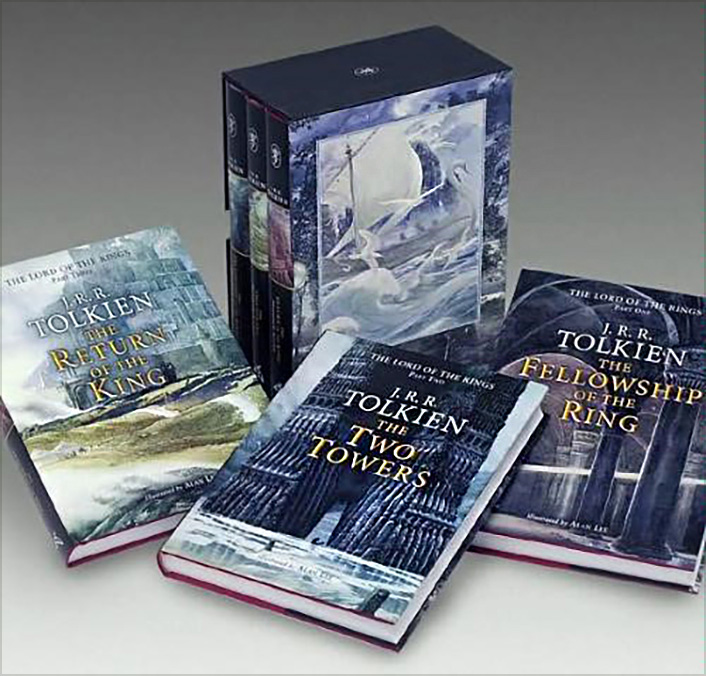
image035a
![[spacer]](https://www.lotrarts.com/../images/gallery/showcase/alan-lee/image035ag.png)
[spacer]
image035ag
![[spacer]](https://www.lotrarts.com/../images/gallery/showcase/alan-lee/image036-.png)
[spacer]

image036a
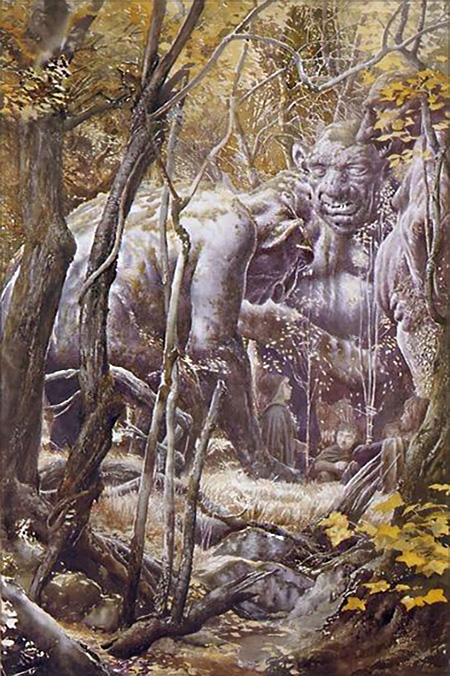
image037a
![[spacer]](https://www.lotrarts.com/../images/gallery/showcase/alan-lee/image036bg.png)
[spacer]
image036bg
![[spacer]](https://www.lotrarts.com/../images/gallery/showcase/alan-lee/image037-.png)
[spacer]

image036b
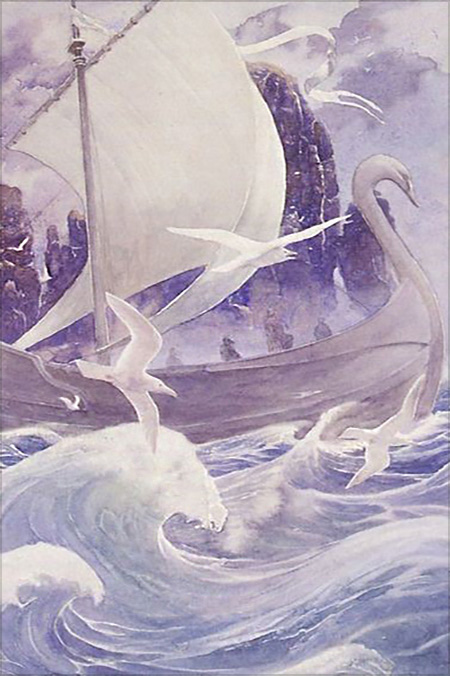
image037b
![[spacer]](https://www.lotrarts.com/../images/gallery/showcase/alan-lee/image037bg.png)
[spacer]
image037bg

Here are scans of Alan Lee’s Illustrated covers of those three volumes and his original drawings
image038
![[spacer]](https://www.lotrarts.com/../images/gallery/showcase/alan-lee/image038-.png)
[spacer]

image038a

image038b
![[spacer]](https://www.lotrarts.com/../images/gallery/showcase/alan-lee/image038bg.png)
[spacer]
image038bg
![[spacer]](https://www.lotrarts.com/../images/gallery/showcase/alan-lee/image038bh.png)
[spacer]
image038bh

image039a

image039b
![[spacer]](https://www.lotrarts.com/../images/gallery/showcase/alan-lee/image039bg.png)
[spacer]
image039bg
![[spacer]](https://www.lotrarts.com/../images/gallery/showcase/alan-lee/image039bh.png)
[spacer]
image039bh

image040a
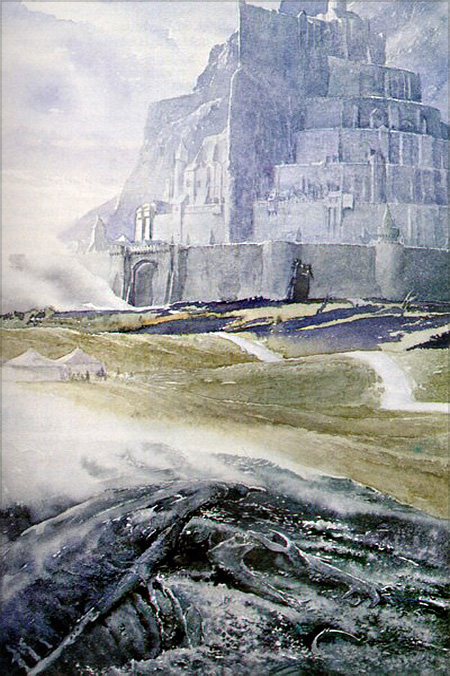
image040b
![[spacer]](https://www.lotrarts.com/../images/gallery/showcase/alan-lee/image040bg.png)
[spacer]
image040bg

Harper Collins released a similar a Hardcover three-volume boxed set of ‘The Lord of the Rings’ in 2000. As far as I can tell, only the ‘Harper Collins’ name and trademark on the Box and dust jackets distinguishes their set from the set released by Houghton Mifflin.
image041
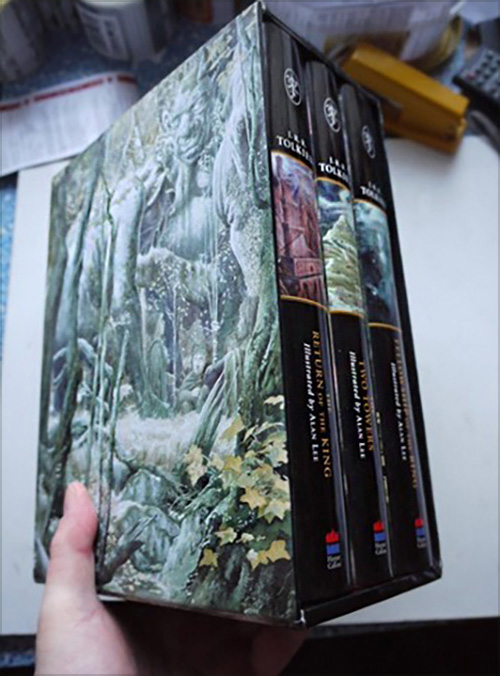
image041a

image041b

1 view
image041c
![[spacer]](https://www.lotrarts.com/../images/gallery/showcase/alan-lee/image041cg.png)
[spacer]
image041cg

2 views
image041d
![[spacer]](https://www.lotrarts.com/../images/gallery/showcase/alan-lee/image041dg.png)
[spacer]
image041dg

To commemorate the 50th. Anniversary of the initial printing of ‘The Fellowship of the Ring’ by George Allen & Unwin Ltd. of London on July 29, 1954, Houghton Mifflin issued a new one volume edition of ‘The Lord of the Rings’ on October 12, 2005 in both a Hardcover and Paperback format. An Allan Lee illustration graced the cover of both versions of this 50th. Anniversary Edition of ‘The Lord of the Rings’. Here are scans of those covers and Alan’s original drawings.
image042
![[spacer]](https://www.lotrarts.com/../images/gallery/showcase/alan-lee/image042-.png)
[spacer]

image042a

image042b
![[spacer]](https://www.lotrarts.com/../images/gallery/showcase/alan-lee/image042bg.png)
[spacer]
image042bg
![[spacer]](https://www.lotrarts.com/../images/gallery/showcase/alan-lee/image042bh.png)
[spacer]
image042bh

image043a

image043b
![[spacer]](https://www.lotrarts.com/../images/gallery/showcase/alan-lee/image043bg.png)
[spacer]
image043bg

On April 16, 2007 both Houghton Mifflin and Harper Collins released the first complete book by J.R.R. Tolkien in three decades--since the publication of ‘The Silmarillion’ in 1977—‘The Children of Húrin’. This Hardcover single volume was edited by J.R.R. Tolkien’s son Christopher Tolkien and fully illustrated by Alan Lee. The dust jacket illustrations for this volume were taken from Alan Lee paintings as well. The Paperback edition of ‘The Children of Hurin’ was released by Houghton Mifflin on October 14, 2008. Harper Collins had released their Paperback Edition of ‘The Children of Hurin’ on April 1, 2008. Here are scans of both covers from ‘The Children of Hurin’ and Alan’s original painting. The scan on the left is the Houghton Mifflin Hardback cover and the scan on the right is the Houghton Mifflin Paperback cover.
image044
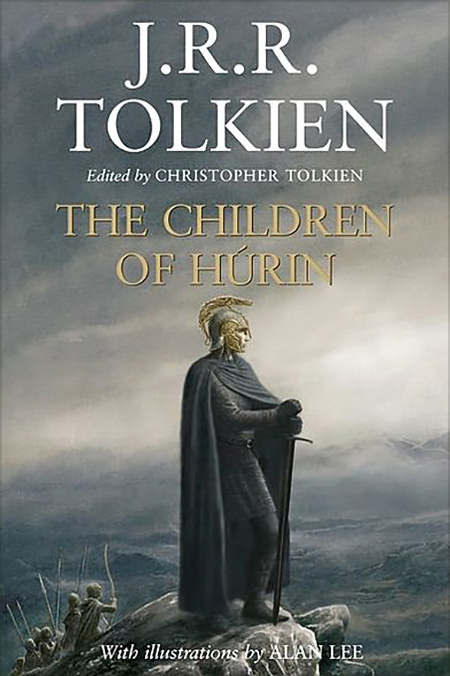
views
image044a

views
image044b
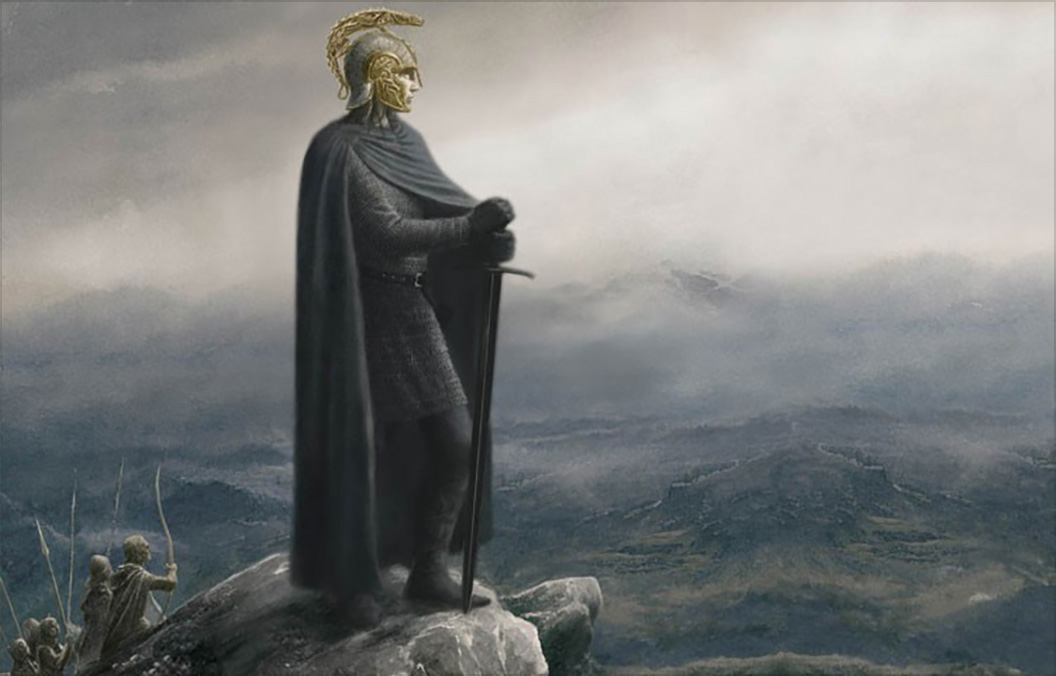
views
image044c

On June 19th., 2014, Harper Collins released a one volume Hardcover edition of ‘The Lord of the Rings’ to commemorate the 60th. Anniversary of the very first printing of ‘The Lord of the Rings’ in 1954. The following Product Details have been borrowed from Harper Collins Publishers’ own website: https://www.harpercollins.co.uk/9780007525546/the-lord-of-the-rings
“A sumptuous new one-volume edition of Tolkien’s classic masterpiece that is fully illustrated throughout in watercolour by the acclaimed and award-winning artist, Alan Lee, and housed in a special transparent slipcase. Since it was first published in 1954, The Lord of the Rings has been a book people have treasured. Steeped in unrivaled magic and other worldliness, its sweeping fantasy has touched the hearts of young and old alike. Well over 100 million copies of its many editions have been sold around the world, and occasional collectors’ editions become prized and valuable items of publishing.
With the epic trilogy now an acclaimed, award-winning and billion-dollar success, images of the characters and landscapes have become iconic to a whole new generation of readers. Much of the look of these movies is based on Alan Lee’s paintings, giving this sumptuous new edition of Tolkien’s great work new relevance for the ever-growing number of fans.
This new edition includes all 50 of Alan Lee’s beautiful watercolour paintings that have been newly scanned by the artist himself, together with his stunning frontispiece painting that appears in full, for the very first time, as a three-page foldout sheet. The text has been reset using the definitive 50th anniversary text and is printed on high-quality paper, and this is accompanied by Tolkien’s own maps, which are printed in red & black as endpapers. The unjacketed book features illustrated boards and includes a silk ribbon marker, and is housed in a special transparent slipcase; together with Alan’s beautiful paintings, this new presentation of this landmark work provides the reader with the ultimate edition with which to celebrate the 60th anniversary of its first publication.”
image045

image045a

1 view
image045b
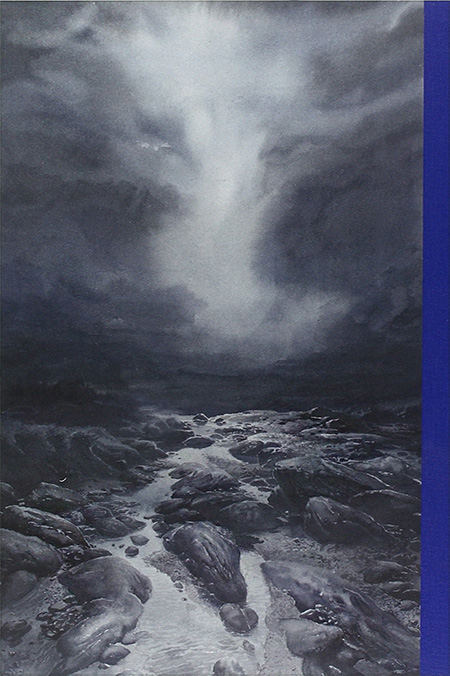
1 view
image045c
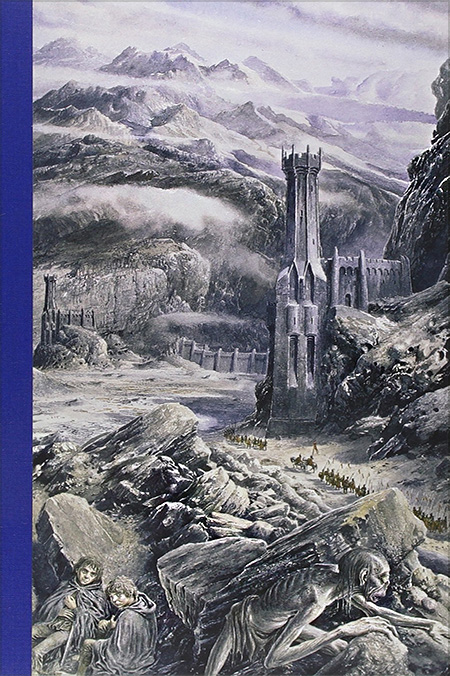
image045d

2 views
image045e

On June 1, 2017 both Houghton Mifflin and Harper Collins released a one volume Hardcover edition of ‘Beren and Luthien’ edited by Christopher Tolkien with a dust jacket and illustrations by Alan Lee. The Paperback edition of ‘Beren and Luthien’ was released by Mariner Books, a division of Houghton Mifflin Harcourt, on March 6, 2018. Harper Collins’ Paperback edition of ‘Beren and Luthien’ was also released on March 6, 2018. The coloring of the dust cover illustration on the Hardcover edition does appear to have been altered somewhat from Alan’s original painting as shown below. The coloring of the cover illustration on the Paperback edition (shown on the right) is almost a mirror image of his original painting.
image045z
![[spacer]](https://www.lotrarts.com/../images/gallery/showcase/alan-lee/image045zz.png)
[spacer]
image045zz

image046

image047
![[spacer]](https://www.lotrarts.com/../images/gallery/showcase/alan-lee/image047bg.png)
[spacer]
image047bg
![[spacer]](https://www.lotrarts.com/../images/gallery/showcase/alan-lee/image047bh.png)
[spacer]
image047bh

views
image048

views
image050
![[spacer]](https://www.lotrarts.com/../images/gallery/showcase/alan-lee/image049bg.png)
[spacer]
image049bg
![[spacer]](https://www.lotrarts.com/../images/gallery/showcase/alan-lee/image049bh.png)
[spacer]
image049bh

image049

image051
![[spacer]](https://www.lotrarts.com/../images/gallery/showcase/alan-lee/image051bg.png)
[spacer]
image051bg

Beginning in the year 1987 and commencing to this very day, several publishers have used the illustrations of Alan Lee for their Tolkien Calendars.
The 1987 J.R.R. Tolkien Calendar was published by Ballantine Books, a division of Random House, for distribution in the United States. Alan Lee provided illustrations for the months of April and July.
![[spacer]](https://www.lotrarts.com/../images/gallery/showcase/alan-lee/image099zzz.png)
[spacer]
image099zzz
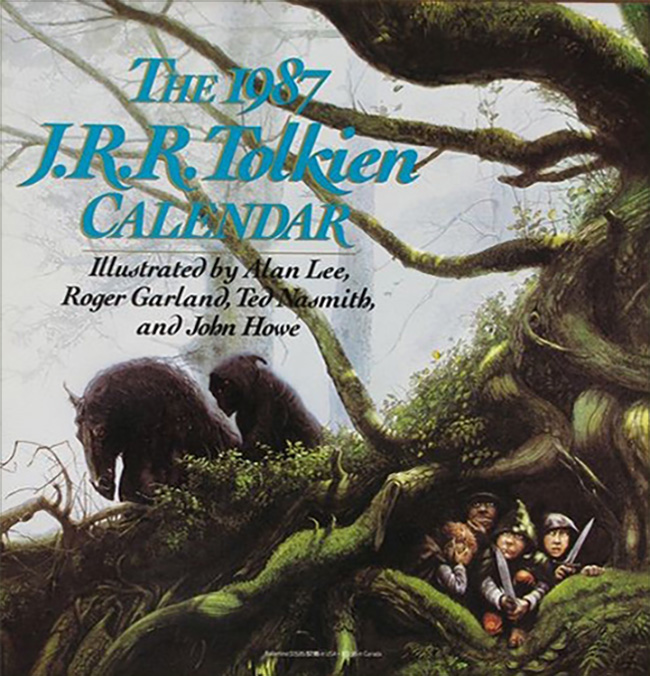
3 views
image100
![[spacer]](https://www.lotrarts.com/../images/gallery/showcase/alan-lee/image100zzz.png)
[spacer]
image100zzz

April – Minas Tirith based on ‘The Fellowship of the Ring’
image100zzzz

2 views
image102

3 views
image103

July – Barad-dur based on ‘The Return of the King’
image103zz

1 view
image104

2 views
image105
![[spacer]](https://www.lotrarts.com/../images/gallery/showcase/alan-lee/image105ddd.png)
[spacer]
image105ddd

2 views
image101
![[spacer]](https://www.lotrarts.com/../images/gallery/showcase/alan-lee/image105hhh.png)
[spacer]
image105hhh

The Tolkien Calendar 1987 in the United Kingdom was published by Unwin Hyman Ltd. It featured the same 12 illustrations as the American release. Only the cover was changed and featured October’s illustration by John Howe of the Lieutenant of the Tower of Barad-dur based on ‘The Return of the King’.
image105zz
![[spacer]](https://www.lotrarts.com/../images/gallery/showcase/alan-lee/image105zzz.png)
[spacer]
image105zzz
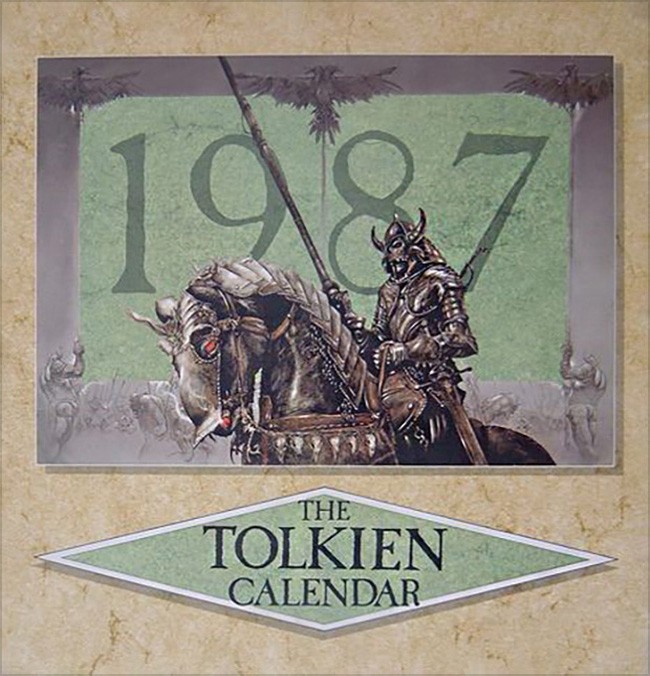
1 view
image106b
![[spacer]](https://www.lotrarts.com/../images/gallery/showcase/alan-lee/image106zzz.png)
[spacer]
image106zzz

The Tolkien Calendar 1993 was the official Tolkien calendar published for distribution in the United Kingdom by Grafton Books, a division of Harper Collins, on July 9, 1992. It features 12 of Alan Lee’s finest color illustrations based on The Lord of the Rings.
The American edition of The Tolkien Calendar 1993 was published by Ballantine Books, a division of Random House, also on July 9, 1992. It features the same 12 Alan Lee illustrations that were used for the Grafton Books calendar in the United Kingdom. Only the cover was changed for the American calendar. It featured January’s illustration of ‘Frodo and Gandalf’.
image106zzzz

1 view
image107

1 view
image108

January - "Frodo and Gandalf" 1 view
image109

February - "The Dark Riders"1 view
image110

March - "Rivendell"1 view
image111

April - "Galadriel's Mirror"1 view
image112

May - "Tol Brandir"
image113

June - "Treebeard"
image114
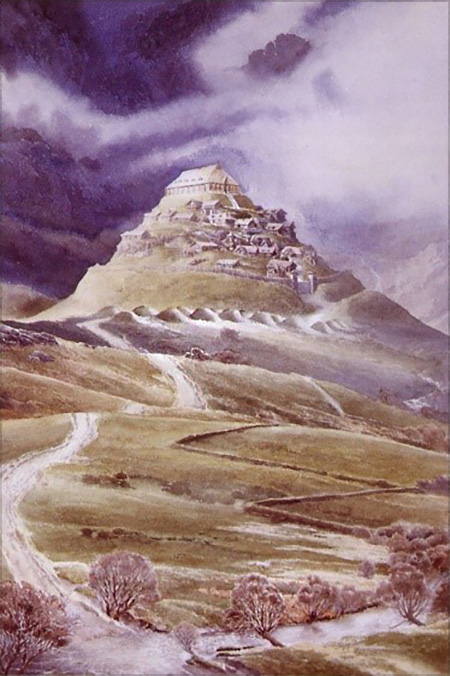
July - "The Golden Hall"
image115

August - "The Battle of the Hornburg"
image116

September - "The Oliphaunt"1 view
image117

October - "Shelob"2 views
image118
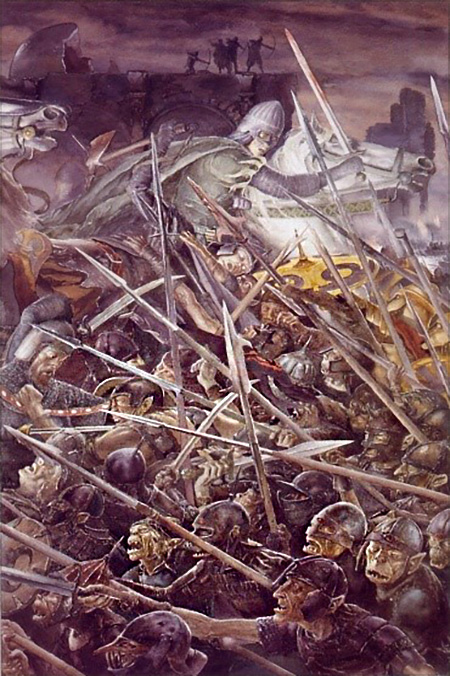
November - "The Siege of Gondor"
image119

December - "Orcs on the Road"1 view
image120

The Tolkien Calendar 1999 was the official Tolkien calendar published by HarperCollins on 15 June 15, 1998. It features art by Alan Lee based on The Hobbit.
image120z
![[spacer]](https://www.lotrarts.com/../images/gallery/showcase/alan-lee/image120zzz.png)
[spacer]
image120zzz
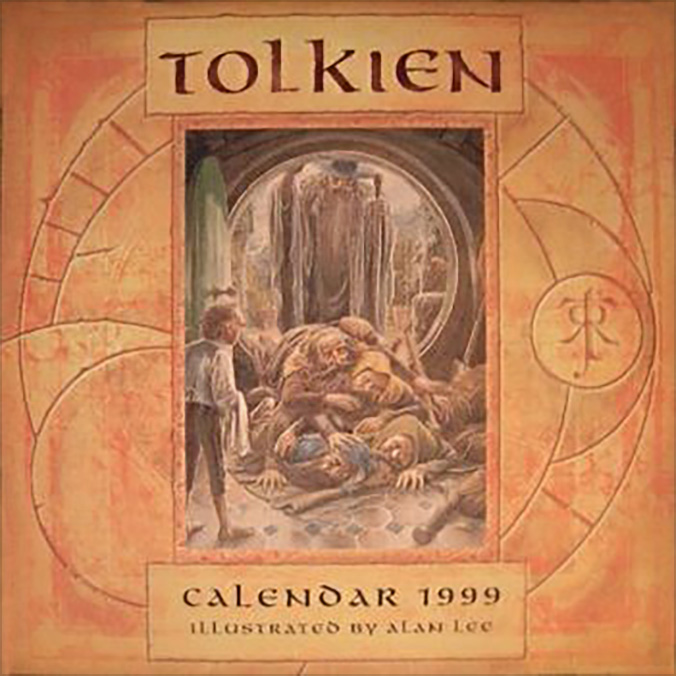
1 view
image121
![[spacer]](https://www.lotrarts.com/../images/gallery/showcase/alan-lee/image121zzz.png)
[spacer]
image121zzz

January - "The Wargs"
image122

February - "The Desolation of the Dragon"1 view
image123
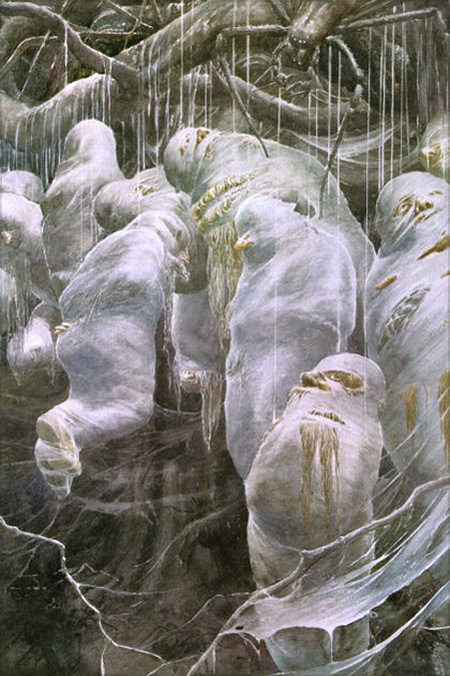
March - "Flies and Spiders"1 view
image124

April - "Thorin, King Under the Mountain"1 view
image125

May - "Rivendell"
image126

June - "The Carrock"
image127
![[spacer]](https://www.lotrarts.com/../images/gallery/showcase/alan-lee/image127zz.png)
[spacer]
image127zz
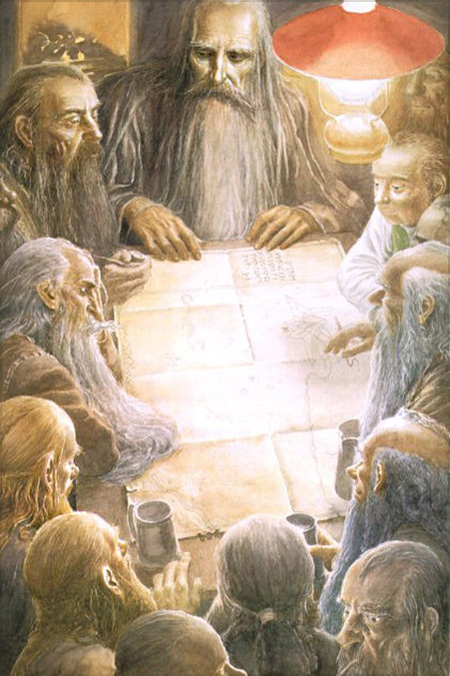
Centrefold - "Thror's Map"
image128
![[spacer]](https://www.lotrarts.com/../images/gallery/showcase/alan-lee/image125zz.png)
[spacer]
image125zz

July - "The Elven King's Gate"
image129

August - "An Unexpected Party"1 view
image130

September - "Lake Town"
image131

October - "The Goblins"
image132

November - "The Wrath of Smaug"
image133

December - "The Kingdom Under the Mountain"1 view
image134

The Tolkien Calendar 2007 was the official Tolkien calendar published by HarperCollins on June 19, 2006. It features art by Alan Lee based on ‘The Lord of the Rings’.
image134zz
![[spacer]](https://www.lotrarts.com/../images/gallery/showcase/alan-lee/image134zzz.png)
[spacer]
image134zzz

image135
![[spacer]](https://www.lotrarts.com/../images/gallery/showcase/alan-lee/image135zzz.png)
[spacer]
image135zzz
![[spacer]](https://www.lotrarts.com/../images/gallery/showcase/alan-lee/image135zzzc.png)
[spacer]
image135zzzc

January - "Frodo and Gandalf"
image136

February - "The Withywidle"
image137
![[spacer]](https://www.lotrarts.com/../images/gallery/showcase/alan-lee/image137zc.png)
[spacer]
image137zc
![[spacer]](https://www.lotrarts.com/../images/gallery/showcase/alan-lee/image137zcc.png)
[spacer]
image137zcc

March - "Weathertop1 view
image138
![[spacer]](https://www.lotrarts.com/../images/gallery/showcase/alan-lee/image138zcc.png)
[spacer]
image138zcc
![[spacer]](https://www.lotrarts.com/../images/gallery/showcase/alan-lee/image138zzz.png)
[spacer]
image138zzz

April - "Rivendell"
image139
![[spacer]](https://www.lotrarts.com/../images/gallery/showcase/alan-lee/image139zzz.png)
[spacer]
image139zzz
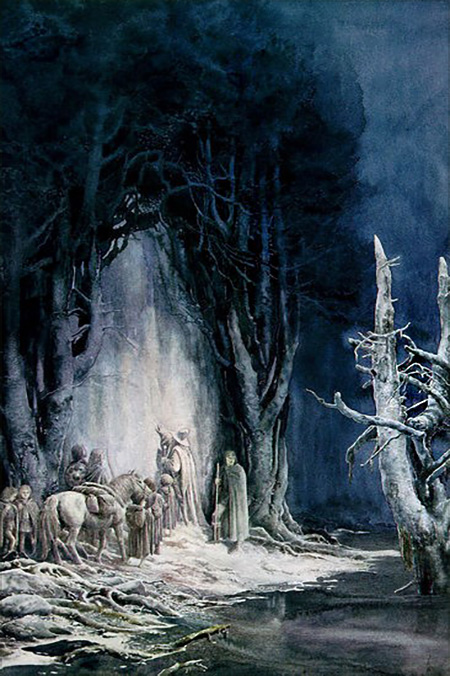
May - "The Doors of Durin"
image140
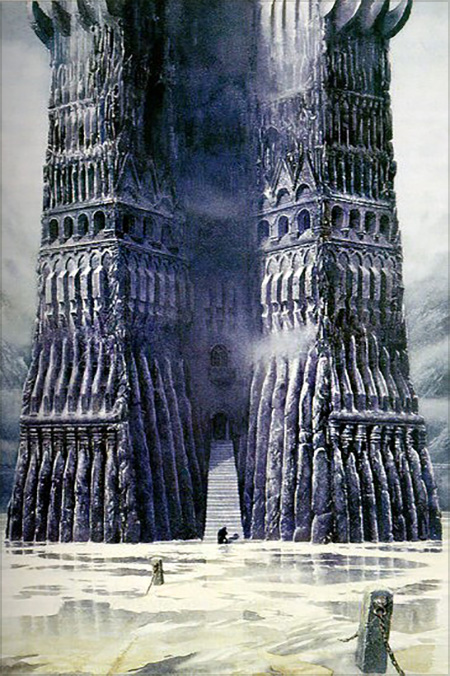
June - "Orthanc"
image141

July - "Treebeard"1 view
image142
![[spacer]](https://www.lotrarts.com/../images/gallery/showcase/alan-lee/image142zzz.png)
[spacer]
image142zzz
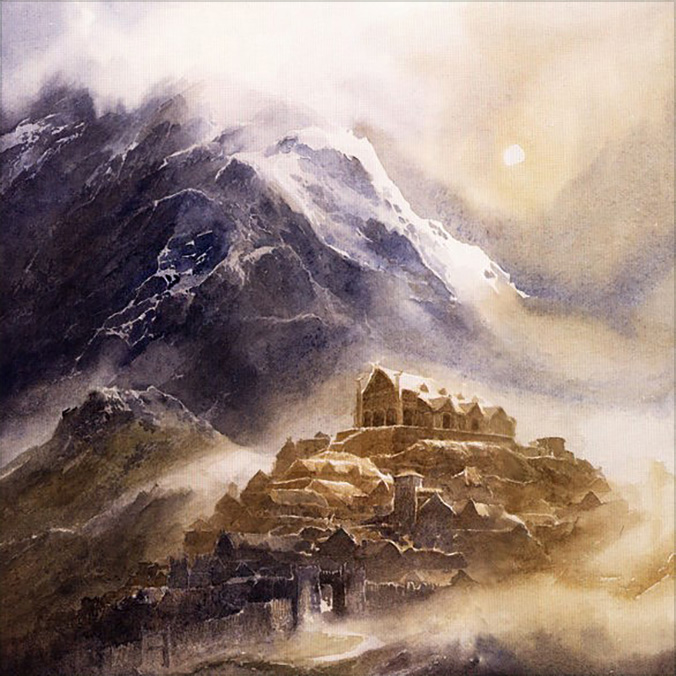
August - "Edoras"
image143
![[spacer]](https://www.lotrarts.com/../images/gallery/showcase/alan-lee/image143zzz=.png)
[spacer]
![[spacer]](https://www.lotrarts.com/../images/gallery/showcase/alan-lee/image143zzzz.png)
[spacer]
image143zzzz

September - "The Lord of the Nazgûl"
image144

October - "The Battle of the Pelennor Fields"
image145
![[spacer]](https://www.lotrarts.com/../images/gallery/showcase/alan-lee/image145zzzz.png)
[spacer]
image145zzzz

November - "Mount Doom"
image146

December - "The Grey Havens"1 view
image147

Each of the Date pages are also graced with several of Alan Lee’s sketches.
image147zz

image148

image149

image150

image151

image152

image153
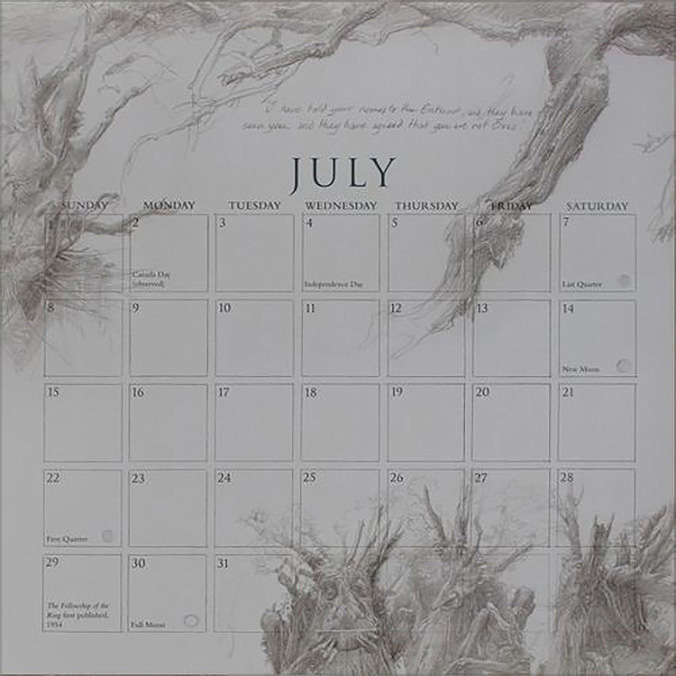
image154

image155

image156
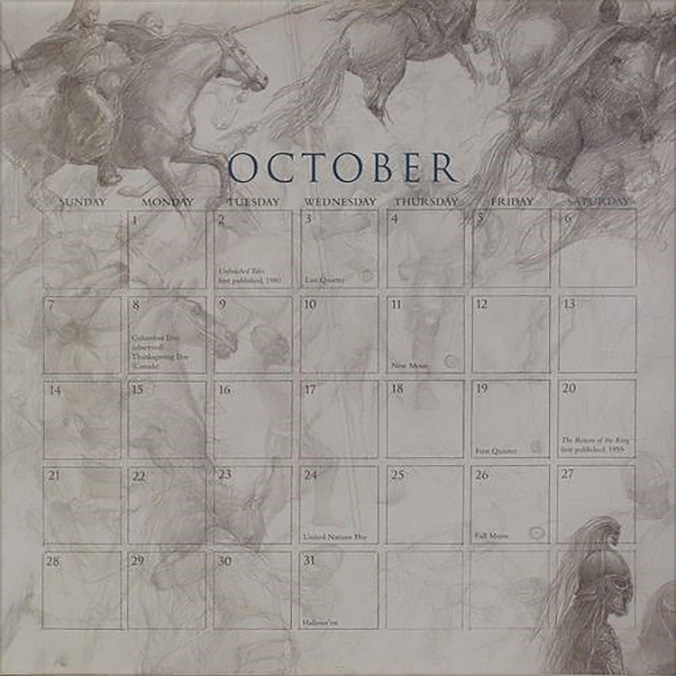
image157

1 view
image158

image159

The Tolkien Calendar 2008 was the official Tolkien calendar published by HarperCollins on July 2, 2007. It features art by Alan Lee based on ‘The Children of Húrin’.
From the publisher: ”The official Tolkien calendar, this year containing 12 of the finest watercolours by Alan Lee, selected from ‘The Children of Hurin’ by J.R.R. Tolkien and other works illustrated by Alan, and accompanied by numerous pencil sketches, many unique to this calendar.
The Tolkien calendar has become an established publishing event, eagerly looked forward to by Tolkien fans the world over. This year's is more sumptuous than ever, and is not only illustrated by the acclaimed and Oscar-winning Tolkien artist, it has been designed by him, too, with the same care and attention to detail that has seen his work embraced by the Tolkien Estate, Peter Jackson and discerning fans around the world. The content itself is particularly special, as it is inspired by a Tolkien work that is seeing print in its complete form for the very first time.
To accompany each watercolour painting from ‘The Children of Hurin’, the newly published epic tale of adventure by J.R.R. Tolkien, every month features complementary pencil drawings selected by Alan and there are also brand new sketches produced exclusively for this calendar.
Alan Lee has depicted famous scenes including Gollum and Bilbo, Rivendell and Smaug the Dragon in his celebrated illustrated editions of ‘The Hobbit’ and ‘The Lord of the Rings’, but with these brand new paintings and drawings he will take the reader deeper into the enchanting world of Middle-earth than ever before.”
image159zz
![[spacer]](https://www.lotrarts.com/../images/gallery/showcase/alan-lee/image159zzz.png)
[spacer]
image159zzz

1 view
image160
![[spacer]](https://www.lotrarts.com/../images/gallery/showcase/alan-lee/image160zzz.png)
[spacer]
image160zzz
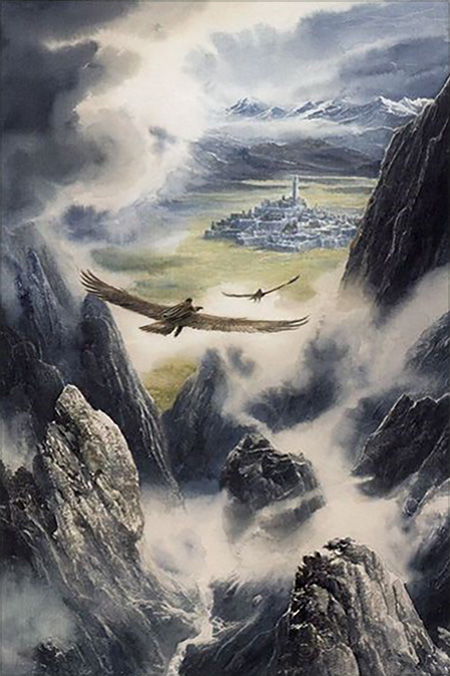
January - "Húrin and Húor are Carried to Gondolin"
image161

February - "The Gates of Angband"1 view
image162

March - "The Words of Húrin and Morgoth"
image163

April - "Beleg Departs from Menegroth"
image164

May - "Amon Rûdh"1 view
image165

June - "Túrin, Lord of Dor-Cúarthol"
image166

July - "The Reforging of Anglachel"
image167

August - "The Coming of Túrin into Brethil"
image168

September - "The Journey of Morwen and Níenor to Nargothrond"
image169

October - "Mablung Approaches the Doors of Nargothrond"
image170

November - "The Coming of Glaurung"
image171
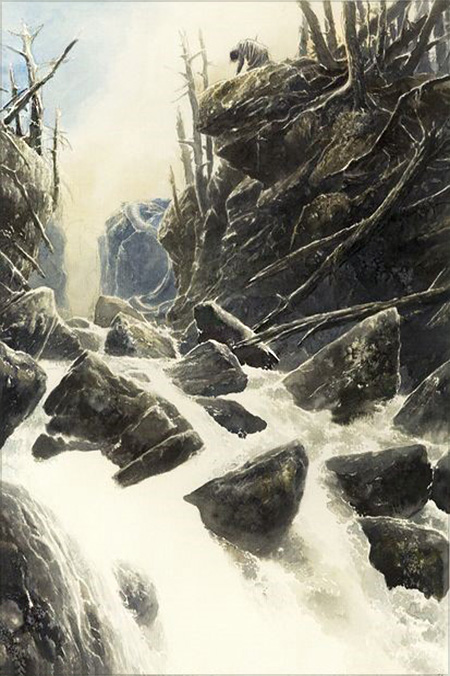
December - "The Death of Túrin"
image172

Tolkien ‘The Hobbit’ Official Calendar 2013, published by Harper Collins and illustrated by Alan Lee and John Howe, features cover art by both illustrators on opposite sides of the calendar.
image172zz

image173

image174

Alan Lee’s illustrations are shown for the months of February, April, June, August, October and December
image174zz

February – “Bilbo Outside Bag End”
image175
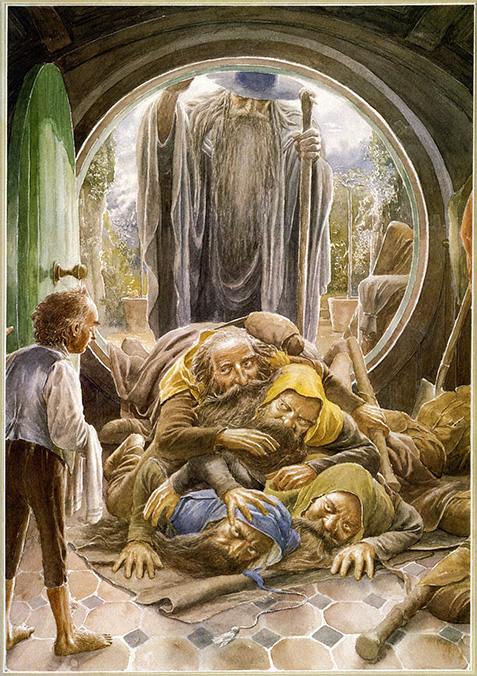
April – “An Unexpected Party”1 view
image176

June – “Hobbit And Dwarfs Crossing Bridge”
image177

August – “Riddles In The Dark”
image178

October – “The Wargs”1 view
image179

December – “Burial of Thorin Oakenshield”
image180

On August 31, 2017, Harper Collins published The Tolkien Calendar 2018, the official Tolkien calendar, this year containing twelve of the finest water colours by Alan Lee, selected from ‘BEREN AND LUTHIEN’ by J.R.R. Tolkien, and accompanied by numerous pencil sketches, many unique to this calendar. I was hoping I would be able to provide everyone with scans of all twelve of Alan’s illustrations from the Tolkien Calendar 2018 but unfortunately I have only been able to locate the three shown below online.
image180zz

image181
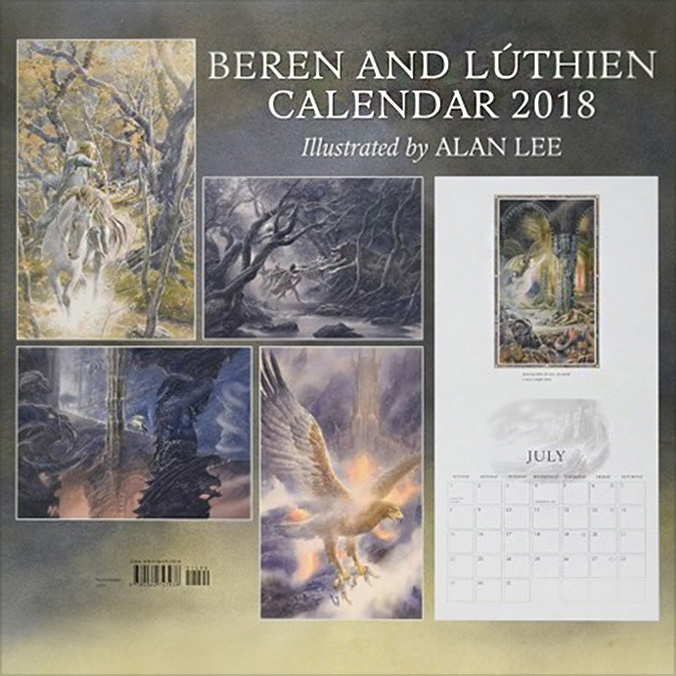
image182

image183

image184

image185

Alan Lee’s illustrations of J.R.R. Tolkien’s books, particularly the Centenary Edition of ‘The Lord of the Rings’ in 1991, did not escape the attention of Peter Jackson, the film producer and director. In an interview conducted on January 24, 2006 with Laura Joint of the British Broadcasting Company, Alan reveals how he was first recruited to become one of the lead conceptual artists for ‘The Lord of the Rings’ film project and discusses his work while serving in that capacity. It makes for an insightful and entertaining read and for those reasons I will repeat most of that interview here and now:
“Step into Alan Lee's Dartmoor cottage, and it's a bit like walking into Tolkien's imaginary world. Alan lives and breathes the work of JRR Tolkien. It's not just his job...it's his life. Everywhere, there are paintings, drawings, and sculptures from The Lord of the Rings. On the coffee table, there is even a Lord of the Rings mug, from which the world-renowned artist sips his coffee. Most of the pictures on display are Alan's own creations. After illustrating the special centenary book of JRR Tolkien's classic tale in 1992, Alan was asked to provide the artwork for the sets of Peter Jackson's Lord of the Rings trilogy - he won an Oscar for his work on the third movie, Return of the King. The downstairs rooms of his house are where he works in the winter. During the summer months, he moves into his studio out the back - a stone barn, again brim-full with books and pictures. So how did he end up here, in the middle of Dartmoor, which let's face it is light years away from the Hollywood life?”
Alan explained: “I was living in London until 1975 and came down to visit some friends in Thornworthy on Dartmoor, and had the most wonderful weekend with my partner and just fell in love with the place. Walking through the woods and by the river, I just saw everything I would ever want to put into a picture. I just thought I could spend a life actually drawing all this. I love the moss-covered boulders and trees and it seems the stuff of legends really. So we stayed an extra day and looked at some houses and this was one of the houses that we looked at and decided to make an offer for it - that day! So it was all done in the weekend."
“The moorland landscape has proved a major source of inspiration during Alan's career as a book illustrator and, latterly, as a concept artist for films like The Lord of the Rings.”
"I've used Dartmoor in my work a huge amount," said Alan. "Whenever I can, I go for walks and I take photographs and do lots of drawings as well. So there are lots of trees I have sat and drawn which have ended up in various illustrations. Just the whole kind of mood of it, and the fantastic details that you get in the amount of moss and lichen that encrust the trees and it's just a wonderful source of material." “Alan was asked by publishers Harpers Collins to illustrate the special centenary edition of The Lord of the Rings in 1992, which was released to mark the 100th anniversary of the author's birth. It was an unbelievable opportunity come true for the self-confessed Tolkien fanatic.” "I had read The Lord of the Rings when I was about 17 and really just inhabited that world for a number of years afterwards. I just loved the whole world that he created and so it was a dream come true really to get the chance to illustrate the books later on." “It was the drawings in this centenary book which attracted the attention of Lord of the Rings director, Peter Jackson. One day, the postman delivered a parcel to Alan's home which would change his life forever:” "Peter Jackson had been gathering visual material while working on the script and amongst that was my book. So they were using the book when they were going through the adaptation and occasionally they would look at the pictures and think: 'We should see if we could get somebody like Alan to come out and work on the films.' And then they made a leap to thinking well, perhaps we should ask to see if Alan is available. So one day, I was sitting in my studio and I got a parcel containing two videos - Heavenly Creatures and Forgotten Silver, and a letter outlining their (Peter Jackson and Fran Walsh, the screenwriter who co-wrote Lord of the Rings) plans for making The Lord of the Rings and asking if I'd like to be involved. So I phoned back, after watching the videos because I was really curious. I hadn't actually heard of Peter Jackson. We had a great conversation and I agreed to go out to New Zealand and work with him, along with another illustrator, John Howe." “Alan headed off to New Zealand, where the Lord of the Rings trilogy was filmed - little did he know he would be there for six years.” “It was also a huge culture shock working with hundreds of people, instead of sitting alone in his Dartmoor studio.” "When I first went out, the film didn't have the green light at that stage” said Alan. "It was in pre-production and the film company, Miramax weren't quite committed to it. They were biding their time, funding it on a week-by-week basis. But they weren't saying one way or another whether they were going to make the film. So we didn't know if it was actually going to be made. We estimated I'd be out there for six months to begin with, just working on conceptual designs but in the end I worked there for six years and got involved with every aspect of the design of the films, with going from conceptual design onto working with the art department actually designing the sets and props. And then, once the shooting had finished, working with the visual effects department on designing effects shots. It was an extraordinary experience and I don't think anything quite like it will happen again. Making three films all at once hadn't been done before, and I think it's unlikely to happen again. It was just almost impossible. It's a tremendous tribute to Peter's energy and perseverance. I think we all felt that we were on the point of failure at any given moment. It felt like touch and go for so much of the time." “Alan's job was to interpret Tolkien's descriptions, and bring them to life:” "I think I do it quite intuitively. I do respond when I'm reading something. I get quite a strong - not a detailed picture - but quite a strong sense of atmosphere. I did about 2,500 or so sketches during the time I was in New Zealand, and not very much painting because there just wasn't enough time really to finish paintings. But I could do several fairly detailed sketches in a day and they would either be in sketchbooks or on little scraps of paper, or a lot of them were large drawings which I would do and then show to Peter and to Grant Major, the production designer, and get his feedback. There would be quite a lot of to-ing and fro-ing to actually get the design that worked for everyone. It was really trying to tease out the images that Peter had in his mind and to help him to create the kind of film that he wanted. As we got into the project I think I became more familiar with the kind of ideas and the way that Peter liked to work, the way he liked to use the camera and so would get there more quickly and often would just do one drawing that Peter would say that's great, and that would be the starting point. And then there would be dozens of drawings showing every conceivable angle and every detail. I was trying to summon up what Tolkien was describing and I think that Peter and Fran and the casting directors were trying to do the same thing and we both came up with same kind of ideas.”
I thought it was a brilliant cast, very well chosen."
“After coming up with the artwork, Alan then watched to make sure the sets matched his images:”
"I would look at the sets as they were being constructed. It was a continual process of feedback. Because we were so busy - we had so many sets to build - about 400 altogether for all three films - and so at any one time, there would be at least 10 sets being built and several being filmed. I'd find I'd be walking around, looking at the sets, and there would be constant questions about what a particular detail would look like, so I'd be walking around with my sketchbook, running off very quick little sketches of detail, getting them copied and sent to the sculptors and various craftsmen who were building the scene." “One of the sculptors was Alan's daughter, Virginia, who spent two years working on the films in New Zealand. One of her Lord of the Rings sculptures sits proudly on Alan's lounge mantelpiece. Alan received the ultimate accolade for his work on the movies, when he won an Oscar for the third film, Return of the King. He remembers that night as though it were yesterday.”
"It was a most glorious evening, not just for us in the art department, but there were 11 other awards as well for the Lord of the Rings and it was just fantastic to see, time and time again, people and friends from New Zealand going up to collect their Oscars. It was great.”
“The Oscar wasn't the only accolade Alan received - Peter Jackson was fulsome in his praise for his work, commenting: "Alan Lee's artwork has a beauty and lyricism about it. His art captured what I hoped to capture with the films." After six years in New Zealand, Alan returned to his Dartmoor home in 2004. In 2005, he published The Lord of the Rings Sketchbook, featuring a selection of his work from the centenary edition and the movies.”
Laura Joint’s entire interview with Alan lee may be viewed here: http://www.bbc.co.uk/devon/content/articles/2006/01/23/alan_lee_feature.shtml
While working in New Zealand during the filming of ‘The Lord of the Rings trilogy, Alan Lee would also make two cameo appearances, in the opening sequence of ‘The Fellowship of the Ring’ as one of the nine kings of men who became the Nazgûl, and in ‘The Two Towers’ as a Rohan soldier in the armory (over the shoulder of Viggo Mortensen as Aragorn and Legolas talk in Elvish). Both Alan Lee and John Howe would have cameo roles in “The Hobbit: The Desolation of Smaug” as musicians in a little band in front of Stephen Fry, playing the Master of Laketown.
A film adaptation of J. R. R. Tolkien's novel The Hobbit (1937) was in development for several years after the critical and financial success of ‘The Lord of the Rings’ film trilogy (2001–2003), co-written, co-produced, and directed by Peter Jackson. When work commenced of the filming of ‘The Hobbit’ trilogy, Alan Lee and John Howe were recruited by director Guillermo del Toro in 2008 for continuity of design in the subsequent ‘The Hobbit’ films, before joining Jackson when he took over the Hobbit films project. Jackson was initially going to produce a two-film adaptation of ‘The Hobbit’, which was to be directed by Guillermo del Toro. Del Toro left the project in May 2010, after about two years of working with Jackson and his production team, due to delays caused in part by financial problems at Metro-Goldwyn-Mayer. Jackson was announced as director that October. ‘The Hobbit’ films were produced back to back, like ‘The Lord of the Rings’ films. Principal photography for ‘The Hobbit’ films began on March 21, 2011 in New Zealand and ended on July 6, 2012, after 266 days of filming. Pick-ups for “An Unexpected Journey’ were filmed in July 2012 as well. Work on the film was expected to be completed on November 26, just two days prior to the film's Wellington premiere. Peter Jackson would later comment that Del Toro's sudden exit created problems as he felt he had inadequate preparation time which led to him shooting the films with unfinished scripts and without storyboards.
Alan Lee would spend another six years, from 2008 to 2014, in New Zealand while working as one of the lead conceptual artists for 'The Hobbit’ trilogy. Surprisingly, one of Alan’s most challenging tasks while working on the 'The Hobbit’ trilogy was actually drawing Hobbits. In his own words:
“In illustrating ‘The Lord of the Rings’ I allowed the landscapes to predominate. In some of the scenes the characters are so small they are barely discernible. This suited my own inclinations and my wish to avoid, as much as possible, interfering with the pictures being built up in the reader’s mind, which tends to be more closely focused on characters and their inter-relationships. I felt my task lay in shadowing the heroes on their epic quest, often at a distance, closing in on them at times of heightened emotion but avoiding trying to re-create the dramatic highpoints of the text. With ‘The Hobbit’, however, it didn’t seem appropriate to keep such a distance, particularly from the hero himself. I don’t think I’ve ever seen a drawing of a Hobbit which quite convinced me, and I don’t know whether I’ve gotten any closer myself with my depictions of Bilbo. I’m fairly happy with the picture of him standing outside Bag End, before Gandalf arrives and turns his world upside-down, but I’ve come to the conclusion that one of the reasons Hobbits are so quiet and elusive is to avoid the prying eyes of illustrators.”

'Bilbo at Bag End'6 views
image200
![[spacer]](https://www.lotrarts.com/../images/gallery/showcase/alan-lee/image200dd.png)
[spacer]
image200dd
![[spacer]](https://www.lotrarts.com/../images/gallery/showcase/alan-lee/image200ddd.png)
[spacer]
image200ddd

On illustrating Tolkien and remaining true to his visions, Alan would say: “It is quite a mine field treading through Tolkien’s world, but you somehow have to trust your own judgment and your own vision. Tolkien’s descriptions are so beautiful and poetic, yet he has left plenty of room for us to make our own little explorations.”
image200g

I can think of no better way to end this article on Alan Lee than by taking a look at the illustrations from his very own ‘The Lord of the Rings Sketchbook’ and by listening to his own spoken words in an interview he gave on ‘Icon’, a program CCTV-NEWS presented on May 7, 2016. In this interview, Lee discusses his role as an illustrator of Tolkien’s writings and as a conceptual artist for Peter Jackson’s ‘The Lord of the Rings’ and ‘The Hobbit’ film trilogies.
On September 5, 2005, Harper Collins published the Hardcover edition of Alan Lee’s ‘The Lord of the Rings Sketchbook’. As described by Harper Collins:
“A sumptuous large-format hardback containing sketches and paintings from the illustrated Lord of the Rings, together with brand new and previously unseen material.
In this large-format hardback Alan Lee reveals in pictures and in words how he created the images in the authorized illustrated edition of The Lord of the Rings. These images would prove so powerful, matching perfectly with Tolkien’s own vision, that they would eventually define the look of Peter Jackson’s movie trilogy and earn Alan a coveted Academy Award.
The book is filled with over 150 of his sketches and early conceptual pieces to show how the project progressed from idea to finished art. It also contains 20 colour paintings reproduced in full-page glory, together with numerous examples of his conceptual art produced for the films and brand new pieces drawn specially for this book. It also includes an exclusive foreword written by Sir Ian McKellen.
The Lord of the Rings Sketchbook provides a fascinating insight into the imagination of the man who painted Tolkien’s vision, firstly onto the page and then in three dimensions on the cinema screen. It will also be of interest to many of the 100,000 people who have bought the illustrated Lord of the Rings as well as for budding artists and illustrators interested in unlocking the secrets of book illustration.”
Note: The authorized illustrated edition of The Lord of the Rings referred to above in Harper Collin’s description of ‘The Lord of the Rings Sketchbook’ is the Centennial Edition published in 1991 to commemorate the 100th Anniversary of J.R.R. Tolkien’s birth.

2 views
image201
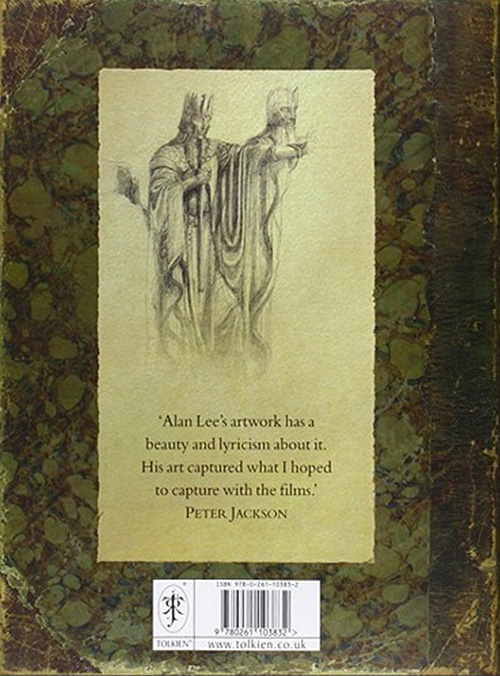
1 view
image202

'The Taming of Sméagol'2 views
image203

3 views
image204

'The Mirror of Galadriel'1 view
image205

image206

'The Shadow of the Past'
image207

3 views
image208

'Gandalf before Denethor'1 view
image209

image210
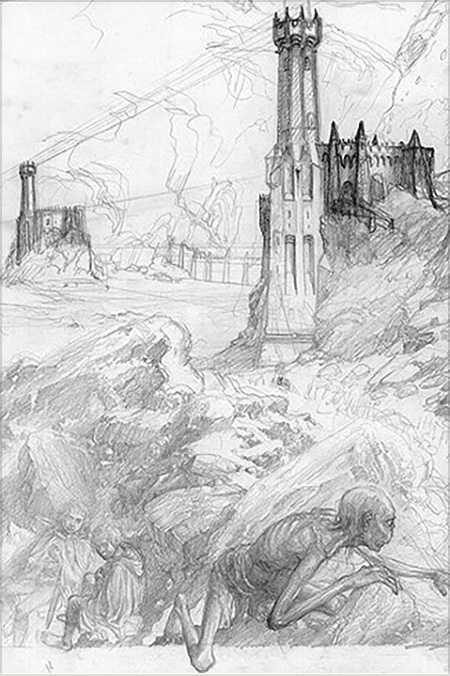
'The Black Gate'
image211
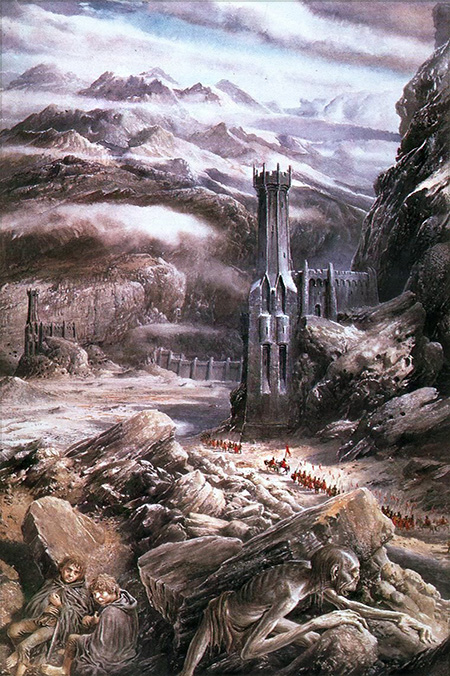
image212

image213

1 view
image214

image215

image216

image217
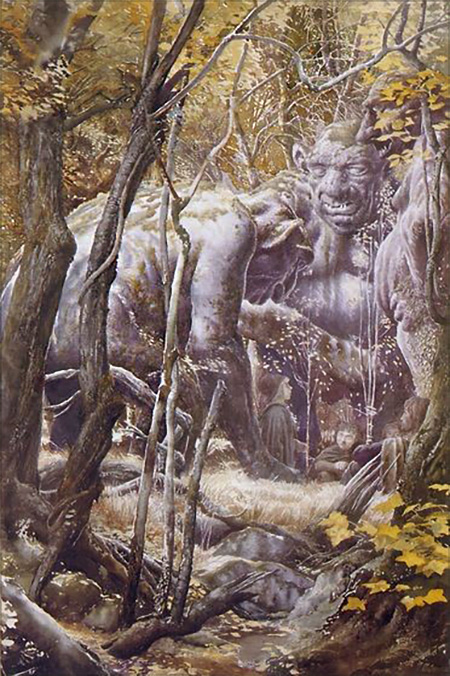
image218

image219

1 view
image220

image221

image222

image223

image224
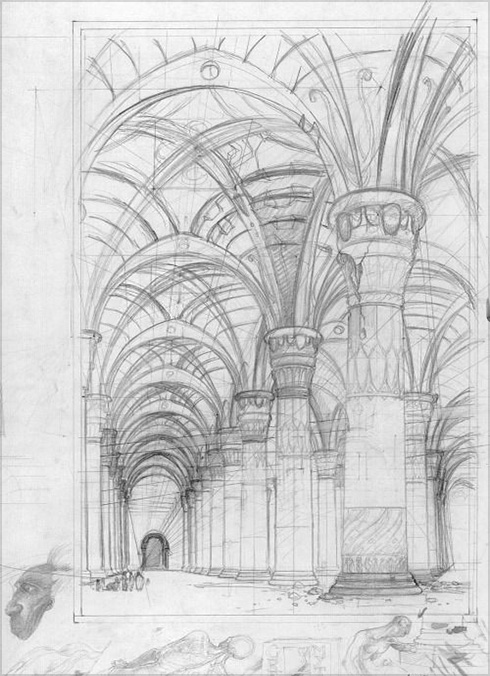
1 view
image225

image226

1 view
image227

image228

1 view
image229

image230

1 view
image231
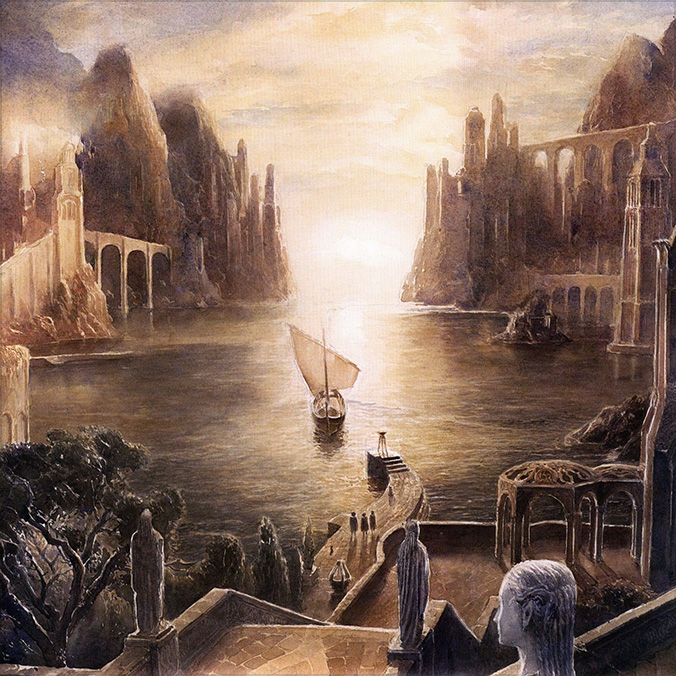
1 view
image232

image233

image234

image235

image236

1 view
image237

image238

image239
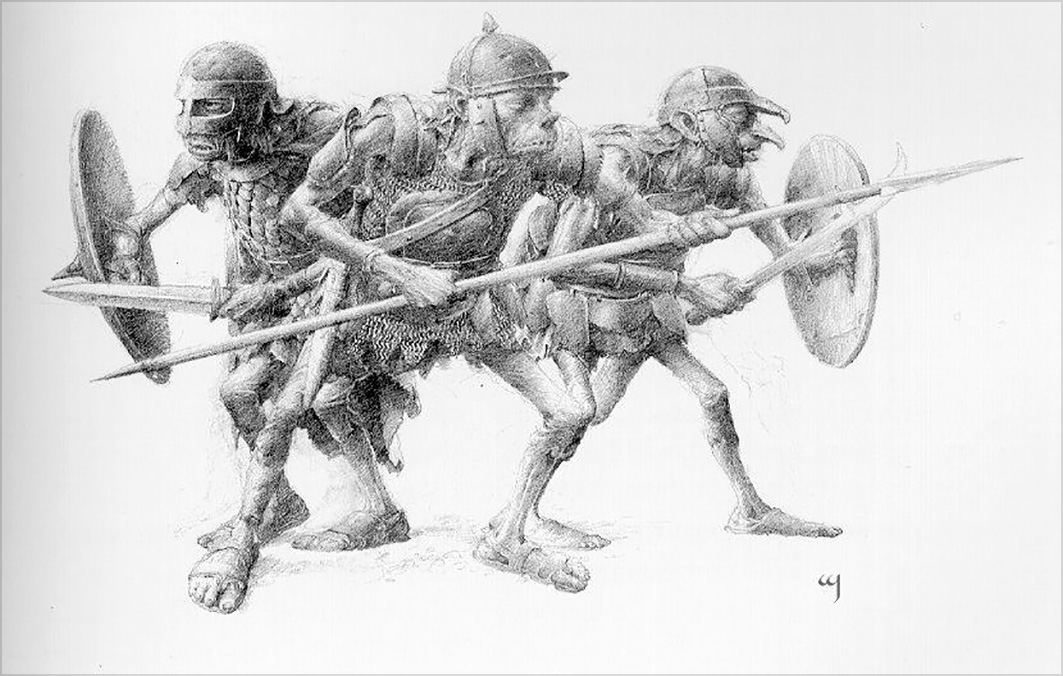
1 view
image240

1 view
image241

image242
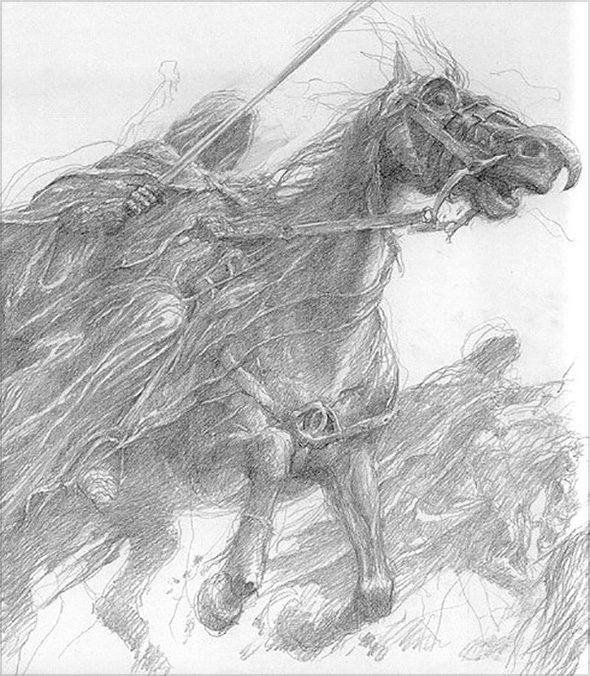
image243

image244
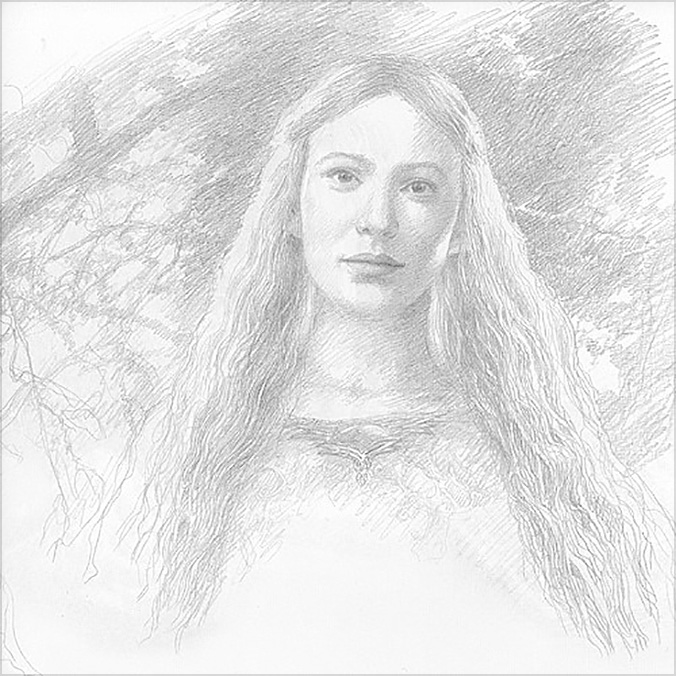
image245
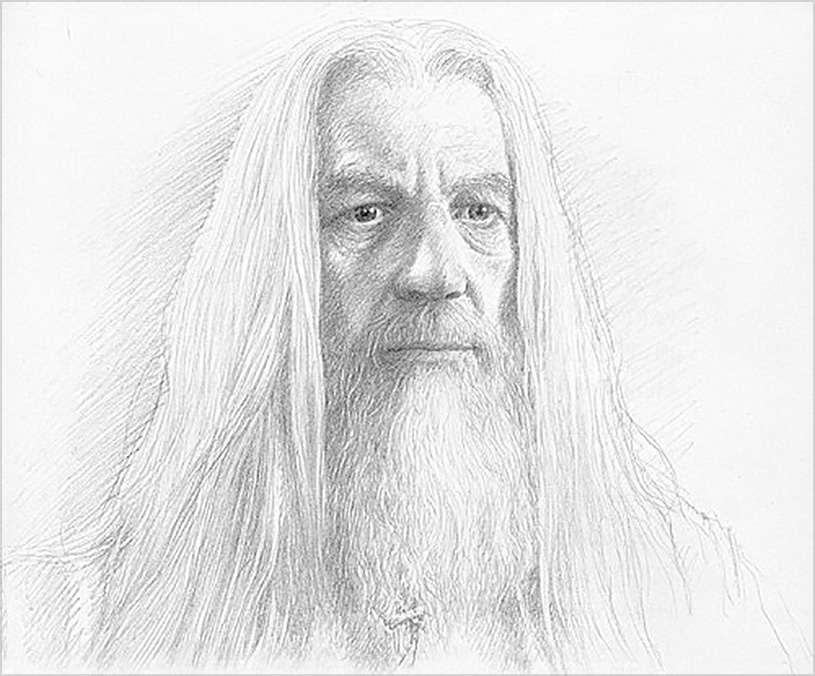
image246

image247

image248

image249

image250

image251
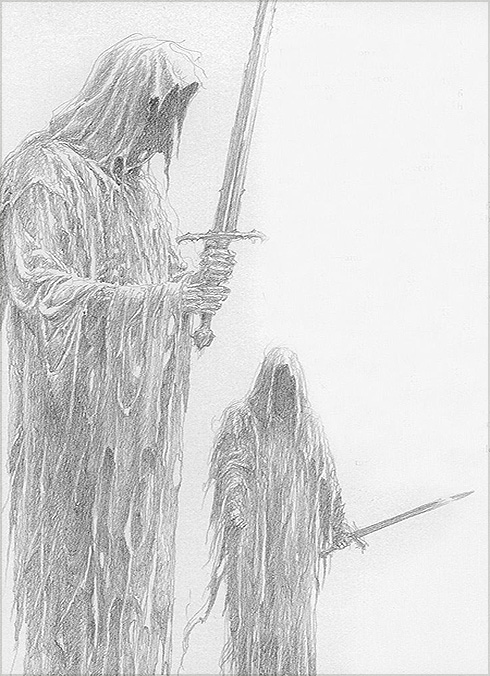
image252

image253

image254

image255

image256

1 view
image257

1 view
image258

1 view
image259

image260

1 view
image261
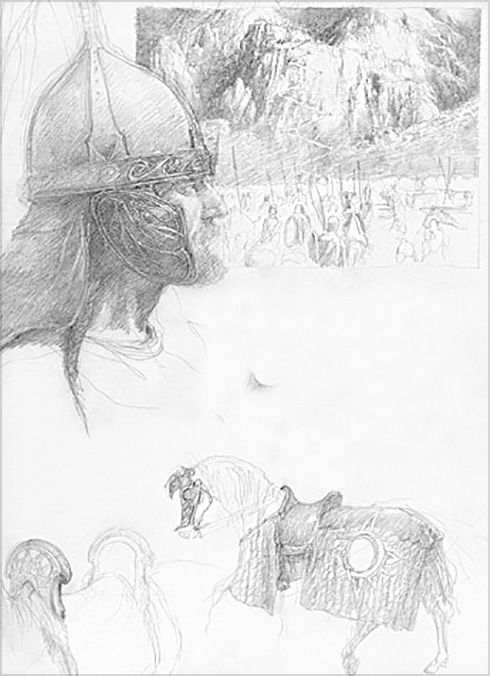
image262

image263

image264

image265

1 view
image266
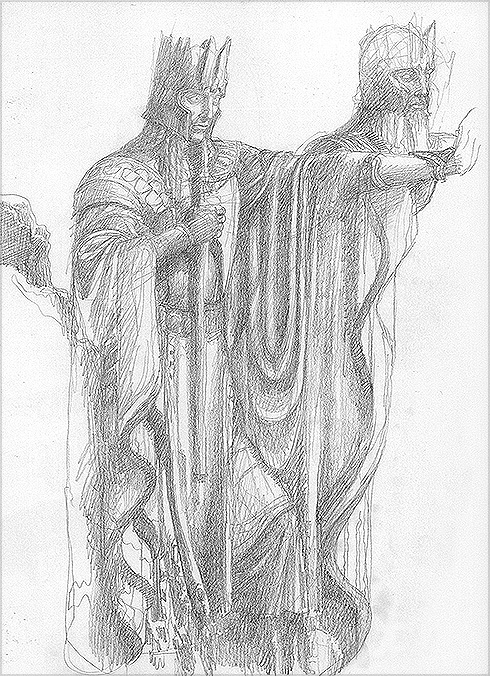
image267

image268

2 views
image269
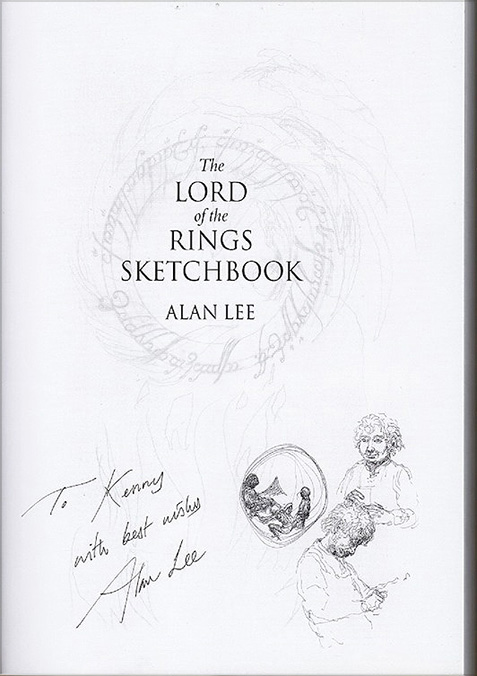
7 views
image270

4 views
image271

I) Spontaneous art
Tolkien was often spontaneous, writing and drawing on anything at any time. This art, doddles on scraps of paper, newspaper (when completing a crossword puzzle) or manuscript margins, recorded the very moments of his creativity. Often these were flowers or flowerlike forms (swirls of multi-colours), friezes etc.
Fortunately, due to Tolkien keeping his art, many of his ‘improvisions’ were catalogued, captioned and inscribed later.
views

Seemingly idle doodles across a newspaper article, involving coloured designs of a rudimentary nature, tear-drop paisley patterns, flower structures, some elven calligraphy, perspective layering, ray imagery and free-form abstract design, These appear to be preliminary workings for later development in assorted Middle-earth imagery.5 views

Doodling on an advertisement: Tolkien uses black, green and red ballpoint pens to make rudimentary swirling designs and blocking in patterns.2 views

Dating from the 1960s, this parsley doodle was done with coloured ball-point pens on the rental section of a newspaper.1 view

The doodle designs were often flower-like and precursors of Numenorean works of art.4 views

A black-and-white geometrical abstract design on a Christie's auction advertisement.5 views

Frieze design in geometrical pattern from 1960s.
Published in the JRR Tolkien Calendar 1979.3 views

Frieze in red, white, black and beige, with superimposed floral design. Design elements used in Middle-earth heraldic devices etc.
Published in the JRR Tolkien Calendar 1979.4 views

Pencil and ink conceptual sketch incorporating dwarves and dragons.4 views

Crown of Gondor
Conceptual sketch within Tolkien’s letter (211), an early concept description of the crown: ‘I think the crown of Gondor (the S. Kingdom) was very tall, like that of Egypt, but with wings attached, not set straight back but at an angle…’3 views

II) Symbolic, psychological, abstract and imaginative images
1. ‘Ishnesses’
Tolkien in an explosion of creativity explored what he called ‘ishnesses’ (H&S 1): visionary representations of imaginary realms, and states of mind or place. Tolkien was venturing to draw not what he saw in the outer world but what he felt/saw inside, seemingly answering a need to express himself through his art.
These covered concepts of: before, afterwards, beyond, eeriness, wickedness, weirdness, thinking, and time, the end of the world, ‘water, wind and sand’ etc. Many of these are featured below.
For all the illustrations in The Book of Ishness, there is no direct explanation of the content beyond their titles. However, many have surmised about the inner images Tolkien was depicting. A sample of these conjectures are provided with images.
These illustrations, entrancing and evocative, are in pencil, ink and watercolour.
views
![<i>Before</i>
<br/>
[Pencil, black and red coloured pencil]
<br/><br/>
Described as an ominous depiction of a dark man-made corridor flanked by flaming torches leading to a lit doorway glowing red. It has a sinister sense of foreboding, conjected to represent standing before a passage of darkness leading to a place of hope.<span class="ngViews">1 view</span>](https://www.lotrarts.com/../images/gallery/showcase/jrr-tolkien/jrr-tolkien-art-ii-001.jpg)
Before
[Pencil, black and red coloured pencil]
Described as an ominous depiction of a dark man-made corridor flanked by flaming torches leading to a lit doorway glowing red. It has a sinister sense of foreboding, conjected to represent standing before a passage of darkness leading to a place of hope.1 view
![<i>Afterwards</i>
<br/>
[Pencil, coloured pencil]
<br/><br/>
Assumed to follow Before, depicts a solitary stylised figure walking through the passage lined with torches holding his hands out as if blind or blinded, and although sketched now in yellows and blues, it conveys a sense of gloom and threat, though not to be dreaded (than in Before).<span class="ngViews">4 views</span>](https://www.lotrarts.com/../images/gallery/showcase/jrr-tolkien/jrr-tolkien-art-ii-002.jpg)
Afterwards
[Pencil, coloured pencil]
Assumed to follow Before, depicts a solitary stylised figure walking through the passage lined with torches holding his hands out as if blind or blinded, and although sketched now in yellows and blues, it conveys a sense of gloom and threat, though not to be dreaded (than in Before).4 views
![<i>Beyond </i>
<br/><br/>
A watercolour described by Hammond and Scull: “Its elements are reduced to basic forms and are brightly painted by category: pink star, purple moon, indigo mountains, pink road, black mushroom-like trees. It is a strange work, like an other-worldly view of the Pyramids, and it has a puzzling rubbed inscription: 'Alas! [?] in dreadful mood'. If the artist was under a dark cloud, it is not reflected in his cheerful colours.” The only image found on the internet is in black and white, is reproduced below. Even in this form it is very evocative and strange. Surmising: it depicts a road leading to a future of shapes from the past, a moon looming darkly with a single star. July 1913.<span class="ngViews">4 views</span>](https://www.lotrarts.com/../images/gallery/showcase/jrr-tolkien/jrr-tolkien-art-ii-003.jpg)
Beyond
A watercolour described by Hammond and Scull: “Its elements are reduced to basic forms and are brightly painted by category: pink star, purple moon, indigo mountains, pink road, black mushroom-like trees. It is a strange work, like an other-worldly view of the Pyramids, and it has a puzzling rubbed inscription: 'Alas! [?] in dreadful mood'. If the artist was under a dark cloud, it is not reflected in his cheerful colours.” The only image found on the internet is in black and white, is reproduced below. Even in this form it is very evocative and strange. Surmising: it depicts a road leading to a future of shapes from the past, a moon looming darkly with a single star. July 1913.4 views

Eeriness
It appears to depict a wizard form (?Radagast) walking on a road flanked by tall, dark trees (? Mirkwood). It conveys a sense of disturbing mystery.1 view

End of the World
An illustration from ‘earliest Ishnesses’ created in 1912, is pivotal to Tolkien’s Legendarium. As noted by Hammond and Scull, it has a resemblance to Van Gogh’s ‘restless sky’.
One of the most powerful and dramatic images. It depicts a figure in energetic stride stepping (but not falling) off a cliff. It seems to be walking towards the beaming golden sun, the water reflecting stars and a crescent moon. It has been surmised that it conveys the end of a life, continuing its journey into fantasy…3 views
![<i>Wickedness</i>
<br/>
[Pencil, coloured pencil]
<br/><br/>
In similar colour combination to 'Before', there is similarly a foreboding mood, featuring threatening images of eyes and outstretched hand etc.
<br/><br/>
Tolkien spoke of wickedness, as: “the spirit of wickedness in high places is now so powerful and many-headed in its incarnations that there seems nothing more to do than personally refuse to worship any of the hydras' heads."<span class="ngViews">4 views</span>](https://www.lotrarts.com/../images/gallery/showcase/jrr-tolkien/jrr-tolkien-art-ii-006.jpg)
Wickedness
[Pencil, coloured pencil]
In similar colour combination to 'Before', there is similarly a foreboding mood, featuring threatening images of eyes and outstretched hand etc.
Tolkien spoke of wickedness, as: “the spirit of wickedness in high places is now so powerful and many-headed in its incarnations that there seems nothing more to do than personally refuse to worship any of the hydras' heads."4 views
![<i>Thought</i>
<br/>
[Pencil]
<br/><br/>
A drawing of a stylised figure (the thinker), between two stars, and above whom there are streams of alternative light and shadow. Conjected to depict the’ nature of thought’, a self-reflexive combination of idealism and pessimism.<span class="ngViews">2 views</span>](https://www.lotrarts.com/../images/gallery/showcase/jrr-tolkien/jrr-tolkien-art-ii-007.jpg)
Thought
[Pencil]
A drawing of a stylised figure (the thinker), between two stars, and above whom there are streams of alternative light and shadow. Conjected to depict the’ nature of thought’, a self-reflexive combination of idealism and pessimism.2 views
![<i>Undertenishness</i>
<br/>
[Watercolour, black ink]
<br/><br/>
Companionied and contrasted with Tolkien’s drawing of Grownupishness, it is conceived as representing youth, and in the brillant cheerful colouring, symmetry and butterfly imagery of spread wings underpined by bright orange trees, of the joy of freedom and boundless vision (and ?promise). It is a striking and ethereal.<span class="ngViews">2 views</span>](https://www.lotrarts.com/../images/gallery/showcase/jrr-tolkien/jrr-tolkien-art-ii-008.jpg)
Undertenishness
[Watercolour, black ink]
Companionied and contrasted with Tolkien’s drawing of Grownupishness, it is conceived as representing youth, and in the brillant cheerful colouring, symmetry and butterfly imagery of spread wings underpined by bright orange trees, of the joy of freedom and boundless vision (and ?promise). It is a striking and ethereal.2 views
![<i>Grownupishness</i>
<br/>
[Black ink]
<br/><br/>
This strange satirical composite dominated by elongated head surrounded by exclamation and question marks, two hands reaching out, shoe soles, undefined shapes and words: ‘sightless/blind/wrapped-up’ etc, it seems to depict the narrowness and negative mood of being ‘grown-up’.<span class="ngViews">2 views</span>](https://www.lotrarts.com/../images/gallery/showcase/jrr-tolkien/jrr-tolkien-art-ii-009.jpg)
Grownupishness
[Black ink]
This strange satirical composite dominated by elongated head surrounded by exclamation and question marks, two hands reaching out, shoe soles, undefined shapes and words: ‘sightless/blind/wrapped-up’ etc, it seems to depict the narrowness and negative mood of being ‘grown-up’.2 views
![<i>Water, wind and sand</i>
<br/>
[Pencil, watercolour, white body colour, early 1915]
<br/><br/>
Tolkien was apparently fascinated by the sea, it inspired his writing and art. In this painting, he is depicting wild moments, as he wrote in letters and poem, of white foam and the dramatic thrashing of waves upon rocks.<span class="ngViews">2 views</span>](https://www.lotrarts.com/../images/gallery/showcase/jrr-tolkien/jrr-tolkien-art-ii-010.jpg)
Water, wind and sand
[Pencil, watercolour, white body colour, early 1915]
Tolkien was apparently fascinated by the sea, it inspired his writing and art. In this painting, he is depicting wild moments, as he wrote in letters and poem, of white foam and the dramatic thrashing of waves upon rocks.2 views
![<i>Moonlight on a Wood</i>
<br/>
[Pencil, black ink, watercolor]
<br/><br/>
A rare black and white drawing in cubistic geometric style. There is an evocative starkness and power seemingly depicting the streaming of rays of light (moon/sun/?understanding) on a mysterious stylised forest. Fascinating interplay of texture and perspective, thought-provoking and somewhat disturbing in its ‘opaqueness’.<span class="ngViews">2 views</span>](https://www.lotrarts.com/../images/gallery/showcase/jrr-tolkien/jrr-tolkien-art-ii-011.jpg)
Moonlight on a Wood
[Pencil, black ink, watercolor]
A rare black and white drawing in cubistic geometric style. There is an evocative starkness and power seemingly depicting the streaming of rays of light (moon/sun/?understanding) on a mysterious stylised forest. Fascinating interplay of texture and perspective, thought-provoking and somewhat disturbing in its ‘opaqueness’.2 views
![<i>Three Trees in Cubist Style</i>
<br/><br/>
[Pencil, black ink, watercolor]
<br/>
A black and white drawing in cubistic geometric style of three stylised striated trees, in a study of light from a dominating source casting shadows.<span class="ngViews">3 views</span>](https://www.lotrarts.com/../images/gallery/showcase/jrr-tolkien/jrr-tolkien-art-ii-012.jpg)
Three Trees in Cubist Style
[Pencil, black ink, watercolor]
A black and white drawing in cubistic geometric style of three stylised striated trees, in a study of light from a dominating source casting shadows.3 views

Wood at the World's End
Both Moonlight on a Wood and this depiction, though radically different styles, are highly stylised. It is basically symmetrical, the stylised foreground trees and their wave-like treetops, framing a setting blazing (possibly) Valinorian sun. The whole effect provides a magnetic sense of mystery and wonder.3 views

Mandalic Scene: The Hills of the Morning
From Tarnas: "The Red Book and the Red Book: Jung, Tolkien, and the Convergence of Images’: Symbols abide in myths, stories, and in creative imagination. They open doorways between the conscious and the unconscious, between reality and the realm of Faërie. “Such stories,” Tolkien wrote, “open a door on Other Time, and if we pass through, though only for a moment, we stand outside our own time, outside Time itself maybe.”3 views
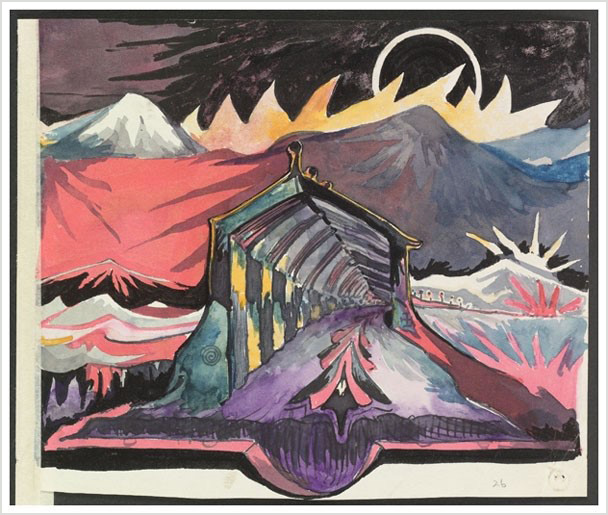
Fantasy Landscape3 views

Owlamoo
Owls are creatures of Middle-earth. In the Hobbit, it was mentioned that Bilbo was to: "hoot twice like a barn-owl and once like a screech-owl".
A coloured illustration of "Owlamoo" from 1928, an evil owl who appeared in nightmares of his son, Michael.2 views

III) Fantasy worlds, Middle-earth and beyond
For ease of reference this art is presented alphabetically by location/subject name and then chronological in terms of Tolkien’s creating it. This analysis provides insight into Tolkien’s evolving creative vision.
1 view

1. Bag-End: The Hall at Bag-End, Residence of B. Baggins Esquire
Illustration of Bilbo inside Bag End, detailing the interior (furnishings, front door) and looking beyond to the garden and Shire.
A simple and naïve illustration capturing the legendary opening lines of the Hobbit:
"In a hole in the ground there lived a Hobbit. Not a nasty, dirty, wet hole, filled with the ends of worms and an oozy smell, nor yet a dry, bare, sandy hole with nothing in it to sit down on or to eat: it was a Hobbit-hole, and that means comfort."
A later coloured version by HE Riddett was published in Deluxe edition and the Tolkien Calendar 1979.4 views

2. Beorn's Hall
Home of Beorn (the skin-changer), a detailed architectural drawing of the pillars, steeple beams, fire pit, table and raised platforms
Later coloured by HE Riddett. Used in some illustrations of The Hobbit and the Hobbit Calendar 1976.4 views

3. Dunharrow
The storyline relating to Dunharrow went through numerous changes in terms of its physical characteristics and it relationship to the Paths of the Dead. Accompanying these drafts, Tolkien created many sketches, often detailed, in the end abandoning them.
A later crayon drawing was a more picturesque and panoramic view.
In Tolkien’s words in ROTK Bk IV Ch 3:
"Dividing the upland into two there marched a double line of unshaped standing stones that dwindled into the dusk and vanished in the trees. Those who dared to follow that road came soon to the black Dimholt under Dwimorberg, and the menace of the pillar of stone, and the yawning shadow of the forbidden door."
However in this drawing there is no depiction of the dark wood or stone pillar. As was his manner, his vision had changed and he annotated this ‘no longer fits story.’
Published in LOTR Calendar 1977.6 views

4. Fangorn Forest
This painting was created in 1920s and captioned by Tolkien as ‘Fangorn Forest’. Nevertheless in a 1937 letter, Tolkien noted that it was meant to illustrate the passage in The Silmarillion where Beleg finds Gwindor in the forest of Taur-nu-Fuin, and the elven figures clearly indicate this.
It was reproduced in Tolkien Calendar 1974, LOTR Calendar 1977, Silmarillion Calendar 1977 and 1978 (captioned “Beleg finds Gwindor in Taur-nu-Fuin").4 views

5. Forest Rivers: Bilbo comes to the Huts of the Raft-elves
The huts of the raft-elves referred to a village which was to be found on a protruding bank of the Forest River. Bilbo, hanging on to a barrel, spent a night hiding outside the village while pursuing Thorin and Company (who were escaping the imprisonment of the Wood-elves inside empty barrels).
There are two versions of Bilbo coming to these huts.
Version 1: with the inscription Sketch for the Forest River, Hobbit Ch. IX
Shows Bilbo arriving at the huts in the dark in the light of the full moon. Published in Tolkien Calendar 1979.3 views
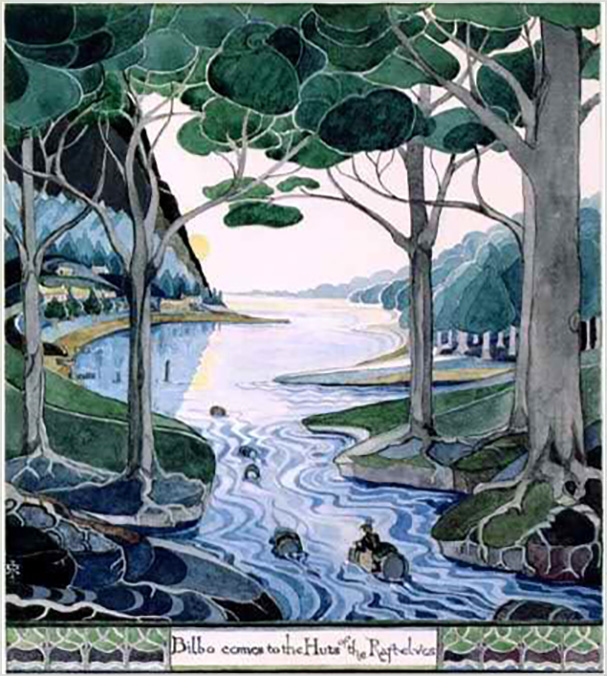
Version 2: Bilbo comes to the Huts of the Raft-elves.
Painting shows the sun has already risen. This appeared in the second English impression of The Hobbit (the first edition contained no coloured illustrations).3 views
![6. <i>Glaurung sets forth to seek Turin</i> [dated 1927]
<br/><br/>
Glaurung was the first of the dragons and chief lieutenant of Morgoth, the First Age Dark Lord. In this painting he is seeking Turin, a tragic hero.
<br/><br/>
Interestingly the entrance to Nargothrond, the Nordor elven stronghold, is a single arch, contrary to the triple doors seen in other drawings, reflecting Tolkien’s evolving image of this fortress.
<br/><br/>
It was published in The Silmarillion Calendar 1978.<span class="ngViews">3 views</span>](https://www.lotrarts.com/../images/gallery/showcase/jrr-tolkien/jrr-tolkien-art-iii-007.jpg)
6. Glaurung sets forth to seek Turin [dated 1927]
Glaurung was the first of the dragons and chief lieutenant of Morgoth, the First Age Dark Lord. In this painting he is seeking Turin, a tragic hero.
Interestingly the entrance to Nargothrond, the Nordor elven stronghold, is a single arch, contrary to the triple doors seen in other drawings, reflecting Tolkien’s evolving image of this fortress.
It was published in The Silmarillion Calendar 1978.3 views
![7. <i>Gondolin and the Vale of Tumladen’ [dated 1928]</i>
<br /><br />
Tumladen, was the green field upon which the hidden eleven city was built. It is where Glorfindel, mighty elf, died in the battle with the Balrog (The Silmarillion Ch 23). He was re-embodied and sent to Middle-earth to fight evil and the Witch-King. It was he who pronounced that “no mortal man would ever destroy the Witch-King”.
<br /><br />
Later coloured by HE Riddett.<span class="ngViews">2 views</span>](https://www.lotrarts.com/../images/gallery/showcase/jrr-tolkien/jrr-tolkien-art-iii-008.jpg)
7. Gondolin and the Vale of Tumladen’ [dated 1928]
Tumladen, was the green field upon which the hidden eleven city was built. It is where Glorfindel, mighty elf, died in the battle with the Balrog (The Silmarillion Ch 23). He was re-embodied and sent to Middle-earth to fight evil and the Witch-King. It was he who pronounced that “no mortal man would ever destroy the Witch-King”.
Later coloured by HE Riddett.2 views

8. Helm’s Deep and the Hornburg
Tolkien’s first recorded drawing of Helm’s Deep was a small sketch of a great gorge and fortress, this was later developed and refined.
Tolkien describes Helm’s Deep and Hornburg in The Two Towers, Book III, Chapter 7:
“It Helm's Gate, before the mouth of the Deep, there was a heel of rock thrust outward by the northern cliff. There upon its spur stood high walls of ancient stone ... The Hornburg it was called.... A wall, too, the men of old had made from the Hornburg to the southern cliff, barring the entrance to the gorge. Beneath it by a wide culvert the Deeping-stream passed out. ... and flowed then in a gully through the midst of a wide green gore, sloping gently down from Helm's Gate to Helm's Dike...”
Tolkien drew an aerial view with a map of the area, and additionally, on a page from an examination script (partly over the handwriting), an image of its structural elements
This image was reproduced in LOTR 1977 Calendar (with the writing erased).4 views

9. Hobbiton: ‘The Hill : Hobbiton-across-the-Water
This is one of Tolkien’s most renowned and iconic works of art. In his own words:
“The tunnel wound on and on, going fairly, but not quite straight in the side of the hill, The Hill, as all of the people for many miles around called it.”
Painted during 1937 the final coloured version illustrates the green door of Bag End; the field and the Party Tree; Bagshot Row; the ordered tilled land; the Grange, and the Old Mill along the water.
Tolkien did many preliminary sketches of this before determining its final design. As an illustration of Tolkien’s review process, two such drawings are reproduced in the following images.2 views

Hobbiton Preliminary drawing (1)
An earlier less detailed preliminary sketch with slight differences, including the Mill windows and signpost words.1 view

Hobbiton Preliminary drawing (2)
The nearly-final version.
Interesting changed details, as noted in http://bitoflight.luminousbeings.net/keepsakes/Hobbiton-final-b&w.htm.
There is another small door low in the south-eastern flank of the Hill, the road towards Overhill, which branches off from Hill Lane on the right, above Bagshot Row, is also indicated here. On the final version the mill's weather vane is missing, the mill has acquired a flower garden, some trees close by the water are clearly identified as chestnuts.1 view

10. Isengard and Orthanc
Hammond and Scull provide a fascinating account of Tolkien’s evolution of words and images of Orthanc and Isengard.
From the first mentioned in a draft, of: ‘a tower of stone’, an enclosed vale with a great gate, Tolkien created an intricate drawing of this tower and its surrounds, referred to as Orthanc (1), which featured minor deviations to his initial description.1 view
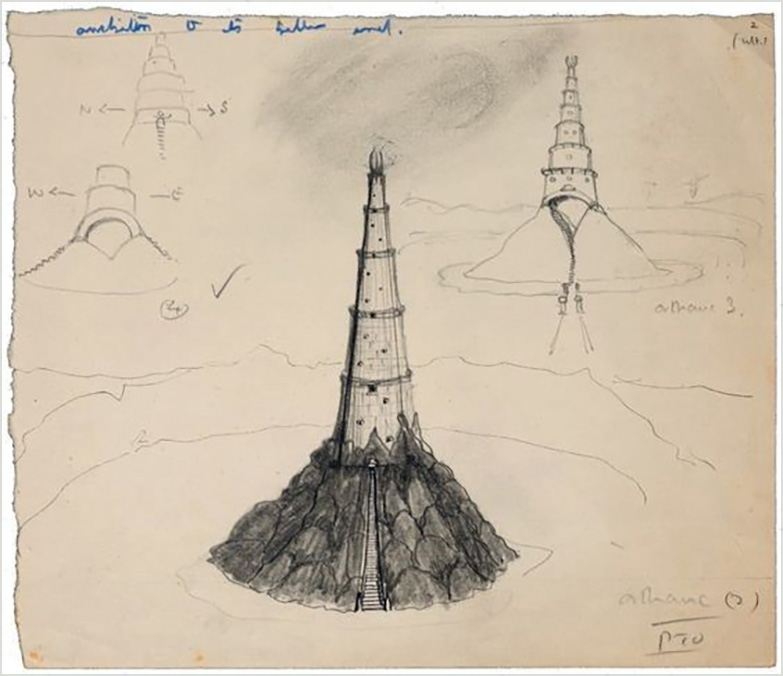
Orthanc (2)
Again using examination script, Tolkien drew Orthanc (2) and (3), mirroring a revision of his text image of Orthanc as "marvellously tall and slender, like a stone horn..."1 view

Orthanc (3)
After further ideas and revisions, a new concept emerged which Tolkien described in TT, bkIII, Ch. 8 and 10):
“There stood a tower of marvellous shape. It was fashioned by the builders of old… A peak and isle of rock it was, black and gleaming hard: four mighty piers of many-sided stone were welded into one, but near the summit they opened into gaping horns. Their pinnacles sharp as the points of spears, keen-edged as knives.’ ‘It was black, and the rock gleamed as if it was wet…”1 view

Orthanc (4)
A further drawing of a more direct perspective
Tolkien incorporated this drawing into the TT dust-jacket design (see dj section).1 view

11. Lake-town
Lake-town was a small settlement of men. It was constructed entirely of wood and stood upon wooden pilings sunk into Long Lake, as a protection against the dragon Smaug, who dwelt in the nearby Lonely Mountain.
The illustration detailed the architectural structure of pillars, long wooden quays, steps and ladders, houses…
Published in The Hobbit, 1937.
Illustration was coloured by HE Riddett and published in the Hobbit Calendar 1976.2 views

Tolkien also drew a map of Lake-town, drawn in coloured pencil (unpublished).1 view
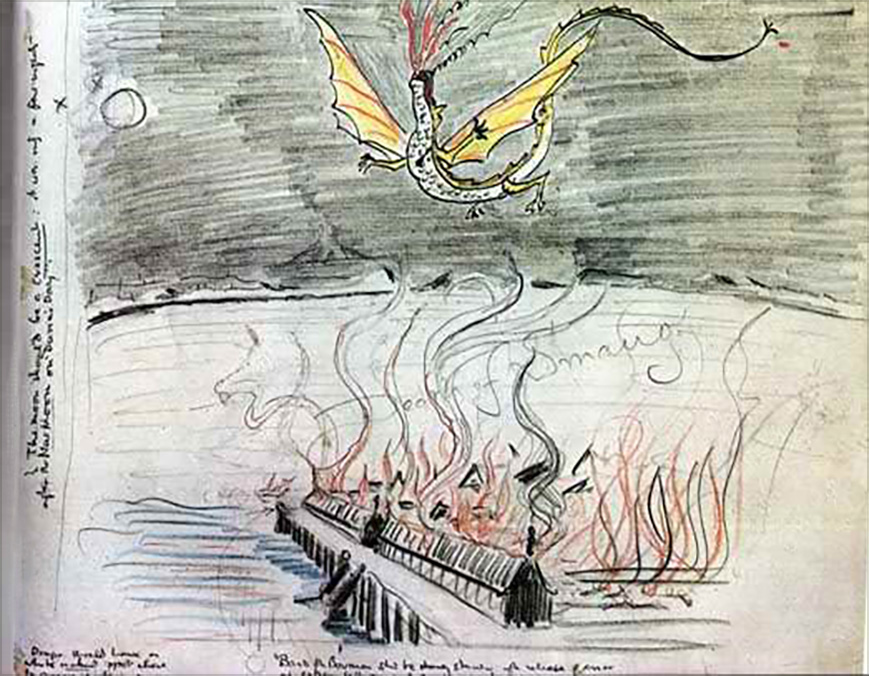
12. Lake-town: ‘Death of Smaug’
This sketch depicts the death of Smaug from the arrow shot by Bard the Bowman, piercing the dragon in its one vulnerable spot, Lake-town burning below (from The Hobbit Chapter 14).
Tolkien’s annotations on the edges instruct: crescent moon, “Dragon should have a white naked spot where the arrow enters”, “Bard the Bowman should be standing after release of arrow at extreme left point of the piles.”
Reproduced in Tolkien Calendars 1973 and 1974.2 views

13. Lake Mithrim
Watercolour dated 1927, from the Silmarillion tale after the return of the Noldorin Elves to Middle-earth.
Published in Silmarillion Calendar 1978.2 views

14. Lothlórien
Tolkien wrote in glowing terms of Lothlórien:
“There are no trees like the trees of that land. For in the autumn their leaves fall not, but turn to gold. Not till the spring comes and the new green opens do they fall, and then the boughs are laden with yellow flowers; and the floor of the wood is golden, and golden is the roof, and its pillars are of silver, for the bark of the trees is smooth and grey.”
Despite this lavish description, Tolkien created only one painting of this magical realm of Lord Celeborn and Lady Galadriel. It is a crayon drawing of the Forest of Lothlórien in Spring, depicting the mallorn trees in golden bloom, an image of sublime delicacy and beauty.
Published in The Calendar 1974 and in LOTR Calendar 1977.2 views
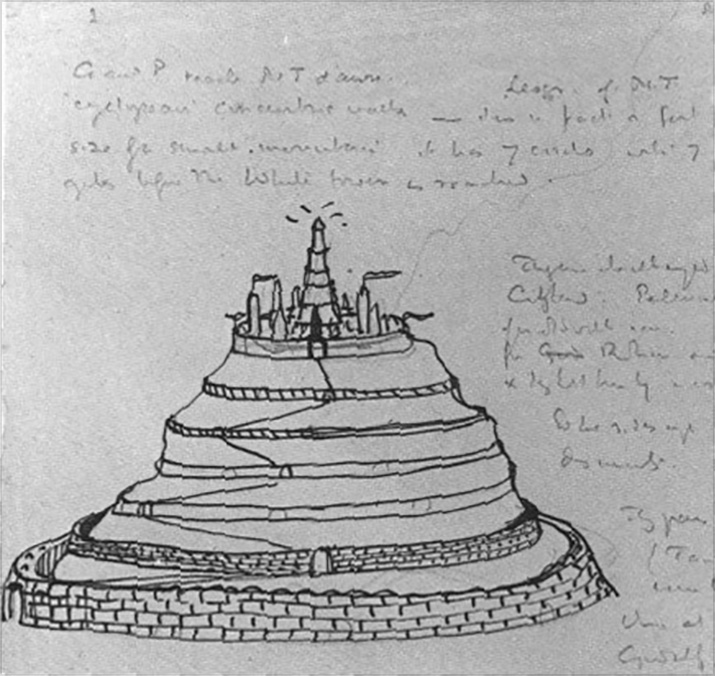
15. Minas Tirith
Tolkien’s drawings of Minas Tirith reflect his attempts to finalise the storyline. His descriptions of the ‘White City’ evolved from an essential concept of: “…its huge ‘cyclopean’ concentric walls… a fort and town the size of a small mountain. It has seven circles…before the White Tower is reached.”
The earliest sketch of Minas Tirith reflect this description, however with only a faint line impression of the mountain pier that Tolkien at the last minute envisaged divided the city.1 view
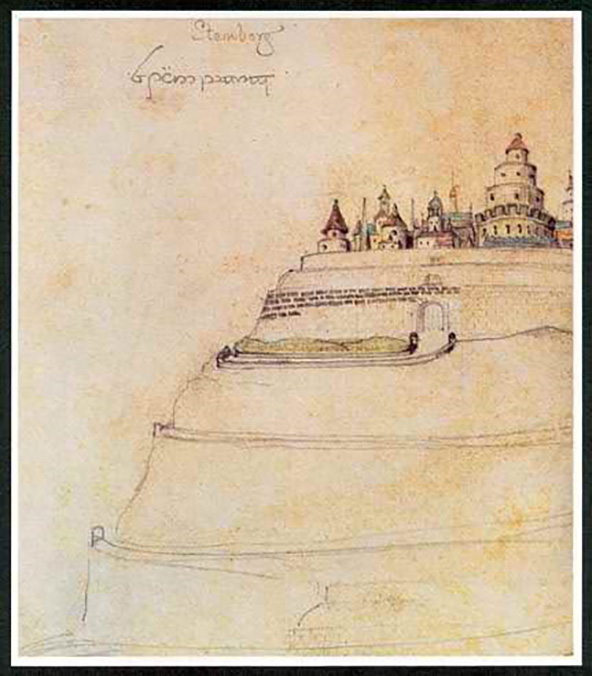
Minas Tirith (2)
Tolkien then created a more detailed image with European-style buildings, which he abandoned (but tis was published in LOTR Calendar 1977)1 view

Minas Tirith (3)
Tolkien reworked the earliest image depicting the mountain pier.1 view

16. Mirkwood Forest
Mirkwood or the Forest of Great Fear was a great forest in Rhovanion. This stylised and elegant drawing shows rows of trees of various type and thickness with burgeoning roots. This is an image of deep night, and has an eerie enchanted feel (though not quite the threatening impression given in the book).
The inked illustration was published in the Hobbit, 1937.
The original was given to a friend and cannot now be traced.2 views

17. Moria: West Gate
Tolkien created a crayon illustration of the west gate of Moria, and on the reverse of the paper, a more detailed coloured pencil version. It featured huge cliff walls, the gate symetrically flanked by trees, a lake featuring the ominous tenacle of the Watcher.
This image came from the scene described in FOTR as the way the Fellowship entered Moria, Tolkien: "Beyond the ominous water were reared vast cliffs, their stern faces pallid in the fading light: final and impassable."
The image is not fully consistent with Tolkien’s final text (eg architectural columns, active falls), and in fact the gates “were not made to be seen”.
Finally, the original drawing included the lower cut-off, section, it is assumed to reduce the inconsistency to his written description
Published in Tolkien Calendars 1973 and 1974, and in LOTR 1977 Calendar (truncated at top and bottom).1 view

Moria: West Gate (lower)
The lower cut-off, section assumed to reduce the inconsistency to his written description.2 views

18. Moria: The Doors of Durin
Tolkien created many trial drawings for the Doors. As an indication of this evolving creative process, early and final (art for printer) drawings are featured. Major changes in this process: eg number of stars changed, proportions changed, became more elongated, columns became more detailed, trees appeared and became more elaborate.
In Tolkien’s words: “…an arch of interlacing letters in an Elvish character…an anvil and hammer surmounted by a crown with seven stars . Beneath these again were two trees, each bearing crescent moons. .. in the middle of the door a single star with many rays.” (Ref BkII ch4)2 views
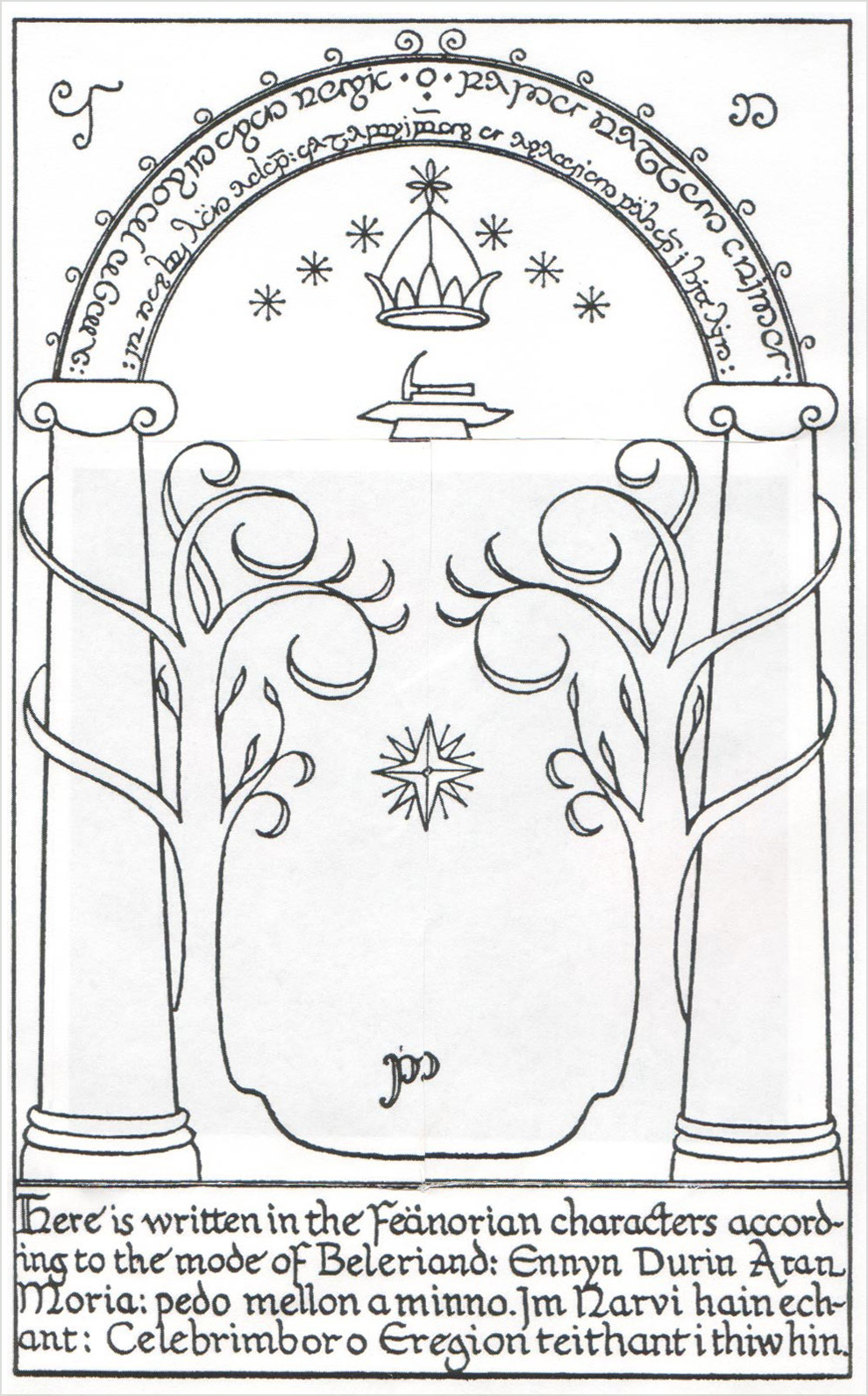
Moria: The Doors of Durin
From Hammond and Scull, the version below (that everyone recognises) is an image created by a printer’s artist, this was taken from Tolkien’s final version. The trees are larger twirling around the columns and lower branches complete, see below.
Crayon drawing reproduced in the Fellowship of the Ring, Tolkien Calendars in 1973 and 1974.
Gandalf translates the words in the arch to the others of the Fellowship: “The Doors of Durin, Lord of Moria. Speak, friend, and enter. I, Narvi, made them. Celebrimbor of Hollin drew these signs.”1 view

19. Mordor: The Dark Tower Barad-dûr
As Tolkien’s vision of Mordor evolved, he provided only a very brief description of the Dark Lord’s Tower. We get an image from Frodo (and later Sam), as: “wall upon wall, battlement upon battlement, black, immeasurably strong, mountain of iron, gate of steel, tower of adamant, he saw it: Barad-dûr, Fortress of Sauron.”
However, his detailed painting of the lower layers of brickwork of a fortress wall of massive proportions, though ominous, does not depict the full sense of height or expected menace.
However, a map of Mordor, depicts more what Frodo sees: “from some great window immeasurably high there stabbed northward a flame of red, the flickering of a piecing Eye….” (Bk VI, Ch3)1 view

20. Mordor: Orodruin (Mt Doom)
This sketch was created on a rejected page of the manuscript of The Return of the King, Book VI. In the original the tongue of flame at the cone of the mountain is coloured red. It details Sauron's Road from Barad-dûr to the entrance of the Sammath Naur.
It was published as an inset to the painting of Barad-dur in LOTR Calendar 1977.1 view

21. Mordor: Shelob's Lair (and manuscript)
Shelob’s Lair sketch was drawn first in pencil then inked within the manuscript text.
A cropped version was published in LOTR Calendar 1977, noting: The writing accompanying this picture is a fragment of an early draft of the passage…1 view
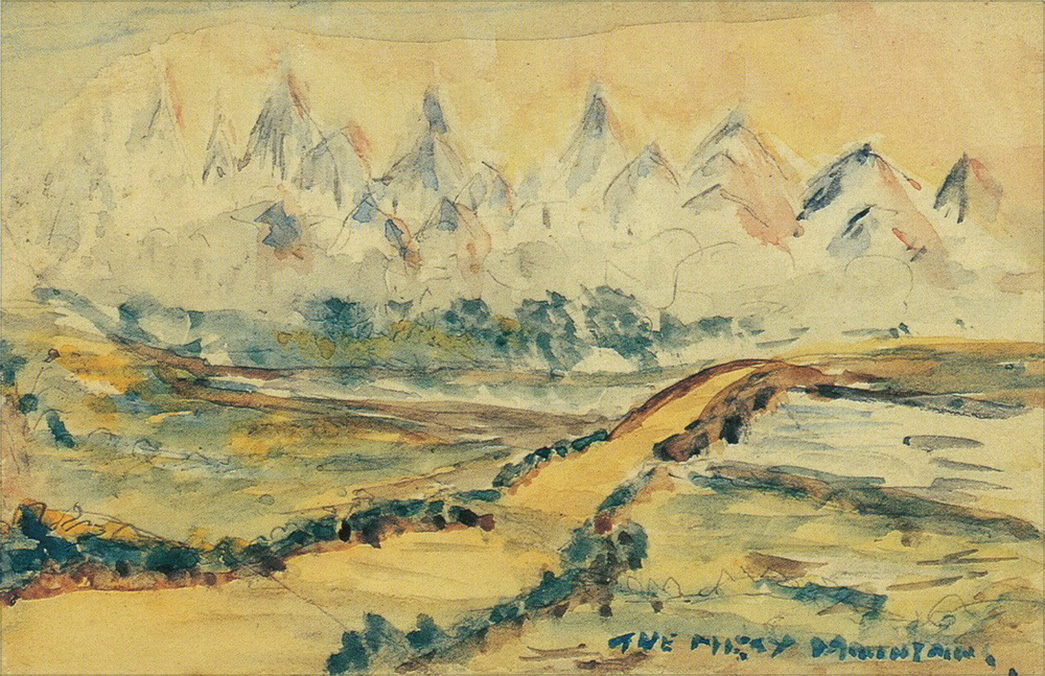
22. Mountain: The Misty Mountains
This warm tone watercolour depicts a scene of the road winding aross the river towards the Misty Mountain foothills. It paints a pleasant natural setting and sense of innocence/serenity. Obviously Tolkien choose not to portray in this a sense of the mystery, menance or malice awaiting in the mountains.1 view
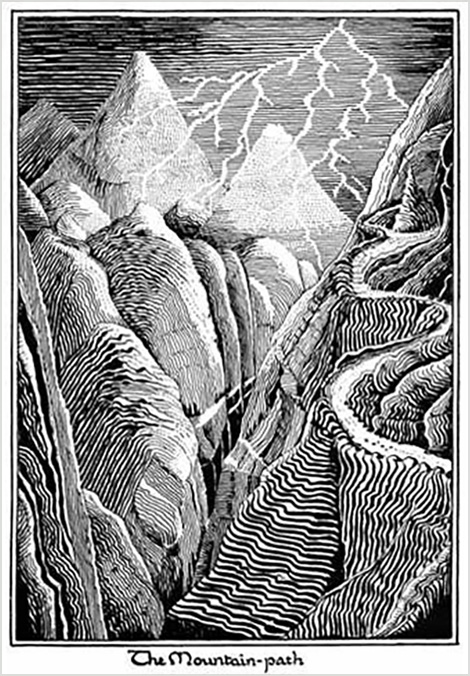
23. Mountains: ‘The path’
The High Pass over the Misty Mountains: on its western end was the refuge of Rivendell and from there the Great East Road climbed into the mountains until it reached the mountain under which lay the Goblin-town.
Colour was added later by H. E. Riddett.1 view

24. Mountains: Bilbo woke with the early sun in his eyes
Tolkien inspired by Archibald Thorburn’s Golden Eagle used this painting to illustrate the first words of Chapter 7 of The Hobbit.
Illustrated the first American edition, 1938, the Tolkien Calendar 1973 and 1974 and Hobbit Calendar 1976.1 view

25. Mountains: Conversation with Smaug
Classic image of Tolkien’s vibrant watercolour of Smaug in his lair, lying on his treasure trove of gold and gems, with the gleaming Arkenstone. Captioned by Bilbo’s words: “O Smaug the Chiefest and Greatest of Calamities.”
Reproduced in the US Hobbit 1938 and UK second edition; Tolkien Calendars 1973 and 1974 and Hobbit Calendar 1976.1 view
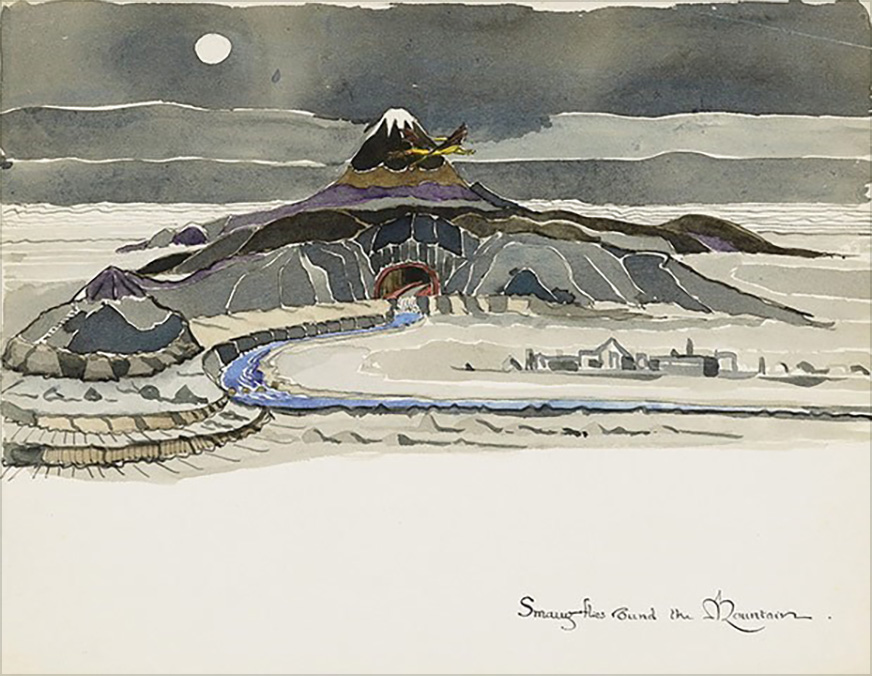
26. Mountains: Smaug flies round the Lonely Mountain
Painting depicts Smaug flying around the Lonely Mountain and the ruins of the town of Dale in the bend of the Running River.
It was published in The Tolkien Calendar 1979.1 view

27. Old Forest: Old Man Willow
Drawing in fine crayon depicts the Old Man Willow (from FOTR ‘The Old Forest’) “…a huge willow-tree, old and hoary. Enormous it looked, its sprawling branches going up like reaching arms with many long-fingered hands, its knotted and twisted trunk gaping in wide fissures that creaked faintly as the boughs moved.”
This was meant as a personal illustration (not meant for publication) however, was reproduced many times in calendars. It demonstrates Tolkien’s fine ability to depict trees and forest imagery, in this case a deceptively tranquil scene (arising out of a dark threatening forest, which would have ominous repercussions).
Published in Tolkien Calendar 1973, 1974 and part in LOTR Calendar 1977.2 views

28. Nargothrond
An unfinished watercolour of the entrances to the Elven underground stronghold built by Finrod Felagund, King of Noldor.
It was published in The Silmarillion Calendar 1978.1 view

Nargothrond(2)
Ink illustration dated 1928. The entrance to Nargothrond is shown as it was before the bridge of Túrin was built over the River Narog (The Silmarillion).
Coloured later by HE Riddett.1 view

29. Rivendell
From modelling mountain landscapes, Tolkien created in shaded pencil an aerial view of Rivendell, then transformed this into an ethereal coloured scene. There is simplicity and splendor in Tolkien’s layered painting, from the wildflowers and tree in foreground, to the falls, through to the mountain escarpments and the glinting image of the Lord Elrond’s city hidden in the forest.
Tolkien: The Fair Valley of Rivendell: “Hidden somewhere ahead of us is the fair valley of Rivendell where Elrond lives in the Last Homely House' (Chapter 3); ‘the sound of the waterfalls was loud in the stillness” (H&S1)
Reproduced in Hobbit UK 1937 2nd edition and (truncated) US 1938 edition, Tolkien Calendars 1973 and 1974 and in The Hobbit Calendar 1976.1 view

30. Rivendell looking East
The following early version watercolour of the scene looking east towards the Misty Mountains was truncated at the top and published in LOTR Calendar 1977.1 view

31. Rivendell looking West
An unfinished crayon sketch of Rivendell looking towards the left.
It was published in LOTR Calendar 1977 (truncated at top and bottom).1 view

32. Taniquetil
A watercolour of Taniquetil, the Holy Mountain, the highest mountain of Arda, “upon whose summit Manwe: set his throne’, and in the foreground of which is a white elven swan-ship” (dating from 1927/8).
It was published on book covers, in The Tolkien Calendar 1974 and The Silmarillion Calendar 1978.1 view

33. The ElvenKing’s Gate
Inked drawing originally published in the 1st impression of The Hobbit.
Latter coloured by H.E. Riddett and published in The Hobbit Calendar 1976, and in some illustrated editions of The Hobbit.1 view

34. The ElvenKing's Gate (2)
An unfinished painting to illustrate The Hobbit, Chapter 9.
It was published in The Tolkien Calendar 1979.2 views

35. The Misty Mountains looking West from the Eyrie towards Goblin Gate
Drawn in ink and originally published in the first impression of The Hobbit, in Chapter 6.
Later coloured by HE Riddett and appeared in the Calendar 1976.2 views
![36. <i>The Shores of Faery [1915]</i>
<br/><br/>
The term 'Faerie' belongs to an early period of Tolkien's writings. It is not used in The Lord of the Rings, but in The Hobbit it relates to a realm on the edge of human experience in which beyond the Great Sea dwell fantastical creatures and Elves.
<br/><br/>
‘The Shores of Faery' evocative watercolour captures a sense of the light and etheral nature of the Undying Lands, still recognizable with its rocks, trees, sun and sea, but with a lingering sense of the unknown and wonder.
<br/><br/>
Hammond and Scull provide an amazingly detailed drescription: “In the painting, the almost leafless trees frame the view in an Art nouveau manner. The tree on the left has a crescent moon upon the curving branch, and the tree on the right a golden orb. The colours of the work change accordingly from left to right, from dark night to blazing day. The 'lonely hill' in the center is Kôr with its white towers; at its feet are golden sands and 'the pale green Sea'. A prose preface to the later versions of the poem makes it clear that the star that 'hunted with the Moon' was Eärendel (Eärendil), in the painting a bright spot within the Moon's curve.”<span class="ngViews">2 views</span>](https://www.lotrarts.com/../images/gallery/showcase/jrr-tolkien/jrr-tolkien-art-iii-048.png)
36. The Shores of Faery [1915]
The term 'Faerie' belongs to an early period of Tolkien's writings. It is not used in The Lord of the Rings, but in The Hobbit it relates to a realm on the edge of human experience in which beyond the Great Sea dwell fantastical creatures and Elves.
‘The Shores of Faery' evocative watercolour captures a sense of the light and etheral nature of the Undying Lands, still recognizable with its rocks, trees, sun and sea, but with a lingering sense of the unknown and wonder.
Hammond and Scull provide an amazingly detailed drescription: “In the painting, the almost leafless trees frame the view in an Art nouveau manner. The tree on the left has a crescent moon upon the curving branch, and the tree on the right a golden orb. The colours of the work change accordingly from left to right, from dark night to blazing day. The 'lonely hill' in the center is Kôr with its white towers; at its feet are golden sands and 'the pale green Sea'. A prose preface to the later versions of the poem makes it clear that the star that 'hunted with the Moon' was Eärendel (Eärendil), in the painting a bright spot within the Moon's curve.”2 views

37. Tol Sirion
The black and white illustration shows Minas Tirith, the watchtower of Finrod Felagund, on the Isle of Werewolves. To the left are the Mountains of Shadow, and to the right the western edge of Dorthonion; beyond lies the wide plain of Ard-galen, and on the far northern horizon is the line of Iron Mountains.
Later coloured by HD Riddett, and published in the Silmarillion Calendar 1978.2 views

38. The Trolls
In Tolkien’s words: “curling, fantastical flame rising amid a nocturnal labyrinth of stippled trees” (The Hobbit, Ch 2).
Colour was added later by HE Riddett.2 views

39. The Three Trolls are turned to Stone
Trolls were large monsters of limited intellect, strong and vicious, and turned to stone in the sunlight. Fine line, detailed and block black ink drawing created to illustrate Chapter 2 of The Hobbit.
Later coloured by HE Riddett, published in the Tolkien Calendar 1979.2 views

IV) ‘The art of the artefact…’
To support Tolkien’s stated notion of being the editor of the tale, not the author, he created artefacts and facsimiles. He was immersed in the creation of these to enhance the storyline, bringing ‘a reality’ into his fantasy.
views

1. The book of Mararbul (the manuscript found in the Chamber of Records in Moria), facsimile page 1
The Book of Mazarbul was the record of Balin's return to Moria with a group of Longbeards in Third Age T.A. 2989.
In LOTR BkII, chapter 5: “It had been slashed and stabbed and partly burned, and it was so stained with black and other dark marks like blood that little of it could be read…”
The three facsimile leaves Tolkien created of the ‘Book of Mararbul’ were the ‘artefacts’ he most wanted published in LOTR, however they were too expensive to reproduce.
Tolkien created six preliminary drawings. He took considerable pains to develop the designs for these, using coloured pencils and ink , then he cut, tore and ‘bloodied’ the leaves.
Gandalf read from the last page: "We cannot get out. We cannot get out….They are coming…”2 views

The book of Mararbul facsimile page 21 view

The book of Mararbul facsimile page 31 view
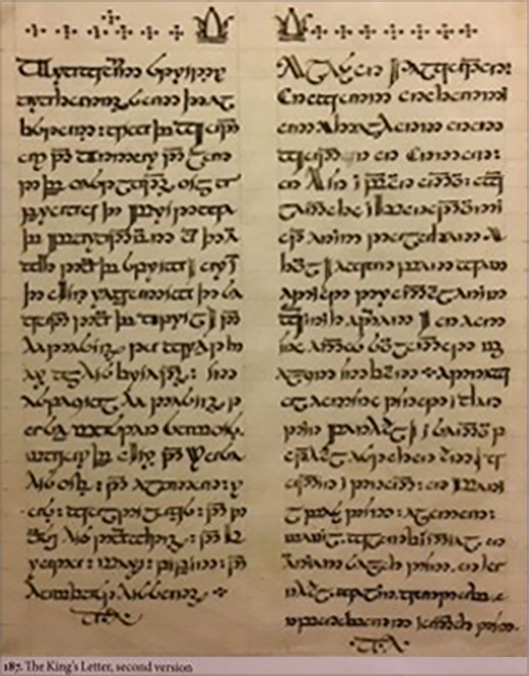
2. The King’s letter version2
In LOTR’s epilogue Sam reports that he has received an invitation from King Elessar for his whole family to visit him.
Tolkien created three facsimiles of this letter written in Elvish and Common Speech. Changes included correctly minor errors, slightly different text, word order, year is added. They are significant in the account of Tolkien’s linguistic creations as they represent the longest known examples of Sindarin Tengwar.2 views

V) Maps
Tolkien evolved his map drawing from quick sketches to very detailed, integrated and calibrated maps. This process of evolution is demonstrated with the following examples.
views

1. Earliest maps created by Tolkien
Reproduced by Christopher Tolkien from Tolkien’s quick scribble for The Book of Lost Tales, identifying for example, two trees (b); Iron Mountains (f).
Reproduced by Christopher Tolkien from Tolkien’s quick scribble for The Book of Lost Tales, identifying for example, two trees (b); Iron Mountains (f).2 views

2. I Vene Kemen
Early map of the world by Tolkien, depicted in the form of a ship, ‘the Vessel of the Earth’, featuring, eg, the sun (OR), moon (Sil), The Trees.1 view

3. Ambarkanta maps
A set of five maps created by Tolkien to develop the shape of Arda: before the Changing of the World (map 1, 2), after the Changing (map 3), after the fall of the Two Lamps but before the War for the Sake of the Elves (map 4); After the War for the Sake of the Elves and before the Changing of the world (map 5).2 views

Map (2)1 view

Map (3)1 view

Map (4)1 view

Map (5)1 view

4. The maps of the Shire
Hammond and Scull document at least eight versions of parts of the maps of the Shire, some sketched clearly as trials on a blank page.
The map below is the most worked on and demonstrates Tolkien’s process of multiple layers of review, revision, development and enhancement.1 view

5. Map of Middle-earth
For Tolkien maps were devices to calibrate the journeys of his separate characters across Middle-earth. A series of maps document Tolkien’s method of map creation, often on overlapping pasted sheets, reworking names and location details.
With the use of grid paper and scale, he depicted (as in the map below) in red and blue ink, dashes and dotted lines, the diverging plotlines of the various fellowship ‘sub-teams’, as in Map of Rohan, Gondor, and Mordor" and "Distances and dates in Mordor”.
This gave Tolkien the objective capacity to adhere to believable time-space principles and bring these parallel storylines to a synchronised arrival of Frodo and Sam at Mt Doom, and Aragorn and his army to the Black Gates. An immensely complex, meticulous and exhausting task, this was recorded in Tolkien’s annotations of notes, additions and corrections.
"Map of Rohan, Gondor, and Mordor" (from Bodleian Libraries, University of Oxford)1 view

6. Thrór's Map
From Dwarvian legend, Thrór's Map was drawn with East at the top of the map, showing the Lonely Mountain of Erebor, the Running River and the surrounding lands. It also showed a secret entrance to the Mountain, and instructions in secret Moon-letters how it could be opened. The map is decorated with Old English Runes.
It is reproduced in facsimile in The Hobbit.
It was coloured in 1979 by HE Riddet and published as a poster.1 view

VI) Dust-jackets
Tolkien’s publishers, impressed by his Hobbit drawings and maps, requested he design the dust-jacket for The Hobbit.

1. The Hobbit
Tolkien produced several variations, settling on the following watercolour panorama. In typical fashion, he carefully sized this according to the proportions of the covers and the width of the spine, detailing his suggestions in the margins (in this prototype, it includes roughly written comments by the printer).
In pencil, pen, ink, watercolour and gouache (250 x 380 mm) Tolkien’s illustration evokes a sense of fantasy and adventure. It features a stylized mountain landscape with trees, flying creatures and a disc of the sun, edged by runes (according to the Tolkien Library, Tolkien originally intended extra drama with a red sun).2 views

2. The Lord of the Rings
Hammond and Scull (1) provide a fascinating account of Tolkien’s creation of the dust-jackets for The Fellowship of the Ring, The Two Towers and The Return of the King. The final published versions are featured in this showcase.
From a basic concept, The One Ring centred surrounded by red Tengar inscription and featured the three elven rings, Tolkien trialled different positioning, lettering, motifs and colour of paper.1 view

The Two Towers
For The Two Towers, Tolkien had a quandary in identifying the actual two towers, finally settling on Orthanc and Minas Morgul, one Nazgul flying above a blood-red Ring (the image heightened by the eclipse below Minas Morgul and the white hand emblem of Saruman below Orthanc).1 view

The Return of the King
For ROTK Tolkien trialled incorporating elements of Aragorn’s heritage: the White Tree, seven Stars and flowers, winged crowned-helm, with the dark figure of Sauron reaching-out on a black background, a dramatic effect.1 view

VII) Artistic designs and runes
1. Heraldic devices
There are many informative reviews of Tolkien’s design art and Middle-earth heraldry.
Elvish heraldic devices was published in Pictures By J.R.R. Tolkien (Houghton Mifflin Company, 1979).
Two comprehensive website sources are
Lindefirion.net Forodrim.org
They provide a fascinating insight to the complex interrelationships of the symbols contained in these devices, some of which remain unexplained.
Rules of Tolkien’s heraldry
The Elves had formulated rules or principles for the shaping of heraldic devices, devices for:
• males were placed within a lozenge
• females were placed within a circle
• families, houses or countries were placed within a square
• the rank of the owner was shown by the number of "points" reaching the outer rim of the device, eg four signified a prince, six to eight a king; for the oldest of the Elven kings, like Finwe, as many as 16 points.
This analysis provides an overview of the main features of some devices as demonstration of Tolkien’s intriguing and complex symbolic and design interconnections.

1. Finwe's (first king of the Noldorin Elves) device shows a "winged sun", the sixteen "points" reach the edges of the sign, signifying Finwe's position as one of the oldest of the Quendi and the High King of the Noldor. His bright yellow and red colours seem to be echoed in the devices of his heirs: Fëanor, Fingolfin, and Finarfin.1 view

2. Elwë (King Thingol of Doriath) had a similar device with a "winged moon" on sable surrounded by stars. But Elwë got only eight "points" signifying kingship, instead of Finwë's sixteen.1 view

3. Melian’s (The Queen of Doriath) device is unlike any other. Within it are both stars and flower-like shapes, reflecting both the devices of Elwë (her husband) and Lúthien (her daughter). Within the circle that marks her as female is seen a lozenge, which is usually the escutcheon of male devices.1 view

4. Fëanor’s (‘Spirit of Fire’) device shares the fiery colours of his father's, with the association of fire having wavy flames that go from the centre outwards. In the centre is the heraldic image of Silmaril, the greatest of Fëanor's creations. It is surrounded by a number of coloured fields, possibly representing the art of creating crystals, which he invented.1 view

5. Fingolfin’s device was distinctly related with his brothers, with the exception of the Silmaril. It had orange flames on yellow disc, with silver stars on dark blue background. Eight "points" reached the edges, as is the case with all the devices for the sons of Finwë.1 view

6. Finarfin’s device shares the "fiery" appearance of those of his father and brothers, though the fire-rays are calmer, giving the device a more balanced appearance. However, it is distinctly set apart possibly indicating he stayed in Aman, while his brothers went to Middle-earth. This device was also used by Finarfin's heirs, and especially Finrod Felagund.

7. Finrod Felagund was also a device, drawn by the Men of the people of Bëor. It is distinctively nonsymmetrical: A silver harp and a torch on green background. Finrod also used a badge that depicted a crown of golden flowers. This was probably related to the device of Finarfin.

8. Lúthien Tinúviel (princess of Doriath) is the only person known to have had two distinct heraldic devices; both are based on patterns with flowers.
The first one, shows the white niphredil that grew at her birth.

9. The second probably holds an elanor in the centre. The stars in this device echo those found in her father device.

10. Idril Celebrindal reveals a cornflower-like pattern. Apparently Idril was especially associated with this flower, possibly through the golden corn that echoed her golden hair. Twelve points reach the edge of the circle, suggesting the status fitting for the daughter of a High King. The device of Idril was preserved and brought from Gondolin to Númenor by Elendil, where it became the inspiration of many similar Númenorean designs.

11. Gil-galad’s ("Radiant star") device shows a star-covered sky. It is hard to tell how many "points" meet the edge, but his status should allow at least four.

12. The Silmarils’s device only one designated for an object instead of a person, although the reason is unclear. The tree in the background is probably Laurelin, the Golden Tree, from which the Silmarils got part of their light. The Silmarils are also used as emblems in the devices of Fëanor, Eärendil, and Beren.
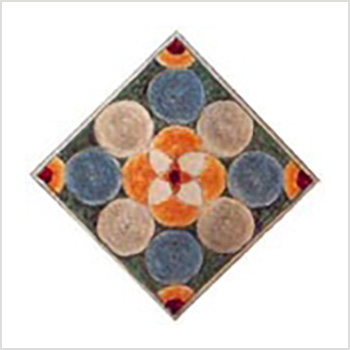
13. Heraldry of Edain When the Edain entered Beleriand, they seem to have adopted the Noldorin rules and concept of heraldry almost immediately.
The House of Bëor device. It is the most elf-like of the Human devices, being entirely symmetrical. Still it lacks the splendour of the Elvish devices, and seems more earth-bound with its warm and natural colours.

14. The House of Hador device. The reason for the design is not clear, though as a great friend of Fingolfin it possibly shows the "fiery" colours of Finwë and his heirs in this device. The symmetry is vertical, even in the "spearhead" designs, the one at the bottom being more pointed than the one at the top.
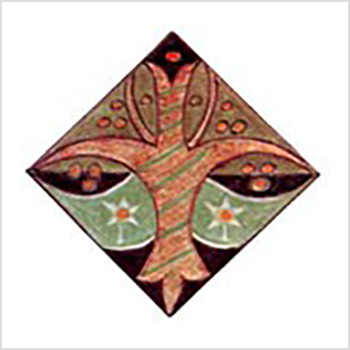
15. The House of Haleth device. This shows a tree of an unspecified order, a pair of white flowers, and a number of orange dots that might be stylized nuts or leafs. The Haladin in general were fond of solitude and forests, which might be indicated in this device.
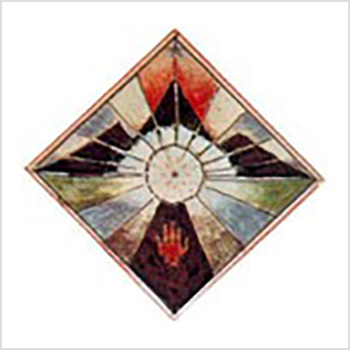
16. Beren device. In the centre is the Silmaril that Beren and Lúthien took from Morgoth. Above is the Thangorodrim, the three peaks of Angband. Below is a bloody hand. The device shows the vertical symmetry common for Men, broken only by the naturally assymetric hand.

17. Eärendil device. The centre depicts Silmaril radiating six light beams towards the edges. In the dark corners the (asymmetrical) moon in its phases is shown. This perhaps distinguishes him as being Half-elven. The six light rays are accompanied by six others, forming twelve "points", a clear relatedness with Idril's device (his mother), which is reinforced by the shared blue background of the two devices.
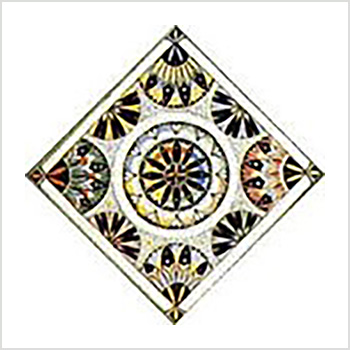
18. Heraldry of Númenor Eldarin heraldry was further developed in Númenor. Númenorean heraldry became increasingly elaborate and complex. The Great Seal and Device of Númenor resembles the device of Idril Celebrindal. At the centre is a cross and twelve-pointed floral motif signifying high kingship.
This pattern was used everywhere in Númenorean tapestry, heraldry and ornaments, including column capitals.

Måns Björkman in Emblems and Heraldry also provides representations of Middle-earth coats of arms which are reconstructed from the descriptions, (although as he states they should not be considered authorial), but they provide an indication of the imagery of Tolkien’s design from his words. A few are given as examples of this to complete this picture.
19. The House of the King (Turgon): had the emblems of “the moon and the sun and the scarlet heart" and their signifying colours were white, gold, and red, each doubtless connected with one of the emblems. Assuming the heart represented the heart of Turgon’s father, Fingolfin, and the sun is connected to the sun in the device of Finwe's house (his grandfather), and therefore given it the same number of rays.

20. The House of the White Wing: the bravest of the King's men wore swans' or gulls' wings on their helmets, and the device of their shields was a swan's wing on blue.1 view

21. The House of the Swallow. This house consisted of formidable archers, dressed in white, dark blue, purple and black. Their leader, Duilin, and their shields featured an arrowhead. The Swallow might be reminiscent of an arrow, flying speedily through the air and always finding its mark.

22. The House of the Golden Flower. Glorfindel led this house, whose device featured a rayed sun. The background colour based on the description of Glorfindel's clothing as reminding of "a field in spring".

Måns Björkman in Emblems and Heraldry also provided some fascinating designs of other images where no samples of any of the devices survived in their proper form; however, there exist vivid oral descriptions, and many pictorial clues regarding their design. Samples are provided of these as illustrations of Tolkien’s word-imagery. 22. The emblem of Elendil was seven five-pointed stars, each representing one of the palantíri that Elendil brought from Númenor. In Gondor they were set on a sable coat of arms, together with the White Tree, which represented any of the descendants of Nimloth that grew in Minas Ithil and, later, Minas Tirith.1 view

To this device the Kings of the line of Elendil added the Silver Crown, which was the chief mark of royalty. In Arnor a single five-pointed star became used as a device, the Elendilmir, representing the Star of Earendil. The crown of Gondor is depicted most clearly in letter 211 of Letters of Tolkien; the tree from that suggested by Tolkien for dustjacket for The Return of the King.
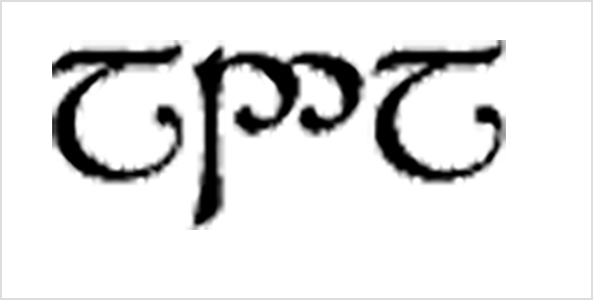
Elendil himself is reported to have used his name, written in tengwar without vowel marks, as "a badge and a device upon his seals." This badge was found on his tomb on Amon Anwar.1 view
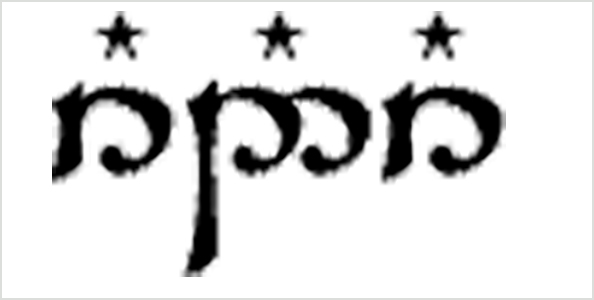
The Seal of the Stewards: The Stewards never took any heraldic device of their own, and their banners were white with no charge. The Seal of the Stewards, used by Cirion to summon the Éothéod, reportedly showed the letters "R · ND · R" for arandur ("steward"), surmounted by three stars.1 view

Of other races in Middle-earth, Emblems and Heraldry details the seals and heraldic emblems depicted by Tolkien, the most significant examples are provided
Gandalf used both a G-tengwa and a G-certh as his seals, though he seems to have preferred the certh.

It was the tengwa that the Hobbit-children identified when Gandalf arrived in Hobbiton, but both in Bree and on Weathertop he only used the certh.

Saruman's soldiers had helmets decorated with an S-certh.

Saruman's soldiers black shields also portrayed a small white hand in the middle. The white hand of Saruman appears in other places as well. The hand that is drawn here is based on Tolkien’s proposed dustjacket design for The Two Towers.
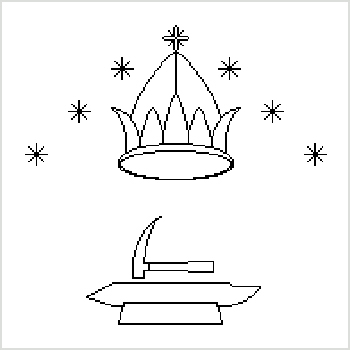
Dwarvish heraldic or emblematic customs is limited to a sole example: the carvings on the Doors of Durin, the west gate of Moria: the emblems of Durin the Deathless. They consisted of a hammer and an anvil, surmounted by a crown which was surrounded by seven stars. The stars represented the constellation of the Valacirca, or the Plough, which Durin saw above his head when he looked into the Kheled-zâram. The Dwarves were always associated with smithying, a tribute to their maker Aule the Smith of the Valar, which explains the hammer and anvil.

We know virtually nothing about Hobbit customs regarding emblems. We do know that they used logotypes, however: when Merry and Pippin investigated the wreck of Isengard, they found two barrels of pipeweed. Both were marked with "the Hornblower brandmarks" -- but we are not told what they looked like.1 view

When Morgoth slew Fingolfin, his shield was "sable unblazoned" and his armour was black.
Sauron's device echoes Morgoth's sable background. The Red Eye was his common symbol in the Third Age. It symbolizes his watching from the Dark Tower all over Middle-earth, especially after the One Ring. The eye drawn here is based on Tolkien’s dustjacket designs for The Lord of the Rings.

When Sauron overran Minas Ithil, the city acquired a new emblem. The emblem of Minas Morgul showed a moon "disfigured by a ghastly face of death", although the exact arrangement of the skull and the moon is difficult to tell. The moon was probably a remnant from before the takeover by Sauron: Minas Ithil means "Tower of the Moon".

2. Tiles and textiles
As told in the Silmarillion, Númenórean precious artifacts (tiles and textiles) were saved from the Downfall of Númenor and brought to Middle-earth.
This Númenórean tile was used as the centerpiece on the back cover of The Tolkien Calendar 1974 and The Silmarillion Calendar 1978.1 view

This Numenorean textile was published in The Silmarillion Calendar 1978.1 view

This Numenorean textile was published in The Silmarillion Calendar 1978.1 view

3. Runes and calligraphy
Tolkien drew this design, incorporating Elvish lettering, linking it to his Middle-earth writings on the back of an agenda for a meeting at Merton College, Oxford in 1957. It was not put on public display.1 view

Balin’s tomb
Tolkien uniquely developed a series of languages and systems of writing; these are illustrated in a number of epic scenes. Balin's Tomb runes were cut deeply into the covering slab, paraphrased; Balin Son of Fundin Lord of Mori.

Elvish scripts Demonstrating Tolkien’s remarkable linguistic creativity and fine calligraphy style, the following pages of elven script were reproduced in the Silmarillion Calendar 1978. (1) illustrates the different style: those and on the left are in ‘pointed style’, those of the right: ‘decorated verse-hand’.1 view

Elvish scripts (2)1 view

Elvish scripts (3)1 view

Ring verse/inscription The Ring-inscription was a Black Speech inscription in Tengwar upon The One Ring, symbolising its power to control the other Rings of Power.

Tolkien transcribed calligraphy1 view
![4. <i>Trees</i>
<br /><br />
Tolkien had a livelong and deeply felt love of trees. Inspired by many influences, eg Japanes engraving, cubism, ‘Arts and Craft’, he created stylised forest scenes as well as many decorative images of the ‘Tree of Amalion’, featuring stylised combinations of leaves, fruits and flowers. Trees are iconic symbols through Tolkien’s legends: “about [the trees’ fate] all the tales of Middle-Earth are woven”.
<br /><br />
<i>The Tree of Amalion</i>
<br /><br />
Tolkien regularly draw the Amalion tree, although the name does not appear in any of the stories of the legendarium, however, it is suggested it could relate to ‘blessed/good fortune’.
<br /><br />
Although recognizable as a living tree, it is more an expression of Tolkien’s imagination, uninterpreted as he did not provide an explanation featuring leaves, fruits and flowers. However, as Mechtild and others surmise, in its numerous renderings it is evocative of his literary journey through the roots of myth and imagination, with its many bounties.
<br /><br />
A version of the tree has been used as cover art for The Tree and Leaf.<span class="ngViews">1 view</span>](https://www.lotrarts.com/../images/gallery/showcase/jrr-tolkien/jrr-tolkien-art-vii-046.jpg)
4. Trees
Tolkien had a livelong and deeply felt love of trees. Inspired by many influences, eg Japanes engraving, cubism, ‘Arts and Craft’, he created stylised forest scenes as well as many decorative images of the ‘Tree of Amalion’, featuring stylised combinations of leaves, fruits and flowers. Trees are iconic symbols through Tolkien’s legends: “about [the trees’ fate] all the tales of Middle-Earth are woven”.
The Tree of Amalion
Tolkien regularly draw the Amalion tree, although the name does not appear in any of the stories of the legendarium, however, it is suggested it could relate to ‘blessed/good fortune’.
Although recognizable as a living tree, it is more an expression of Tolkien’s imagination, uninterpreted as he did not provide an explanation featuring leaves, fruits and flowers. However, as Mechtild and others surmise, in its numerous renderings it is evocative of his literary journey through the roots of myth and imagination, with its many bounties.
A version of the tree has been used as cover art for The Tree and Leaf.1 view

Tree (2)
A second version of the tree of Amalion.
This colorfully blossoming tree reportedly and 'fantasically' grows 40 different varieties of peaches, plums, apricots, nectarines, cherries, and even almonds.1 view
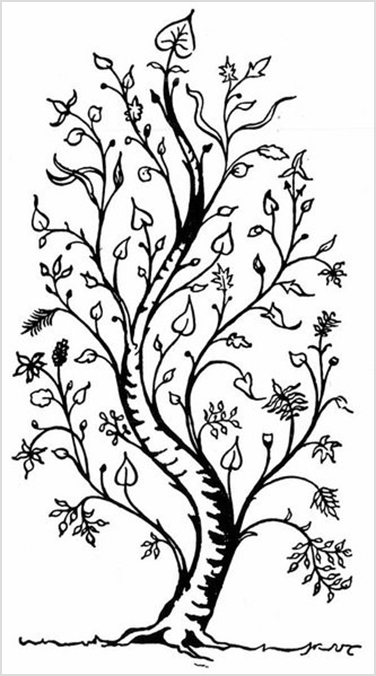
Tree (3)
Drawing in crayon of a tree with leaves.1 view

Tree (4)
Flowering Tree1 view

Laurelin and Telperion, The Trees of the Valor, from The Silmarillion1 view

Trees (5)
Wudu Wyrtum Faest (Grendel’s Mere)2 views

Tree (6)1 view

Tree frieze
'Flowering tree with friezes’
Derived from composition in 1920s.
Published in Tolkien Calendar 1979.1 view

Floral designs
Tolkien created many foral designs with delicate colour, others were similar in black ink of willowy rush or grass like plants, often bearing Elvish names.
Many were reproduced in the Tolkien Calendar 1979.1 view

“Grass in the wind
From the Bodleian Library special exhibition in 2018, Tolkien’s drawing of bamboo (Japanese-style) from the 1960s. Its Quenyan title ‘Linquë súrissë’.1 view

6. Dragons
Tolkien drew dragons in all styles and configurations.
Dragon (1) This painting, depicting a coiled dragon, cunning, malicious and seductive iron-scaled fire-breathing Great Worm, dates from September 1927.
It was reproduced in the Tolkien Calendar 1979 and on the cover of the De Luxe Hobbit edition (1976).1 view

Dragons (2)
Tolkien’s coloured painting of coiled and attacking dragons dates to around 1927.
Reproduced in Tolkien calendar 1979.1 view

Dragon (the Hobbit) (3)
Tolkien’s stylised inked Hobbit insignia.1 view

VIII) Life sketching
Tolkien was passionate about the English countryside, which he captured in charming and delicate sketches. He had been painting from life since boyhood. He was enthralled and inspired by nature, pastoral landscapes and settings, and rural architecture. His paintings expressed the joy he had on visits to Barnt Green and many countryside walks. These images inspired his creation of the landscape and ‘atmosphere’ of a Middle-earth.

1. 1911 sketch of Lamb's Farm, Gedling2 views

2. Ruins at West End of Whitby Abbey capturing the essence of architectural beauty despite a sense of abandonment, ruin and decay.3 views
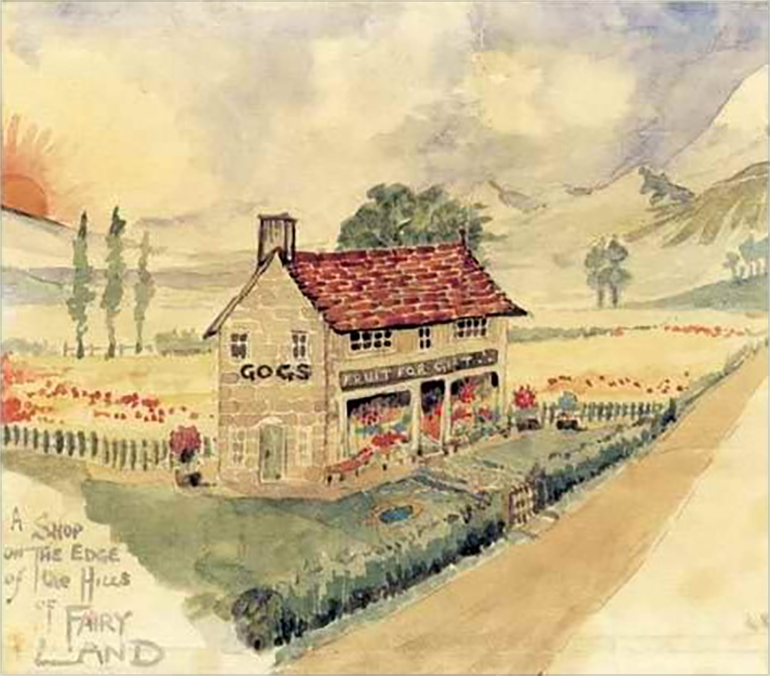
3. A shop on the edge of the hills of Fairy
This simple rustic water colour of a shop, named ‘Gogs’, has been suggested to relate to an unpublished children’s tale, The Orgog.1 view

4. High Life at Gipsy Green
Tolkien in 1918, while recovering from trench fever at Penkridge Camp, drew various charming scenes of his family’s life at Gipsy Green, titled High Life at Gipsy Green. This included a fish with the caption “The fish we couldn’t get at Swanwick’s”, presumably this humorous sketch created from the local Swanwick fishmongers.2 views
![5. <i>Foxglove Year </i>[1923]
<br/><br/>
A watercolour capturing the contrast of the warmth of filtered sunlight and the coolness of the shade, blue glimpses between the dark trees, the ground abounding with the colour of foxgloves. These is a sense of beauty, pleasure and vibrancy pervading the painting.<span class="ngViews">1 view</span>](https://www.lotrarts.com/../images/gallery/showcase/jrr-tolkien/jrr-tolkien-art-viii-005.jpg)
5. Foxglove Year [1923]
A watercolour capturing the contrast of the warmth of filtered sunlight and the coolness of the shade, blue glimpses between the dark trees, the ground abounding with the colour of foxgloves. These is a sense of beauty, pleasure and vibrancy pervading the painting.1 view
![6. <i>The Incledon's Cottage at Barnt Green</i> [1913]
<br/><br/>
Tolkien loved to visit Incledons, for the company and idyllic setting of their home. This watercolour of this setting and the sheer beauty of their garden reflects his positive and comforting mood.<span class="ngViews">1 view</span>](https://www.lotrarts.com/../images/gallery/showcase/jrr-tolkien/jrr-tolkien-art-viii-006.jpg)
6. The Incledon's Cottage at Barnt Green [1913]
Tolkien loved to visit Incledons, for the company and idyllic setting of their home. This watercolour of this setting and the sheer beauty of their garden reflects his positive and comforting mood.1 view
![7. <i>Spring</i> 1940 [pencil, coloured pencil]
<br/><br/>
Delicate imagery of a field, daffodils and tree blooming.<span class="ngViews">1 view</span>](https://www.lotrarts.com/../images/gallery/showcase/jrr-tolkien/jrr-tolkien-art-viii-007.jpg)
7. Spring 1940 [pencil, coloured pencil]
Delicate imagery of a field, daffodils and tree blooming.1 view
![8. <i>Tumble Hill </i> [1928]<span class="ngViews">1 view</span>](https://www.lotrarts.com/../images/gallery/showcase/jrr-tolkien/jrr-tolkien-art-viii-008.jpg)
8. Tumble Hill [1928]1 view

9. Caerthilian Cove and Lion Rock1 view

10. Cove Near the Lizard1 view

11. Alder by a Stream1 view

12. King’s Norton from Bilberry Hill1 view

13. Pheonix Farm, Gedling1 view

IX) Tolkien’s ‘personal/family’ art
Tolkien’s legendarium and artistry began with his childhood imaginings and later, the storytelling to his children. As this art shaped, and is integral to understanding, of what became his Middle-earth fantasy, it is presented here in all it whimsical glory.

1. Childhood illustration
Coded letter to Father Francis (Tolkien’s guardian after the death of his mother), when Tolkien was 12) Ink on paper from 1904.
Decoded (in J.R.R. Tolkien Pictures and by others) as: Woodside House, wood, S, eye, D, E, Cottage, Rednal cottage, red-N, A, L My dear wise owl Fr. Francis M, eye, deer, Y’s, owl, “Fr.”, France, hiss You are too bad U, R, 2, bee, A, D not to come in knot, 2, set, O, M, E, inn spite of Fr. Dennis. spit, E, “OF:, “Fr.”, D, hen, I, S I am so sorry you Hyam, sew, saw, rye… did not like the D, I, D, knot, L, -ike, tea, he word “piano” in my words, pea, note, inn, m, eye, last letter. So I… L –ast, letter, sow, eye.1 view

2. Children’s illustrations: Father Christmas
From the north pole to Middle-earth: Tolkien's Christmas letters to his children Bodleian library will exhibit (in 2018) Tolkien’s illustrated letters masquerading as Father Christmas. Tolkien sent his children charming, humorous and elaborately illustrated (with water colour sketches) shaky hand-written letters from Father Christmas for 23 years (from 1920 to 1942). These were collected in his book called Letters from Father Christmas.
b. Book cover.1 view

c. Original letter (1)1 view

Original letter (2)1 view

d. Further Father Christmas illustrations
Some have indicated that this Father Christmas myth building acted as a precursor for The Lord of the Rings, eg the 1933 letter features a battle between the Polar Bear and a band of goblins.
Overall however, it demonstrates Tolkien as a loving family man and wonderfully caring and creative father.1 view

Father Christmas illustration (3) 1 view

Father Christmas illustration (4)
The 1932 letter told how goblins had attempted to steal presents stored ready for Christmas.1 view
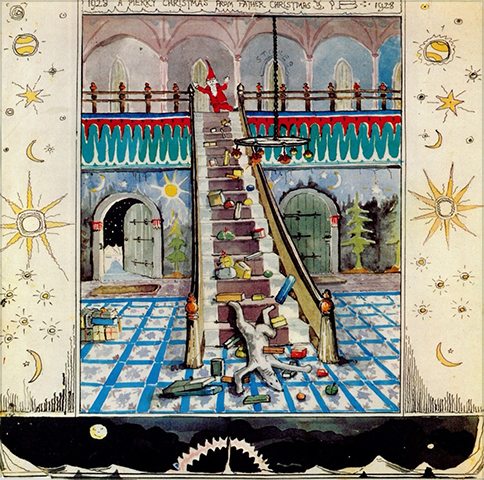
Polar Bear had fallen from top to bottom onto his nose
Painting of the interior of Cliff House at the North Pole, together with a letter describing the event, was delivered to Tolkien's children at Christmas 1928. Published in The
Father Christmas Letters, 1976, and again (with the decorative borders removed) in Tolkien Calendar 1979.1 view

In 1925 the letter explains how the polar bear has broken the North Pole, crashing it down on Father Christmas’s house.1 view

The beautiful image is of the Aurora Borealis fireworks that only Father Christmas could keep in his basement (extending preliminary doodle on newspaper).1 view
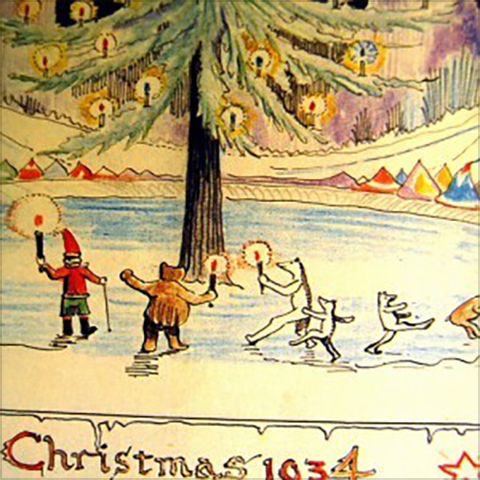
Father Christmas and North Polar Bear.1 view
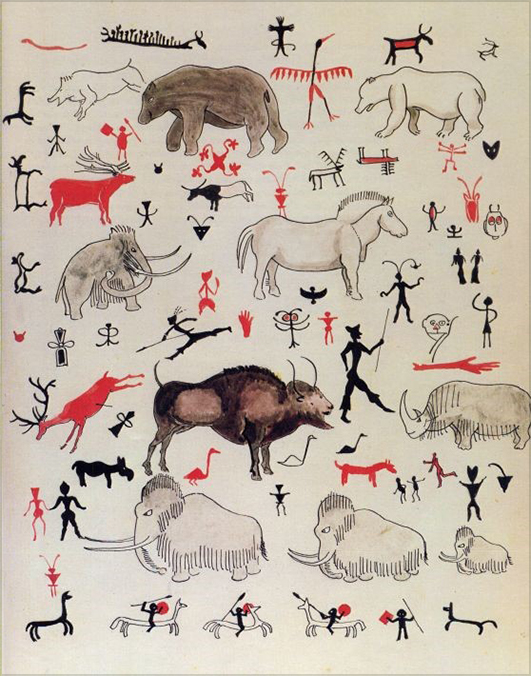
Cave drawings from the Father Christmas Letter of 1932.1 view

4. Roverandom
Tolkien’s 'Roverandom' (1925) a delightful children’s tale about the adventures of a young dog, Rover, magically turned into a toy by an irritable wizard. Rover travels to the moon and under the sea to find the wizard to return him to a real dog. In this he faces many fabulous and dangerous creatures. The book is filled with Tolkien’s charming illustrations.
The Gardens of the Merking's Palace One of Tolkien’s finest watercolours, a detailed and large scale painting created as an illustration for Roverandom. The beauty and level of imagery is breath-taking.2 views

Dust jacket featuring The Gardens of the Merking's Palace1 view

House where Rover began his adventures as a toy.1 view

Roverandom Goes To The Moon1 view
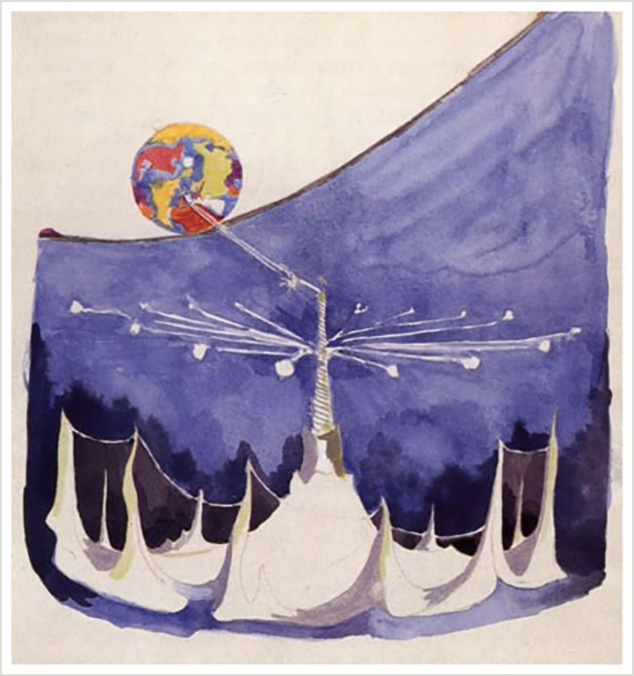
Man in the Moon2 views

Lunar Landscape (Roverandom)1 view
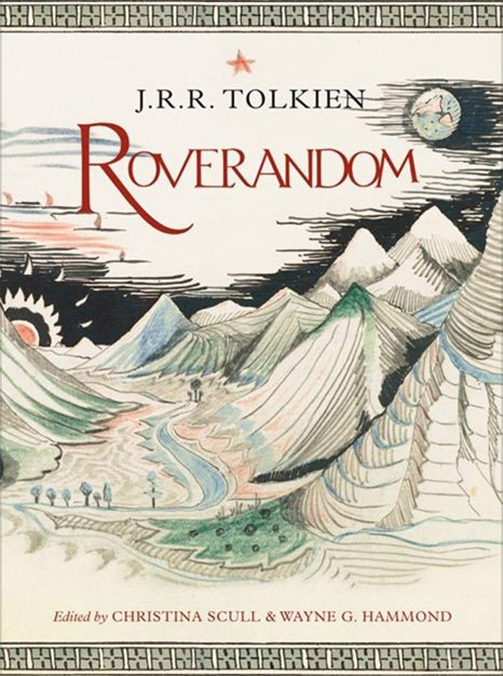
Lunar Landscape (Roverandom dust-jacket)1 view

links under construction
I believe it could be argued that Alan Lee’s drawings and paintings of Middle-earth have succeeded remarkably well in bringing to life the images envisioned in the words of J.R.R. Tolkien and I can’t think of a better compliment for any artist to receive.
Acknowledgements: The following websites were indispensible in the composition of this article. I would like to take the time to express my sincere gratitude to everyone responsible for the existence of these websites.
Without the information and images I was able to gather from these websites, this article would not have been possible
For Biographical Information:
1. Wikipedia.org
✦
2. Tolkiengateway.net
✦
3. Councilofelrond.com
✦
4. Ashsilverlock.com
✦
5. BBC.co.uk
✦
Calendar Information And Images:
6. “The Complete Gyde To Tolkien Calendars” - Tolkiencalendars.com
✦
7. The Tolkien Calendar 1993: Tolkiengateway.net: The_Tolkien_Calendar_1993
✦
8. Tolkiengateway.net: The_1993_J.R.R._Tolkien_Calendar
✦
9. The Tolkien Calendar 2008 (The Children of Hurin) - Dana-mad.ru
✦
10. The Tolkien Calendar 2007 - Dana-mad.ru
✦ Houghton Mifflin:
11. The Complete Houghton Mifflin J.R.R. Tolkien Catalog - Houghtonmifflinbooks.com
✦ Harper Collins:
12. Tolkien – The Official Online Bookstore - Tolkien.co.uk
✦
Images For Alan Lee’s Tolkien Art:
13. Google.com
✧
14. Pinterest.com
✧
15. Tolkien Gateway - Tolkiengateway.net
✦
16. Welcome To The Art Gallery(Alan Lee) - Dana-mad.ru
✦
17. The Hobbit - Dana-mad.ru
✦
18. The Lord of the Rings - Dana-mad.ru
✦
19. The Children of Hurin - Dana-mad.ru
✦
20. The Lord of the Rings Sketchbook - Dana-mad.ru
✦

links under construction
Middle-earth art references
1. 'J.R.R. Tolkien: Artist and Illustrator', Wayne G. Hammond (ed.), Christina Scull (ed.), J.R.R. Tolkien (Illustrator), 2000
2. 'Pictures by J.R.R. Tolkien', Christopher Tolkien (author), J.R.R. Tolkien (illustrator), 1992
3. 'The Art of The Lord of the Rings', Wayne G. Hammond (ed.), Christina Scull (ed.), 2015
4. 'The Letters of J.R.R. Tolkien', Humphrey Carpenter (ed.) 1981
Internet references
5. 110 Drawings and Paintings by J.R.R. Tolkien: Of Middle-Earth and Beyond,
✧
6. A code letter sent to Father Francis Xavier Morgan, Alli Hobbs
✦
7. A few words about John Ronald Ruel Tolkien
✦
8. All This Is That, J.R.R. Tolkien watercolor of Rivendell, 2013
✦
9. Cave Drawings from the Father Christmas Letter of 1932, helene,
✦
10. Christmas cards JRR Tolkien, Peteski,
✦
11. Christmas With J.R.R. Tolkien: The Father Christmas Letters, Brenton Dickieson, 2016
✦
12. Discover J.R.R. Tolkien’s Personal Book Cover Designs for The Lord of the Rings Trilogy
✧
13. Dust-jacket design for The Hobbit,
✦
14. Emblems and Heraldry, Måns Björkman, 2000
✦
15. For the Anniversary of March 25: jan-u-wine's 'Upon the Tol', with art by J. R. R. Tolkien., 2013
✦
16. Gates of Moria,
✦
17. Gedling,
✦
18. Happy Birthday, J.R.R. Tolkien: The Iconic Storyteller’s Little-Known, Gorgeous Art,
✧
19. Happy Birthday Bagginses 2017, with jan-u-wine’s ‘A Birth Day for Heroes’, art by J. R. R. Tolkien,
✦
20. Illustrations from The Hobbit by J.R.R. Tolkien, derovh,
✦
21. Illustrations of J.R.R. Tolkien, 5 Laketown, squire, 2007
✧
22. Isengard, Elaine Haygood
✦
23. Jan. 3, 2013 ~ Happy 121st birthday, Professor Tolkien, 2013,
✦
24. JRR Tolkien Afterwards, Nick Nicolaou
✦
25. J.R.R. Tolkien - End of the World
✧
26. J.R.R. Tolkien - Heraldic Devices
✧
27. JRR Tolkien – Mandalic Scene, Virginia Lundberg
✦
28. JRR Tolkien's Illustrations, arielseabright
✦
29. J.R.R. Tolkien’s Little-Known, Gorgeous Art, Maria Popova,
✦
30. J.R.R. Tolkien’s Magnificent Original Drawings for The Lord of The Rings, The Hobbit and More, Ruchita Bamane, 2016,
✧
31. J.R.R. Tolkien’s Nover-Before-Seen Middle-earth drawings, Joey Paur, 2012
✦
32. jrr-tolkiens-destitute-mom-gave-him-one-hell-education
✦
33. J.R.R. Tolkien: The Painter (The tales that follow)
✦
34. Letters from Father Christmas by J.R.R. Tolkien, Tygertale, 2012
✦
35. Major exhibition in 2018 to explore JRR Tolkien's vast creative genius
✦
36. Major exhibition in 2018 to explore JRR Tolkien's vast creative genius
✦
37. Mechtild's: A Sanctuary for Tolkien Fanatics Who Aren't Ready to be Cured
✦
38. Middle-earth heraldry,
✦ http://wiki.lindefirion.net/Heraldry
39. Minas Tirith,
✦
40. Original illustration to The Hobbit, Conversation with Smaug, Pieter Collier, 2011
✦
41. Orthanc (1) - J.R.R. Tolkien,
✧
42. Orthanc (2), 3, (4), Kenneth Anthony,
✦
43. Orthanc, Elanie Haygood,
✦
44. Pictures by JRR Tolkien, Leonardo Rosati ‘webpublisher’, 2012
✦
45. Previously-Unseen ‘The Hobbit’ Drawings By J.R.R Tolkien, Dorothy Tan, 2013
✦
46. Professor Tolkien’s Vision of The Dark Tower Of Mordor, 2015,
✧
47. Roverandom, Bonnie Fitch, 2009
✦
48. Roverandom, 2013,
✦
49. Roverandom Goes To The Moon, Blue-Dragon22, 2009,
✦
50. See the sketches J.R.R. Tolkien used to build Middle-earth,
✦
51. Smaug Flies Round the Mountain — An Illustration by J.R.R. Tolkien, Biblioklept, 2011,
✦
52. Speak friend and enter!
✦
53. The art of J.R.R. Tolkien, Kenneth Anthony
✦
54. The author of 'The Lord of the Rings' is Father Christmas 23 years, 2017,
✦
55. The idle doodles of JRR Tolkien
✦
56. The Magical Art Of J.R.R. Tolkien, Paul Sorene, 2016
✦
57. The mysteries of watercolor painting (25) - Tolkien as a watercolor painter - about his own illustrations for his epic fantasies, Peter Harms Larsen, 2013,
✦
58. The Red Book and the Red Book: Jung, Tolkien, and the Convergence of Images, Becca S. Tarnas, 2014
✦
59. The Tolkien Gateway's gallery of over 100 images by Tolkien, multiple images,
✧
60. The visual impetus and the writings of J.R.R. Tolkien, Robert S. Garbacz, 2006
✦
61. Tolkien Archives Field Trip, Valdis, 2014,
✧
62. Tolkien as Artist and Writer, Anna Smol, 2018,
✦
63. Tolkien - Before, Whitaker Rehm
✦
64. Tolkien: Maker of Middle-earth, 1 June-28 October 2018, Weston Library
✦
65. Tolkien the Artist (Tolkien Tuesday – the Hill in Hobbiton)
✧
66. Tolkien and Swanwick’s fishmongers, David King and Morgan Thomsen, 2014
✦
67. Tolkien's Art, Christina Scull and Wayne G. Hammond
✦
68. Tolkien's Art and Illustrations, 2017
✦
69. Tolkien's black pine: Why do we love old trees?
✦
70. Tolkien's Landscapes 1: 'The Tree of Amalion' ~ pictures by Tolkien, poem by jan-u-wine, 2013,
✦
71. Tolkien's Landscapes 2: 'Foxglove Year'~ picture by Tolkien, poem by jan-u-wine, 2013,
✦
72. Landscapes 3: 'Moonlight
✦
73. Tolkien's Landscapes 5: 'The Misty Mountains' ~ picture by Tolkien, poem by jan-u-wine, 2018,
✦
74. Tolkien's Landscapes 6: 'Wood at the World's End'~ picture by Tolkien, poem by jan-u-wine.
✦
75. Tolkien’s Lord of the Rings sketches can be yours, Trilby Beresford, 2015,
✦
76. Tolkien’s Trees and Landscapes, Todd Powerlson, 2016
✦
77. Trees
✦
78. Unpublished art by Lord of the Rings creator JRR Tolkien goes
✦
79. Was Tolkien jealous of Charles Williams friendship with Lewis? Certainly NOT, Bruce Charlton, 2012,
✦
80. What a Colorful Pair!, priyaseth1, 2017
✦
81. What does Minas Tirith actually look like according to Tolkien?, Stephen Tempest,
✦
82. What Is Fair Use?
✦
83. Why Tolkien was a fine modern artist, Jonathan Jones
✦
84. Works inspired by J. R. R. Tolkien
✦
Tolkien photographs
85. J.R.R. Tolkien
✦
86. J.R.R. Tolkien, A. Renard
✦
87. J.R.R. Tolkien - An Illustrated Bibliography
✦
88. J.R.R. Tolkien book published after 100 years, Elizabeth Grenier, 2017
✦
89. J.R.R. Tolkien's Destitute Mom Gave Him One Hell of an Education, Jon Miltimore, 2017
✦
90. Jan. 3, 2014 ~ Happy 122nd Birthday, Professor, with poem by jan-u-wine,
✦
91. Happy 126th birthday J. R. R. Tolkien, with poem by jan-u-wine.
✦
92. Middle-earth news
✦
93. No, Ireland did not inspire Tolkien’s Lord of the Rings, 2015
✦
94. Ronald and Edith Tolkien
✦
95. Tolkien
✦
96. When Tolkien worked for Oxford…
✦
97. Why peter Jackson will never film the Silmarillion, Olga Hughes, 2013
✦
98. 1937 Signed, First Edition "The Hobbit" & Dust Jacket
✦
99. Marquette purchases rare first edition, first printing of "The Hobbit"
✦